Paul van Yperen's Blog, page 64
December 26, 2023
Verlag Hermann Leiser (3)
In our third post about Verlag Hermann Leiser, a Berlin publishing house that was active around the 1910s, we focus today on the numbers 4001 - 6000. Jean Ritsma of the website Ross Postcards made a catalogue of the Leiser star postcards. In a series of posts, we will present you this week our selection of our favourite Leiser postcards.
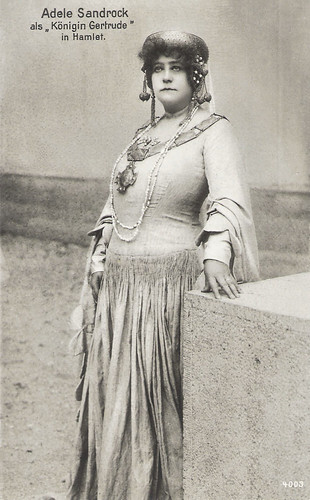
German Postcard by Verl. Hermann Leiser, Berlin, no. 4003. Photo: Photo-Arbeit, München (Munich). Adele Sandrock as Queen Gertrude in a stage production of 'Hamlet'.
Grand German-Dutch actress Adele Sandrock (1863-1937) had a successful theatrical career all over Europe. In Vienna, she had a stormy affair with the famous playwright Arthur Schnitzler and enjoyed triumphs as the diva of the modern playwrights. In the 1910s she became one of the first German film stars. After the introduction of sound, she emerged as a witty comedienne. She excelled as the intimidating elderly dragon, who could also be surprisingly funny and tactful.
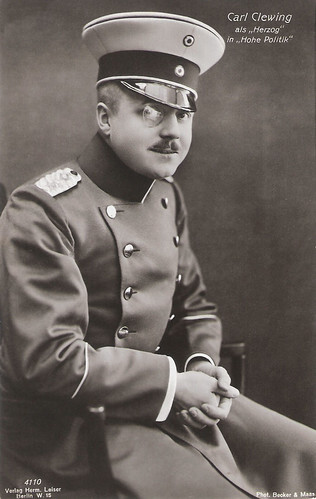
German postcard by Verlag Hermann Leiser, Berlin-Wilm., no. 4110. Photo: Becker & Maass. Carl Clewing in the stage play 'Hohe Politik' (High Politics) by Julius Rosen.
German actor Carl Clewing (1884-1954) was an opera singer, the composer of the song 'Alle Tage ist kein Sonntag' (Not every day is a Sunday) and a Music professor in Berlin During the years of the early cinema he was much in demand as a film actor.
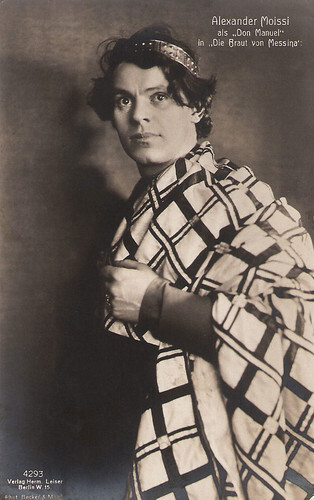
German postcard by Verlag Hermann Leiser, Berlin-W, no. 4293. Photo: Becker & Maass. Alexander Moissi as Don Manuel in a stage production of 'Die Braut von Messina' (The Bride of Messina) by Friedrich Schiller.
Albanian-Austrian Alexander Moissi (1879-1935), born as Aleksandër Moisiu, was one of the great European stage actors of the early 20th century. The attractive and charismatic women's idol also appeared in several silent and early sound films.
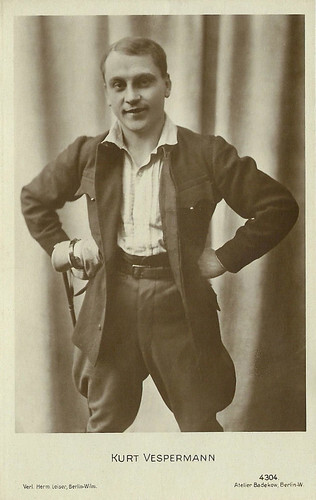
German postcard by Verlag Hermann Leiser, Berlin-Wilm., no. 4304. Photo: Atelier Badekow, Berlin-W. Collection: Didier Hanson.
German character actor Kurt Vespermann (1887-1957) was active in nearly 200 films between 1915 and 1957.
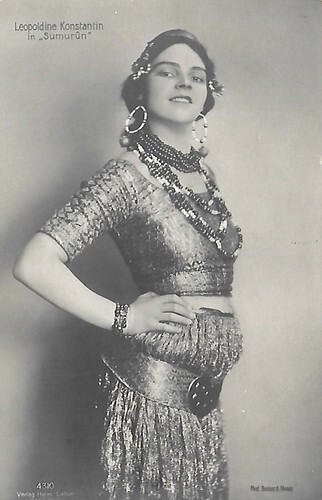
German postcard by Verlag Hermann Leiser, no. 4310. Photo: Becker & Maass. Leopoldine Konstantin in Sumurûn (Max Reinhardt, 1910). Collection: Didier Hanson.
Leopoldine Konstantin (1886-1965) was a famous Austrian theatre and film character actress, who worked for years with director Max Reinhardt. She played Claude Rains' dominant mother in Alfred Hitchcock’s classic Notorious (1946). It was her sole Hollywood role.
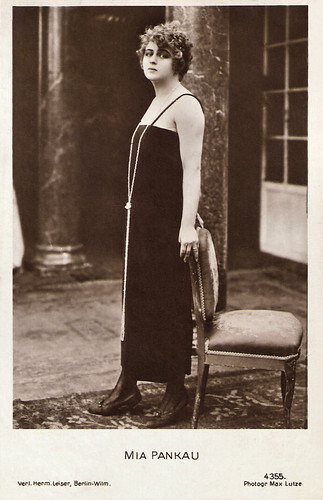
German postcard by Verlag Hermann Leiser, Berlin-Wilm., no. 4355. Photo: Max Lutze.
Mia Pankau (1891-1974) was a German actress of the silent cinema. Most of her films were directed by her husband, Jaap Speyer.
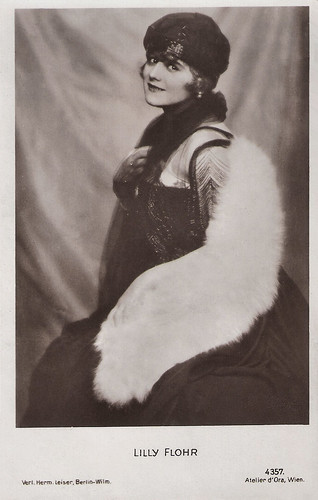
German postcard by Verlag Hermann Leiser, Berlin-Wilm., no. 4357. Photo: Atelier d'Ora, Wien.
Austrian film star Lilly Flohr (1893-1978) was a busy actress, soubrette, cabaret artist and chanson singer on stage. From 1918 on she starred in 25 silent films.
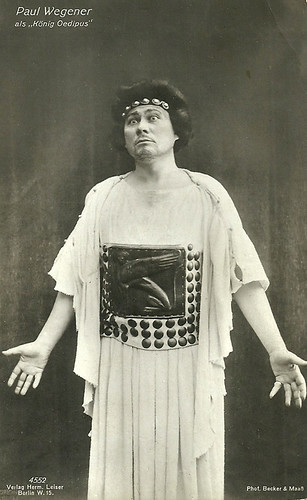
German postcard by Verlag Hermann Leiser, Berlin, no. 4552. Photo: Becker & Maass. Caption: Paul Wegener as King Oedipus in 'Oedipus Rex' (1910), directed by Max Reinhardt.
'Oedipus Rex', Sophocles's classic tragedy, directed by Max Reinhardt in a translation by Hugo von Hofmannsthal, was first performed in 1910 at a Summer festival in Munich and in the Fall in a circus arena in Berlin. Stars were Paul Wegener as Oedipus and Tilla Durieux as Jocasta, though some considered the masses of extras performing the Thebans to be the real stars. Emily Bilski writes in 'Berlin Metropolis: Jews and the New Culture, 1890-1918': "Oedipus was the first major theatre-in-the-round production in modern times that featured masses of actors performing for a mass audience."
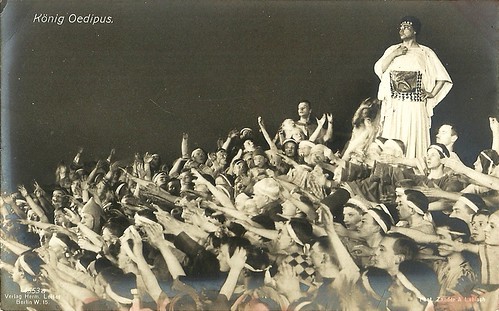
German postcard by Verlag Hermann Leiser, Berlin-W., no. 4553 a. Photo: Zander & Labisch, Berlin. Paul Wegener in 'König Oedipus' (1910). Caption: King Oedipus.
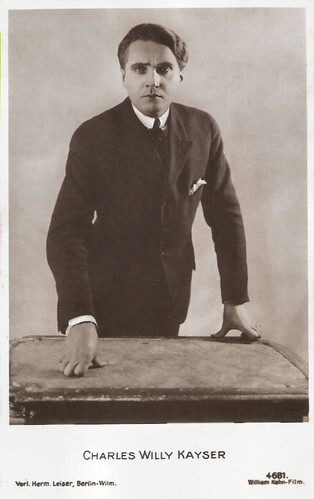
German postcard by Verlag Hermann Leiser, Berlin-Wilm., no. 4681. Photo: William Kahn-Film. Charles Willy Kayser in Dämon der Welt. 1. Das Schicksal des Edgar Morton/Demon of the world, part 1: The Fate of Edgar Morton (Rudolf Del Zopp, Siegfried Dessauer, 1919).
German actor Charles Willy Kayser (1881-1942) had a remarkable career in the silent cinema. However, today he is little known, while many of his films are considered lost now and there is little information about his work.
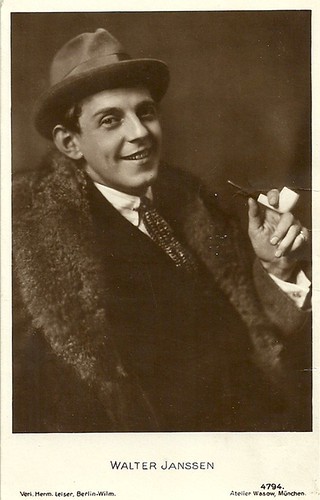
German postcard by Verlag Hermann Leiser, Berlin, no. 4794. Photo: Atelier Wasow, München.
Walter Janssen (1887-1976), originally Walter Philipp Janßen, was a German stage and screen actor and film director. Between the late 1910s and the late 1950s, Walter Janssen had a very prolific acting career in German cinema.
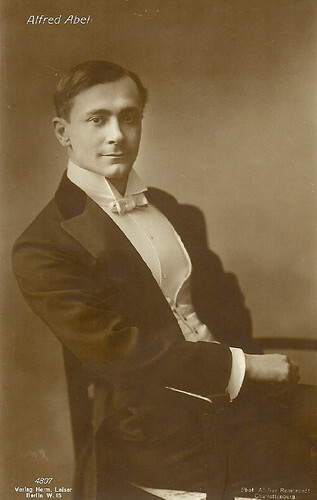
German postcard by Verlag Hermann Leiser, no. 4807. Photo: Atelier Rembrandt, Charlottenburg. Collection: Didier Hanson.
Alfred Abel (1879-1937), best known as the industrial Fredersen in Fritz Lang's Metropolis, played in over 140 silent and sound films between 1913 and 1938.
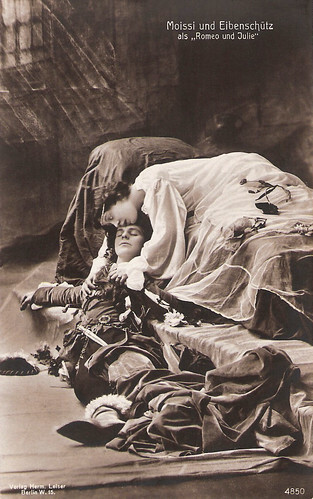
German postcard by Verlag Hermann Leiser, Berlin-W., no. 4850. Photo: Alexander Moissi and Camilla Eibenschütz in a 1907 production of the stage play 'Romeo und Julie' (Romeo and Juliet) by William Shakespeare.
Albanian-Austrian Alexander Moissi (1879-1935) was one of the great European stage actors of the early 20th century. The attractive and charismatic women's idol also appeared in several silent and early sound films.
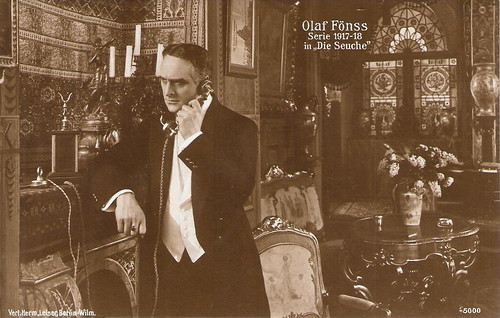
German postcard by Verlag Hermann Leiser, Berlin-Wilmersdorf, no. 5000. Olaf Fønss in the Danish film Laegen/Pesten (Fritz Rasmussen, 1917). The German title was Die Seuche (The Plague). The film was written and directed by Fritz Rasmussen for Dansk Film Co. and released in Denmark in 1918.
Olaf Fønss (1882-1949) was one of Denmark and Germany's biggest stars of the silent film era. He also worked as a film director, producer and censor.
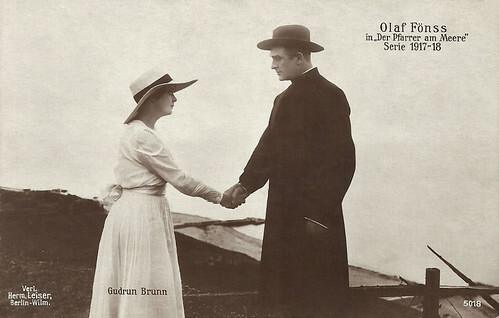
German postcard by Verlag Hermann Leiser, Berlin, no. 5018. Olaf Fønss and Gudrun Brunn in the Danish film Praesten fra havet (Fritz Magnussen 1918), released in Germany as Der Pfarrer am Meer (The Priest at the Sea).
Olaf Fønss (1882-1949) was one of Denmark and Germany's biggest stars of the silent film era. He also worked as a film director, producer and censor.
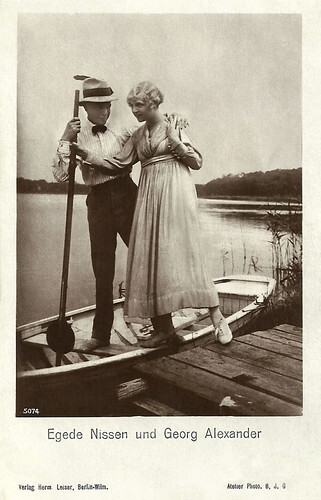
German postcard by Verlag Hermann Leiser, Berlin, no. 5074. Photo: Atelier B.J.G. Aud or Gerd Egede-Nissen and Georg Alexander .
Aud Egede Nissen and Georg Alexander played in many films together in the 1910s and were married from 1915 to 1924. Norwegian film actress Aud Egede-Nissen (1893-1974) was a star of the German silent cinema. In the 1910s, she produced dozens of her own films. In the 1930s she returned to Norway, where she appeared in some films and acted mainly on stage.
Georg Alexander (1888-1945) was a German actor, director and producer. He belongs to the busiest actors and his career continued smoothly till his death.
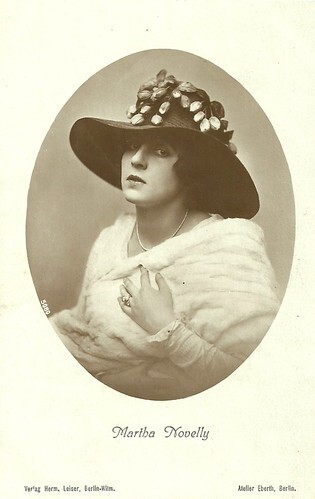
German postcard by Verlag Hermann Leiser, Berlin-Wilm., no. 5080. Photo: Atelier Eberth, Berlin.
Martha Novelly (1889-1972) was a German stage and screen actress who peaked in German silent films of the late 1910s.
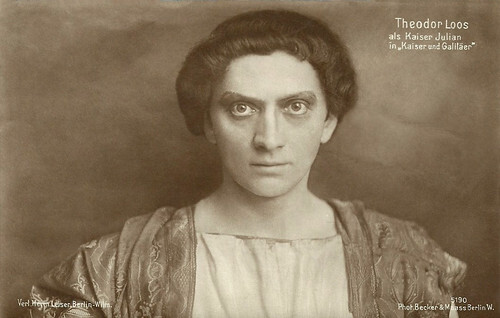
German postcard by Verlag Hermann Leiser, Berlin-Wilm., no. 5190. Photo: Becker & Maass, Berlin. Theodor Loos as Emperor Julian in the play 'Kaiser und Galiläer' (Emperor and Galilean) by Henrik Ibsen.
Theodor Loos (1883-1954) was a German stage and screen actor between the 1910s and the 1950s. He became famous for his parts in Fritz Lang’s German films.
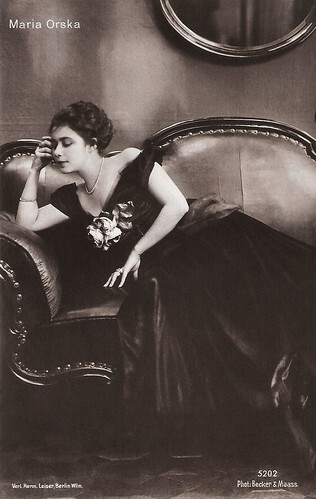
German postcard by Verlag Hermann Leiser, Berlin-Wilm., no. 5202. Photo: Becker & Maass.
Maria Orska (1893-1930) was a Russian-Jewish actress on the German stage and screen in the 1910s and 1920s.
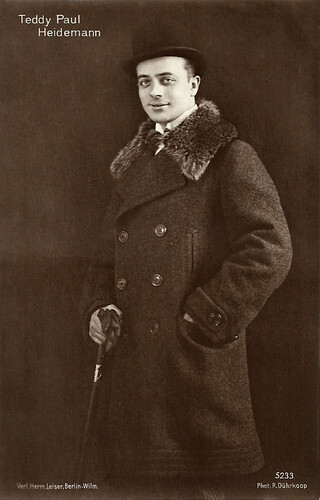
German postcard by Verlag Hermann Leiser, Berlin-Wilm., no. 5233. Photo: R. Dührkoop.
Paul Heidemann (1884-1968) was a German stage and screen actor, and also a film director and producer. In the silent period, he was famous for his comical parts.
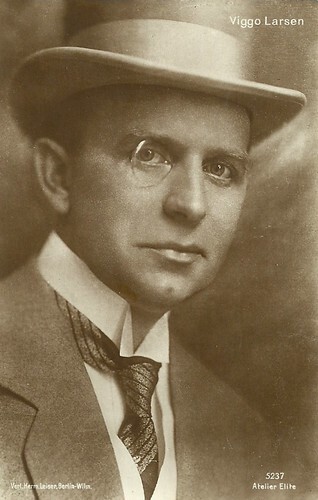
German postcard by Verlag Hermann Leiser, Berlin-Wilm., no. 5237. Photo: Atelier Elite.
Viggo Larsen (1880-1957) was a Danish actor, director, scriptwriter and producer. He was one of the pioneers in film history. With Wanda Treumann he directed and produced many German films of the 1910s.
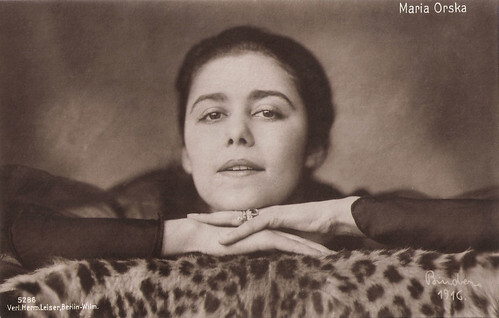
German postcard by Verlag Hermann Leiser, Berlin-Wilm., no. 5286. Photo: Alex Binder, 1916.
Maria Orska (1893-1930) was a Russian-Jewish actress on the German stage and screen in the 1910s and 1920s.
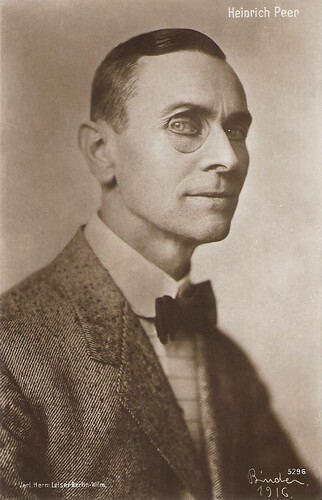
German postcard by Verlag Hermann Leiser, Berlin. no. 5296. Photo: Alex Binder, Berlin, 1916.
Austrian stage and film actor Heinrich Peer (1867–1927) belonged to the pioneers of German cinema and appeared in more than a hundred films between 1911 and 1927. The tall, thin actor with the distinctive, almost sinister face often played supporting parts in adventure and detective films but also played in melodramas and historical films.
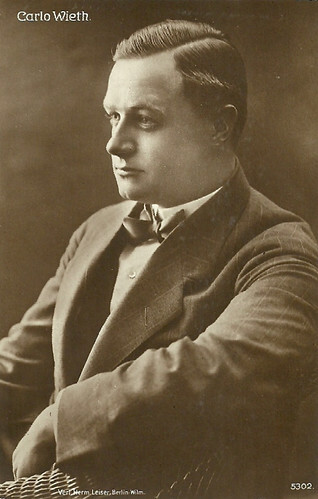
German postcard by Verlag Hermann Leiser, Berlin-Wilm., no. 5302.
Carlo Wieth (1885-1943) was a Danish actor, who starred in Danish and Swedish silent cinema of the 1910s and early 1920s, often paired with his then-wife Clara (Pontoppidan) Wieth.
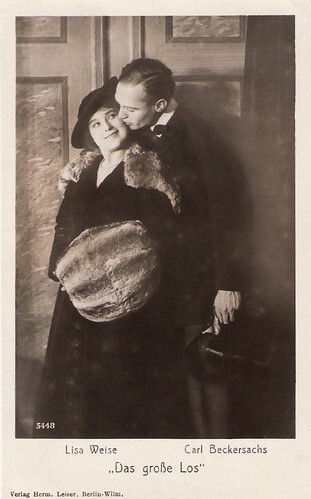
German postcard by Verlag Hermann Leiser, Berlin-Wilm., no. 5448. Photo: Lisa Weise and Karl Beckersachs in Das grosse Los/The Big Prize (Friedrich Zelnik, 1917).
German actress Lisa Weise (?-1952) starred in silent films of the 1910s. Most of her films were directed by Friedrich Zelnik and often her film partner was Karl Beckersachs .
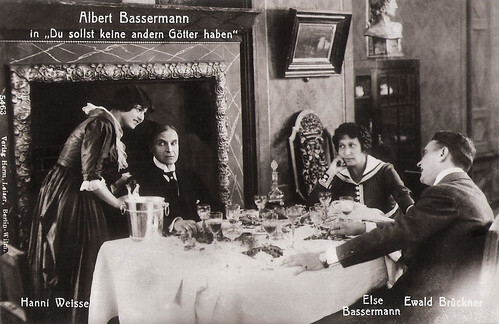
German postcard by Verlag Hermann Leiser, Berlin-Wilm., no. 5463. Photo: Albert Bassermann , Hanni Weisse , Else Bassermann and Ewald Brückner in Du sollst keine anderen Götter haben/Thou shalt have no other gods (Adolf Gärtner, 1917).
Albert Bassermann (1867–1952) was one of the first great German stage actors who worked for the cinema. In 1933 he fled the Nazi regime and became an Oscar-nominated stage and film actor in the US.
German actress Hanni Weisse (1892-1967) belonged to the great film divas of the early German silent film. She was able to maintain her stardom till the 1920s.
Else Bassermann , née Elisabeth Sara Schiff (1878-1961) was a German stage and screen actress, who in 1908 married renowned stage actor Albert Bassermann and often performed together with him on stage. When he started to play in the film, she accompanied him.
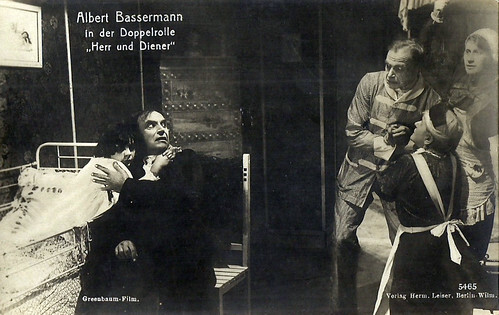
German postcard by Verlag Hermann Leiser, Berlin, no. 5465. Photo: Greenbaum-Film. Albert Bassermann in a dual role in the German silent film Herr und Diener/Master and Servant (Adolf Gärtner, 1917).
A reputed professor ( Albert Bassermann ) hires a servant (Bassermann) for a world trip. The servant is his spitting image. When the professor is lamed, the servant trades places with him. Nobody discovers the fraud, till one day the professor's maid ( Else Bassermann ) unmasks the culprit. The script was written by Else Basssermann under the pseudonym of Hans Hennings. On this postcard, Else Bassermann can be seen on the extreme right.
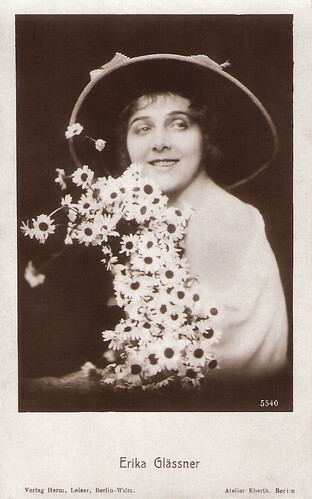
German postcard by Hermann Leiser, Berlin-Wilm, no. 5540. Photo: Atelier Eberth, Berlin.
Cute actress Erika Glässner (1890-1959) starred as a backfisch and later as a cheeky temptress in many German films of the silent era. From 1915 till 1952 she appeared in some 80 films.
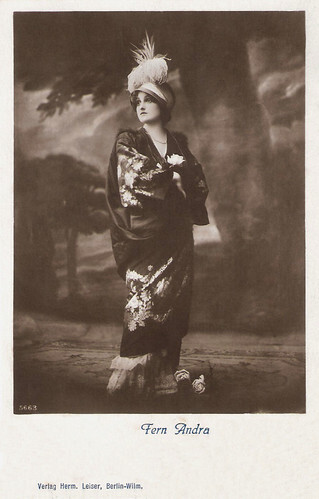
German postcard by Verlag Hermann Leiser, Berlin, no. 5663.
'Modern' American actress Fern Andra (1893-1974) became one of the most popular film stars of the German cinema in the 1910s and early 1920s. In her films, she mastered tight roping, riding a horse without a saddle, driving cars and motorcycles, bobsleighing, and even boxing.
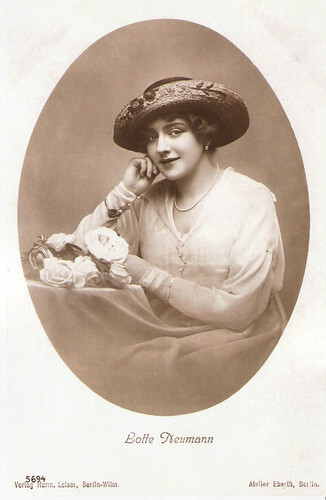
German postcard by Verlag Hermann Leiser, Berlin-Wilm., no. 5694. Photo: Atelier Eberth, Berlin.
Lotte Neumann (1896-1977) was one of the most successful actresses in the early days of the German silent cinema. She also worked as a screenwriter and producer.
To be continued tomorrow!
Source: Jean Ritsema (Ross Postcards).

German Postcard by Verl. Hermann Leiser, Berlin, no. 4003. Photo: Photo-Arbeit, München (Munich). Adele Sandrock as Queen Gertrude in a stage production of 'Hamlet'.
Grand German-Dutch actress Adele Sandrock (1863-1937) had a successful theatrical career all over Europe. In Vienna, she had a stormy affair with the famous playwright Arthur Schnitzler and enjoyed triumphs as the diva of the modern playwrights. In the 1910s she became one of the first German film stars. After the introduction of sound, she emerged as a witty comedienne. She excelled as the intimidating elderly dragon, who could also be surprisingly funny and tactful.

German postcard by Verlag Hermann Leiser, Berlin-Wilm., no. 4110. Photo: Becker & Maass. Carl Clewing in the stage play 'Hohe Politik' (High Politics) by Julius Rosen.
German actor Carl Clewing (1884-1954) was an opera singer, the composer of the song 'Alle Tage ist kein Sonntag' (Not every day is a Sunday) and a Music professor in Berlin During the years of the early cinema he was much in demand as a film actor.

German postcard by Verlag Hermann Leiser, Berlin-W, no. 4293. Photo: Becker & Maass. Alexander Moissi as Don Manuel in a stage production of 'Die Braut von Messina' (The Bride of Messina) by Friedrich Schiller.
Albanian-Austrian Alexander Moissi (1879-1935), born as Aleksandër Moisiu, was one of the great European stage actors of the early 20th century. The attractive and charismatic women's idol also appeared in several silent and early sound films.

German postcard by Verlag Hermann Leiser, Berlin-Wilm., no. 4304. Photo: Atelier Badekow, Berlin-W. Collection: Didier Hanson.
German character actor Kurt Vespermann (1887-1957) was active in nearly 200 films between 1915 and 1957.

German postcard by Verlag Hermann Leiser, no. 4310. Photo: Becker & Maass. Leopoldine Konstantin in Sumurûn (Max Reinhardt, 1910). Collection: Didier Hanson.
Leopoldine Konstantin (1886-1965) was a famous Austrian theatre and film character actress, who worked for years with director Max Reinhardt. She played Claude Rains' dominant mother in Alfred Hitchcock’s classic Notorious (1946). It was her sole Hollywood role.

German postcard by Verlag Hermann Leiser, Berlin-Wilm., no. 4355. Photo: Max Lutze.
Mia Pankau (1891-1974) was a German actress of the silent cinema. Most of her films were directed by her husband, Jaap Speyer.

German postcard by Verlag Hermann Leiser, Berlin-Wilm., no. 4357. Photo: Atelier d'Ora, Wien.
Austrian film star Lilly Flohr (1893-1978) was a busy actress, soubrette, cabaret artist and chanson singer on stage. From 1918 on she starred in 25 silent films.

German postcard by Verlag Hermann Leiser, Berlin, no. 4552. Photo: Becker & Maass. Caption: Paul Wegener as King Oedipus in 'Oedipus Rex' (1910), directed by Max Reinhardt.
'Oedipus Rex', Sophocles's classic tragedy, directed by Max Reinhardt in a translation by Hugo von Hofmannsthal, was first performed in 1910 at a Summer festival in Munich and in the Fall in a circus arena in Berlin. Stars were Paul Wegener as Oedipus and Tilla Durieux as Jocasta, though some considered the masses of extras performing the Thebans to be the real stars. Emily Bilski writes in 'Berlin Metropolis: Jews and the New Culture, 1890-1918': "Oedipus was the first major theatre-in-the-round production in modern times that featured masses of actors performing for a mass audience."

German postcard by Verlag Hermann Leiser, Berlin-W., no. 4553 a. Photo: Zander & Labisch, Berlin. Paul Wegener in 'König Oedipus' (1910). Caption: King Oedipus.

German postcard by Verlag Hermann Leiser, Berlin-Wilm., no. 4681. Photo: William Kahn-Film. Charles Willy Kayser in Dämon der Welt. 1. Das Schicksal des Edgar Morton/Demon of the world, part 1: The Fate of Edgar Morton (Rudolf Del Zopp, Siegfried Dessauer, 1919).
German actor Charles Willy Kayser (1881-1942) had a remarkable career in the silent cinema. However, today he is little known, while many of his films are considered lost now and there is little information about his work.

German postcard by Verlag Hermann Leiser, Berlin, no. 4794. Photo: Atelier Wasow, München.
Walter Janssen (1887-1976), originally Walter Philipp Janßen, was a German stage and screen actor and film director. Between the late 1910s and the late 1950s, Walter Janssen had a very prolific acting career in German cinema.

German postcard by Verlag Hermann Leiser, no. 4807. Photo: Atelier Rembrandt, Charlottenburg. Collection: Didier Hanson.
Alfred Abel (1879-1937), best known as the industrial Fredersen in Fritz Lang's Metropolis, played in over 140 silent and sound films between 1913 and 1938.

German postcard by Verlag Hermann Leiser, Berlin-W., no. 4850. Photo: Alexander Moissi and Camilla Eibenschütz in a 1907 production of the stage play 'Romeo und Julie' (Romeo and Juliet) by William Shakespeare.
Albanian-Austrian Alexander Moissi (1879-1935) was one of the great European stage actors of the early 20th century. The attractive and charismatic women's idol also appeared in several silent and early sound films.

German postcard by Verlag Hermann Leiser, Berlin-Wilmersdorf, no. 5000. Olaf Fønss in the Danish film Laegen/Pesten (Fritz Rasmussen, 1917). The German title was Die Seuche (The Plague). The film was written and directed by Fritz Rasmussen for Dansk Film Co. and released in Denmark in 1918.
Olaf Fønss (1882-1949) was one of Denmark and Germany's biggest stars of the silent film era. He also worked as a film director, producer and censor.

German postcard by Verlag Hermann Leiser, Berlin, no. 5018. Olaf Fønss and Gudrun Brunn in the Danish film Praesten fra havet (Fritz Magnussen 1918), released in Germany as Der Pfarrer am Meer (The Priest at the Sea).
Olaf Fønss (1882-1949) was one of Denmark and Germany's biggest stars of the silent film era. He also worked as a film director, producer and censor.

German postcard by Verlag Hermann Leiser, Berlin, no. 5074. Photo: Atelier B.J.G. Aud or Gerd Egede-Nissen and Georg Alexander .
Aud Egede Nissen and Georg Alexander played in many films together in the 1910s and were married from 1915 to 1924. Norwegian film actress Aud Egede-Nissen (1893-1974) was a star of the German silent cinema. In the 1910s, she produced dozens of her own films. In the 1930s she returned to Norway, where she appeared in some films and acted mainly on stage.
Georg Alexander (1888-1945) was a German actor, director and producer. He belongs to the busiest actors and his career continued smoothly till his death.

German postcard by Verlag Hermann Leiser, Berlin-Wilm., no. 5080. Photo: Atelier Eberth, Berlin.
Martha Novelly (1889-1972) was a German stage and screen actress who peaked in German silent films of the late 1910s.

German postcard by Verlag Hermann Leiser, Berlin-Wilm., no. 5190. Photo: Becker & Maass, Berlin. Theodor Loos as Emperor Julian in the play 'Kaiser und Galiläer' (Emperor and Galilean) by Henrik Ibsen.
Theodor Loos (1883-1954) was a German stage and screen actor between the 1910s and the 1950s. He became famous for his parts in Fritz Lang’s German films.

German postcard by Verlag Hermann Leiser, Berlin-Wilm., no. 5202. Photo: Becker & Maass.
Maria Orska (1893-1930) was a Russian-Jewish actress on the German stage and screen in the 1910s and 1920s.

German postcard by Verlag Hermann Leiser, Berlin-Wilm., no. 5233. Photo: R. Dührkoop.
Paul Heidemann (1884-1968) was a German stage and screen actor, and also a film director and producer. In the silent period, he was famous for his comical parts.

German postcard by Verlag Hermann Leiser, Berlin-Wilm., no. 5237. Photo: Atelier Elite.
Viggo Larsen (1880-1957) was a Danish actor, director, scriptwriter and producer. He was one of the pioneers in film history. With Wanda Treumann he directed and produced many German films of the 1910s.

German postcard by Verlag Hermann Leiser, Berlin-Wilm., no. 5286. Photo: Alex Binder, 1916.
Maria Orska (1893-1930) was a Russian-Jewish actress on the German stage and screen in the 1910s and 1920s.

German postcard by Verlag Hermann Leiser, Berlin. no. 5296. Photo: Alex Binder, Berlin, 1916.
Austrian stage and film actor Heinrich Peer (1867–1927) belonged to the pioneers of German cinema and appeared in more than a hundred films between 1911 and 1927. The tall, thin actor with the distinctive, almost sinister face often played supporting parts in adventure and detective films but also played in melodramas and historical films.

German postcard by Verlag Hermann Leiser, Berlin-Wilm., no. 5302.
Carlo Wieth (1885-1943) was a Danish actor, who starred in Danish and Swedish silent cinema of the 1910s and early 1920s, often paired with his then-wife Clara (Pontoppidan) Wieth.

German postcard by Verlag Hermann Leiser, Berlin-Wilm., no. 5448. Photo: Lisa Weise and Karl Beckersachs in Das grosse Los/The Big Prize (Friedrich Zelnik, 1917).
German actress Lisa Weise (?-1952) starred in silent films of the 1910s. Most of her films were directed by Friedrich Zelnik and often her film partner was Karl Beckersachs .

German postcard by Verlag Hermann Leiser, Berlin-Wilm., no. 5463. Photo: Albert Bassermann , Hanni Weisse , Else Bassermann and Ewald Brückner in Du sollst keine anderen Götter haben/Thou shalt have no other gods (Adolf Gärtner, 1917).
Albert Bassermann (1867–1952) was one of the first great German stage actors who worked for the cinema. In 1933 he fled the Nazi regime and became an Oscar-nominated stage and film actor in the US.
German actress Hanni Weisse (1892-1967) belonged to the great film divas of the early German silent film. She was able to maintain her stardom till the 1920s.
Else Bassermann , née Elisabeth Sara Schiff (1878-1961) was a German stage and screen actress, who in 1908 married renowned stage actor Albert Bassermann and often performed together with him on stage. When he started to play in the film, she accompanied him.

German postcard by Verlag Hermann Leiser, Berlin, no. 5465. Photo: Greenbaum-Film. Albert Bassermann in a dual role in the German silent film Herr und Diener/Master and Servant (Adolf Gärtner, 1917).
A reputed professor ( Albert Bassermann ) hires a servant (Bassermann) for a world trip. The servant is his spitting image. When the professor is lamed, the servant trades places with him. Nobody discovers the fraud, till one day the professor's maid ( Else Bassermann ) unmasks the culprit. The script was written by Else Basssermann under the pseudonym of Hans Hennings. On this postcard, Else Bassermann can be seen on the extreme right.

German postcard by Hermann Leiser, Berlin-Wilm, no. 5540. Photo: Atelier Eberth, Berlin.
Cute actress Erika Glässner (1890-1959) starred as a backfisch and later as a cheeky temptress in many German films of the silent era. From 1915 till 1952 she appeared in some 80 films.

German postcard by Verlag Hermann Leiser, Berlin, no. 5663.
'Modern' American actress Fern Andra (1893-1974) became one of the most popular film stars of the German cinema in the 1910s and early 1920s. In her films, she mastered tight roping, riding a horse without a saddle, driving cars and motorcycles, bobsleighing, and even boxing.

German postcard by Verlag Hermann Leiser, Berlin-Wilm., no. 5694. Photo: Atelier Eberth, Berlin.
Lotte Neumann (1896-1977) was one of the most successful actresses in the early days of the German silent cinema. She also worked as a screenwriter and producer.
To be continued tomorrow!
Source: Jean Ritsema (Ross Postcards).
Published on December 26, 2023 22:00
December 25, 2023
Verlag Hermann Leiser (2)
Here is our second post about Verlag Hermann Leiser. It's our salute to Jean Ritsema of the Ross website who created an amazing catalogue of the Leiser postcards. The Berlin publishing company originated from the Verlag Louis Blumenthal and was active from about 1907 until the middle of the 1920s. It published postcards of people of opera singers, actors, musicians and later silent film stars. The cards were numbered with four digits. Yesterday we started a series of posts with our favourite Leiser postcards. Today, we continue with our choice of the numbers 2001-4000.
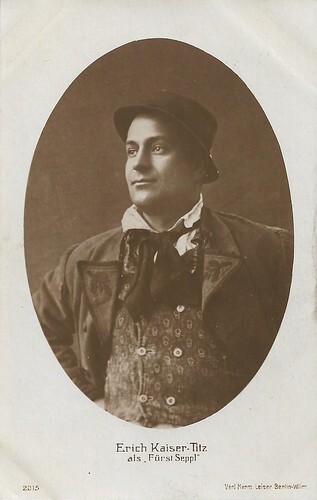
German postcard by Verlag Hermann Leiser, Berlin-Wilm., no. 2015. Erich Kaiser-Titz in Fürst Seppl/Prince Seppl (Carl Froehlich, 1915).
Erich Kaiser-Titz (1875-1928) was an actor in the German silent cinema of the 1910s and 1920s, playing in almost 300 films.
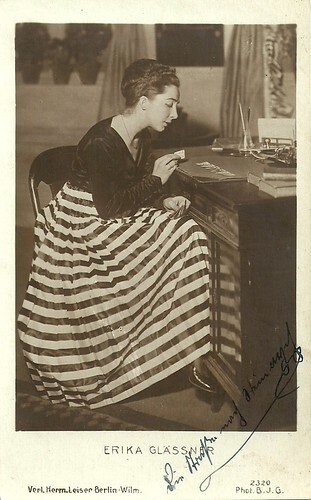
German postcard by Verlag Hermann Leiser, Berlin, no. 2320. Photo: B.J.G. 1910s.
Cute actress Erika Glässner (1890-1959) starred as a backfisch and later as a cheeky temptress in many German films of the silent era. From 1915 till 1952 she appeared in some 80 films.
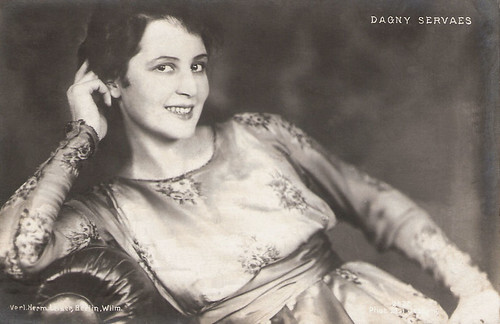
German postcard by Hermann Leiser, Berlin, no. 2429. Photo: Lisi Jessen. Sent by mail in 1918.
Dagny Servaes (1894-1961) was a German-Austrian theatre and film actress. She reached her peak in Ernst Lubitsch Das Weib des Pharao/The Pharao's Wife (1921).
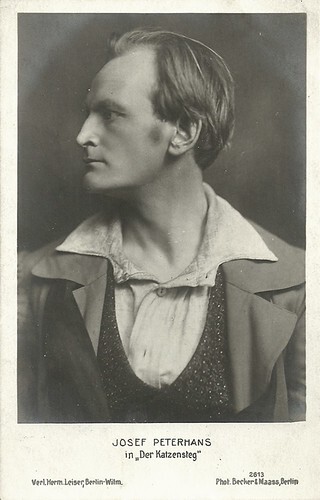
German postcard by Verlag Hermann Leiser, Berlin-Wilm., no. 2613. Photo: Becker & Maass, Berlin. Josef Peterhans in the stage play 'Der Katzensteg', which was based on the eponymous novel (1889) by Hermann Sudermann. The play was adapted into a film, first in 1915 by Max Mack.
Josef Thomas Peterhans (1882-1960) was a German stage and screen actor who peaked in German silent cinema in the late 1910s.
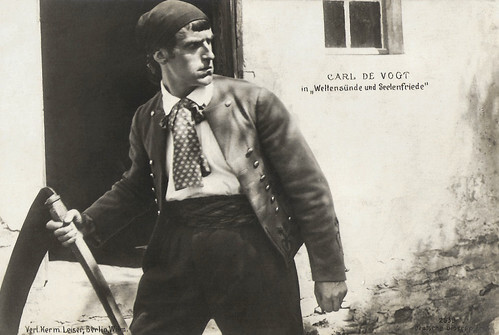
German postcard by Verlag Hermann Leiser, Berlin-Wilm., no. 2639. Photo: Deutsche Bioscop. Carl de Vogt in Weltensünde und Seelenfriede. The title is unknown in our sources.
German actor Carl de Vogt (1885-1970) was a kind of Indiana Jones in the silent films of Fritz Lang. De Vogt was also a popular singer and made several records in the 1920s.
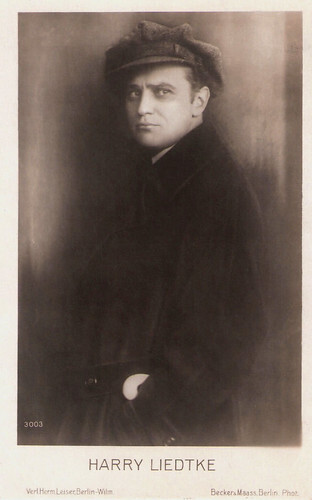
German postcard by Verlag Hermann Leiser, Berlin-Wilm., no. 3003. Photo: Becker & Maass, Berlin.
German actor Harry Liedtke (1882-1945) was the charming ladykiller of many early silent classics. Detective serials like Joe Deebs made him one of the first male stars of the German cinema.

German postcard by Verlag Herm. Leiser, Berlin-Wilm., no. 3044. Photo: Atelier Anni Eberth.
Actress and singer Else Berna appeared in 13 silent German films between 1917 and 1924.
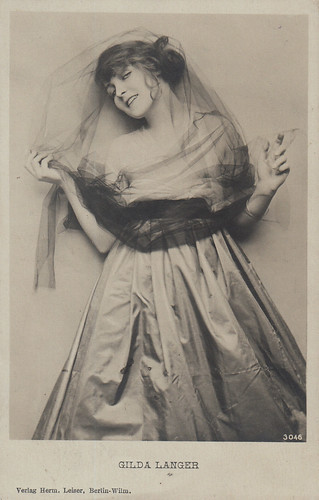
German postcard by Verlag Herm. Leiser, Berlin-Wilm., no. 3046. Collection: Marlene Pilaete.
Gilda Langer (1896-1920) was a German stage and film actress whose career began in the mid-1910s and lasted until her death in 1920. She appeared both on stage and in silent films; however, all films featuring Langer as an actress are now considered lost.
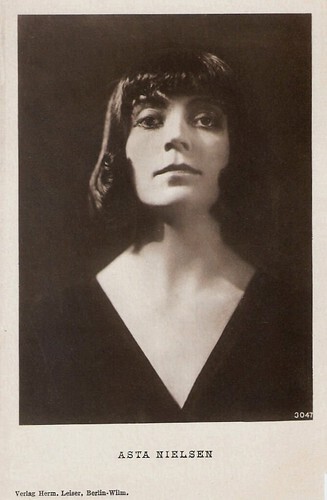
German postcard by Verlag Herm. Leiser, Berlin-Wilm., no. 3047.
Danish silent film actress Asta Nielsen (1881-1972), was one of the most popular leading ladies of the 1910s and one of the first international film stars. Of her 74 films between 1910 and 1932, seventy were made in Germany where she was known simply as Die Asta. Noted for her large dark eyes, mask-like face and boyish figure, Nielsen most often portrayed strong-willed passionate women trapped by tragic consequences.
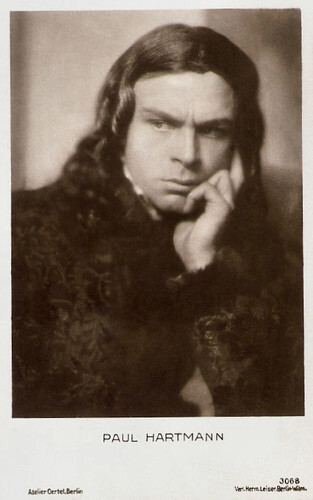
German postcard by Verl. Herm. Leiser, Berlin-Wilm., no. 3068. Photo: Atelier Oertel, Berlin.
German stage actor Paul Hartmann (1889-1977) made over 100 films, both in the silent and the sound period. Despite his commitment to the Nazi regime, he could continue his career quite smoothly into the 1950s and 1960s.
Cataloging the Leiser cards
Jean Ritsema describes at Ross Postcards that cataloguing the Leiser cards was not a straightforward process. It is complicated by the reuse of the inventory control numbers on the cards, as evidenced by the frequent replication of numbers in the catalogue. Through the years, Leiser regularly switched between cards with a full photo format and those with a white-bordered format and the publisher was also not consistent in the card format.
To help untangle the puzzle of the numbering system, Jean listed likely dates for each 1000 group of cards at the top of each group. However, these dates are estimates only and are subject to error. In addition, where known, dates and sources associated with cards have been added as a notation under the catalogue listing.
Probably three or four separate runs of the numbering sequence were used over the years, with cards released in the early years exclusively issued in full photo format. In later years, portrait cards were issued with a white border while film scene cards were issued in full photo format. Whether the full number range (1-9999) was reused in each iteration, or whether only smaller sections of the range were reused, is still unclear.
In the earlier years, Leiser focused on opera and stage performers. During the First World War, the German government stimulated the film industry and decided to promote film stars. From then on the main focus of the Leiser postcards was on film actors. However, musicians, dancers and other social figures appear throughout the whole period. Another factor that complicates cataloguing is the repeated use of the same photo under different inventory numbers.
More complications: some cards were issued in both black-and-white and sepia; several were issued in the standard size as well as a slightly smaller size; cards were reissued with several font variations; and cards were issued both with the text 'Verlag Herm. Leiser' spelt out and with an HLB logo. A final issue that Jean noted was the appearance of a second publisher's mark on several cards, such as for Photochemie and Rotophot. It is unknown if Leiser printed any of the cards he published.
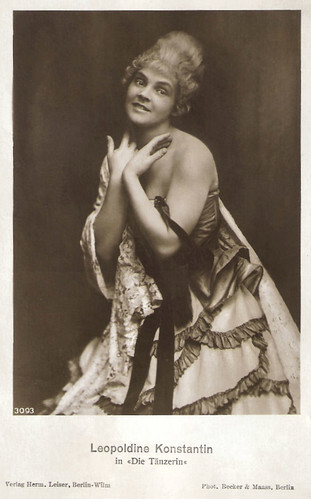
German postcard by Verlag Hermann Leiser, Berlin-Wilm., no. 3095. Photo: Becker & Maas, Berlin. Leopoldine Konstantin in Die Tänzerin/The Dancer (Georg Jacoby, 1915).
Leopoldine Konstantin (1886-1965) was a famous Austrian theatre and film character actress, who worked for years with director Max Reinhardt. She played Claude Rains' dominant mother in Alfred Hitchcock’s classic Notorious (1946). It was her sole Hollywood role.
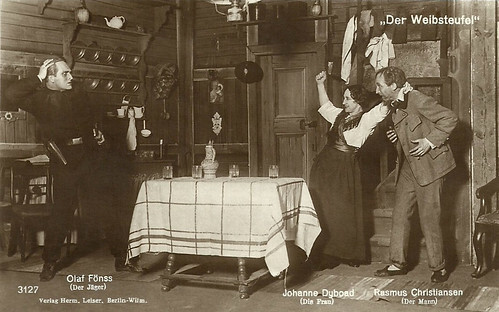
German postcard by Verlag Hermann Leiser, Berlin, no. 3127. Olaf Fønss , Johanne Dybwad and Rasmus Christiansen in the Danish stage production 'Graensejaegeren' (1916-1917), based on the German play 'Der Weibsteufel' (1914) by Karl Schönherr.
Olaf Fønss (1882-1949) was one of Denmark and Germany's biggest stars of the silent film era. He also worked as a film director, producer and censor.
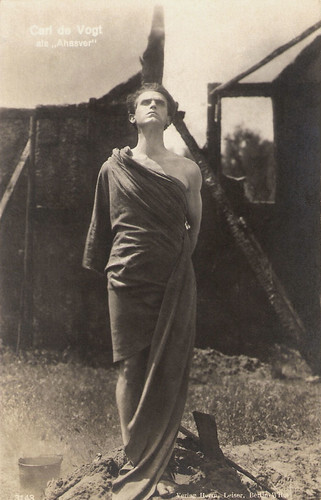
German postcard by Verlag Hermann Leiser, Berlin, no. 3143. Carl de Vogt in Ahasver (Robert Reinert, 1917). Ahasver is a three-part film on the story of the Wandering Jew Ahasver (De Vogt), who is condemned to bring misfortune.
German actor Carl de Vogt (1885-1970) was a kind of Indiana Jones in the silent films of Fritz Lang. De Vogt was also a popular singer and made several records in the 1920s.
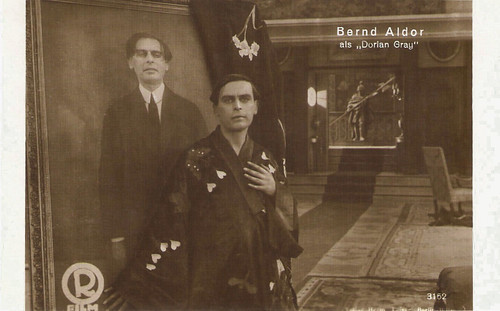
German postcard by Hermann Leiser Verlag, Berlin, no. 3152. Photo: Richard-Oswald-Produktion. Bernd Aldor in Das Bildnis des Dorian Gray/The Picture of Dorian Gray (Richard Oswald, 1917).
Bernd Aldor (1881-1950) was a star of the German silent cinema in the 1910s and 1920s, often in films by Richard Oswald or Lupu Pick. Sound film and the Nazi regime broke the career of this Jewish actor.

German postcard by Verlag Hermann Leiser, Berlin-Wilm., no. 3165. Photo: Becker & Maass, Berlin.
Leontine Kühnberg (1889-1945?) was a German theatre and silent film actress. For a time she belonged to the ensemble of Max Reinhardt's Deutsches Theater. Shortly before the outbreak of the First World War, she began to make films. In 1921 she married and withdrew from the film sets. She was Jewish and probably died at the end of WW II.
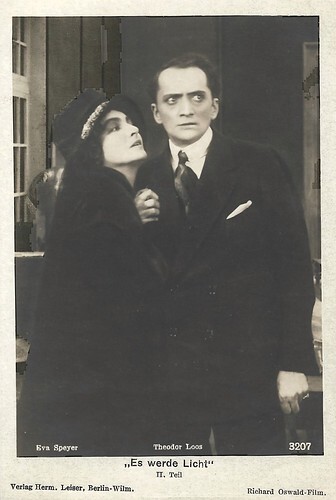
German postcard by Verlag Hermann Leiser, Berlin-Wilm., no. 3207. Photo: Richard Oswald-Film. Theodor Loos and Eva Speyer in Es werde Licht, Teil II (Richard Oswald, 1918).
Theodor Loos (1883-1954) was a German stage and screen actor between the 1910s and the 1950s. He became famous for his parts in Fritz Lang’s German films.
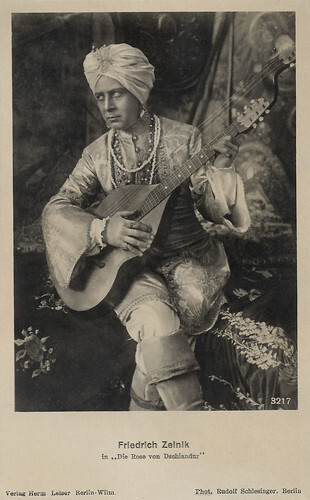
German postcard by Verlag Hermann Leiser, Berlin-Wilm., no. 3217. Photo: Rudolf Schlesinger, Berlin / Berliner Film-Manufaktur. Friedrich Zelnik in Die Rose von Dschiandur/The Rose of Dschiandur (Alfred Halm, 1918).
Austrian actor Friedrich Zelnik or Frederic Zelnik (1885-1950) was also one of the most important producers-directors of the German silent cinema. Already in the early 1910s, he became a film star in Germany, but during the 1920s he had his greatest successes there as director-producer of operetta-style costume films starring his wife, Lya Mara. A critical success was his drama Die Weber/The Weaver (1927). After 1933, he worked in Great Britain and also directed two films in the Netherlands.
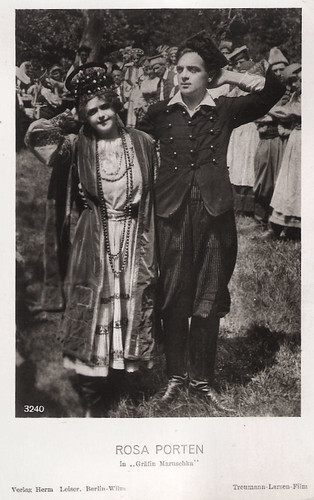
German postcard by Herm. Leiser, Berlin-Wilm., no 3240. Photo: Treumann-Larsen-Film. Rosa Porten and Max Wogritsch in Gräfin Maruschka/Countess Maruschka (Franz Eckstein, Rosa Porten, 1917).
Rosa Porten (1884-1972) was the elder and lesser-known sister of German silent film star Henny Porten. Both sisters started in 1906 as an actress for the pioneering Messter company and Rosa became one of the first women in Germany to write and direct films.
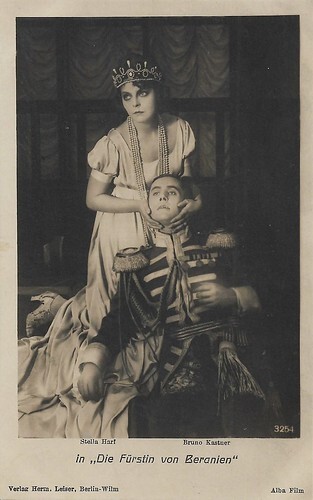
German postcard by Verlag Hermann Leiser, Berlin, no. 3254. Photo: Alba-Film. Stella Harf and Bruno Kastner in Die Fürstin von Beranien (Ernst Reicher, 1918).
German actor Bruno Kastner (1890-1932) was one of the most beloved stars of the 1910s and 1920s. His parts as the elegant and charming dandy made him a heartthrob of the German silent cinema.
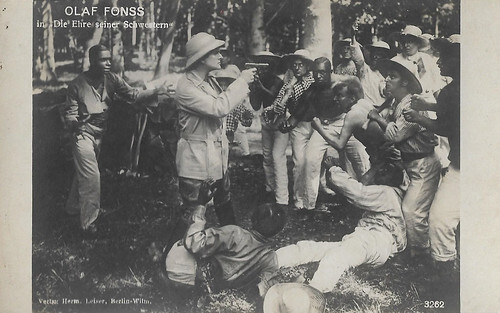
German postcard by Verlag Hermann Leiser, Berlin-Wilm., no. 3262. Olaf Fönss in the Danish flm Gengaeldelsens Ret (Fritz Magnussen 1917). The German title Die Ehre seiner Schwestern on the postcard translates to The Honour of his Sister, and the Danish title means The Right of Retribution.
After having played in Danish films in the early and mid-1910s, Danish actor Olaf Fönss / Olaf Fønss (1882-1949) tried his luck in Germany in 1915. He immediately became the protagonist of the serial Homunculus, written by Robert Reinert, directed by Otto Rippert and released in 1916, with enormous success.
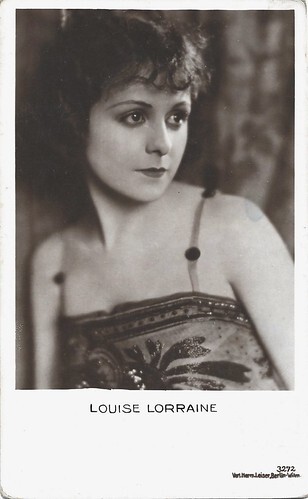
German postcard by Verlag Hermann Leiser, Bwerlin-Wilm., no. 3272.
Louise Lorraine (1904-1981) was an American film actress, who started out in two-reel comedies for independent studios, then spent time at MGM and Universal. She became very popular in action-filled silent serials and may be best remembered for being the third actress to portray Jane, in the serial The Adventures of Tarzan (1921). In 1930, she retired from the film industry.
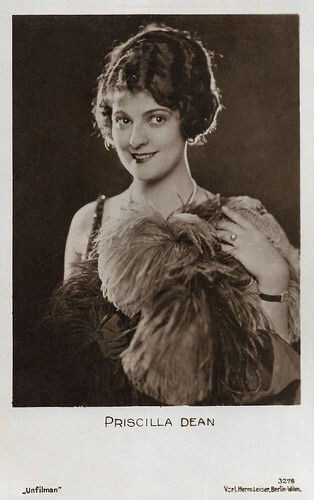
German postcard by Verlag Hermann Leiser, Berlin-Wilm., no. 3276. Photo: Unfilman.
Priscilla Dean (1896-1987) was an American actress on the silent screen. Between 1912 and 1928, she appeared in some 70 silent films, and later in five sound films. She is best known for her Universal films under the direction of horror specialist Tod Browning.
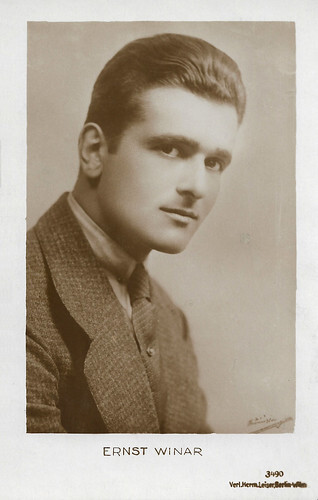
German postcard by Verl. Herm. Leiser, Berlin-Wilm., no. 3490.
Dutch actor Ernst Winar (1894-1978) appeared in 34 films between 1916 and 1955, in The Netherlands and as well in Germany. He was also a film director and made 14 films between 1922 and 1955. Later he edited the first short films of Dutch director Paul Verhoeven.
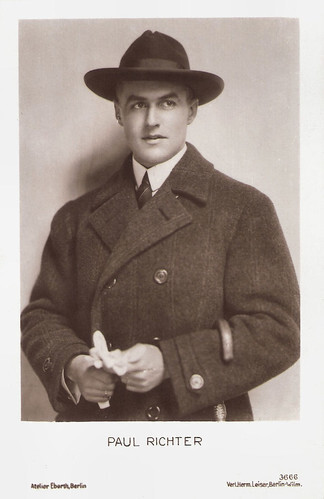
German postcard by Verl. Herm.Leiser, Berlin-Wilm., no. 3666. Photo: Atelier Eberth, Berlin.
Austrian actor Paul Richter (1895-1961) is best known as Siegfried, the hero of the classic fantasy film Die Nibelungen (1924), one of the masterpieces of the German silent cinema, directed by Fritz Lang.
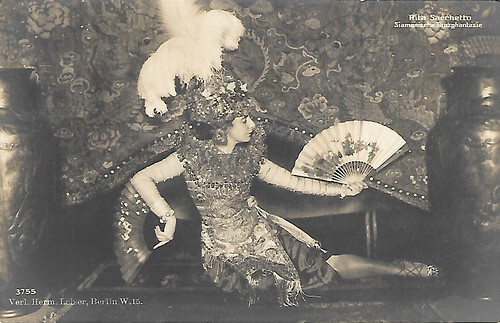
German Postcard by Verlag Hermann Leiser, Berlin, no. 3755. Photo: Rita Sacchetto in the stage performance 'Siamesische Tanzphantasie'. Collection: Didier Hanson.
German actress and dancer Rita Sacchetto (1879-1959) was in the 1910s a star of the Danish Nordisk Film Company.
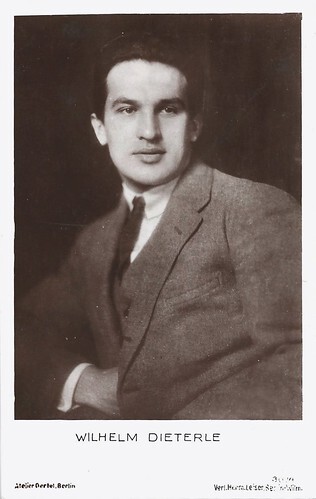
German postcard by Verlag Hermann Leiser, Berlin-Wilm., no. 3926. Photo: Atelier Oertel, Berlin.
Wilhelm Dieterle (William Dieterle) (1893-1972) was a German actor and director who started out in Weimar cinema, before becoming a well-known Hollywood director.
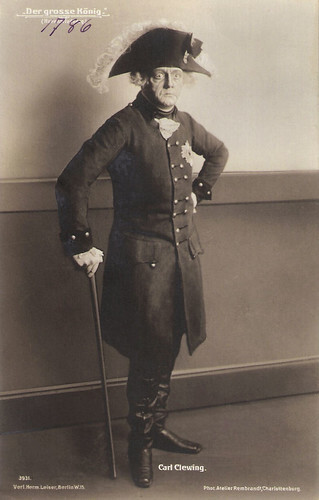
German postcard by Verlag Hermann Leiser, Berlin-Wilm., no. 3931. Photo: Atelier Rembrandt, Charlottenburg. Publicity still for a stage production of Der grosse König (The Great King).
German actor Carl Clewing (1884-1954) was an opera singer, the composer of the song 'Alle Tage ist kein Sonntag' (Not every day is a Sunday) and a Music professor in Berlin During the years of the early cinema he was much in demand as a film actor.
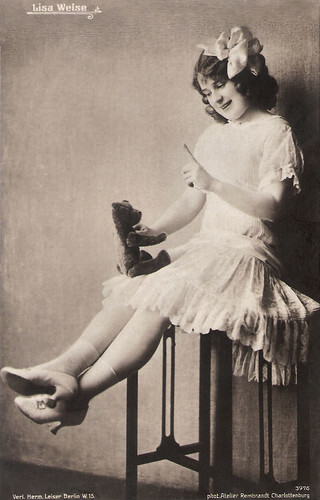
German postcard by Verlag Hermann Leiser, Berlin Wilm., no. 3976. Photo: Rembrandt, Charlottenburg.
German actress Lisa Weise (?-1952) starred in silent films of the 1910s. Most of her films were directed by Friedrich Zelnik and often her film partner was Karl Beckersachs.
To be continued tomorrow!
Source: Jean Ritsema (Ross Postcards).

German postcard by Verlag Hermann Leiser, Berlin-Wilm., no. 2015. Erich Kaiser-Titz in Fürst Seppl/Prince Seppl (Carl Froehlich, 1915).
Erich Kaiser-Titz (1875-1928) was an actor in the German silent cinema of the 1910s and 1920s, playing in almost 300 films.

German postcard by Verlag Hermann Leiser, Berlin, no. 2320. Photo: B.J.G. 1910s.
Cute actress Erika Glässner (1890-1959) starred as a backfisch and later as a cheeky temptress in many German films of the silent era. From 1915 till 1952 she appeared in some 80 films.

German postcard by Hermann Leiser, Berlin, no. 2429. Photo: Lisi Jessen. Sent by mail in 1918.
Dagny Servaes (1894-1961) was a German-Austrian theatre and film actress. She reached her peak in Ernst Lubitsch Das Weib des Pharao/The Pharao's Wife (1921).

German postcard by Verlag Hermann Leiser, Berlin-Wilm., no. 2613. Photo: Becker & Maass, Berlin. Josef Peterhans in the stage play 'Der Katzensteg', which was based on the eponymous novel (1889) by Hermann Sudermann. The play was adapted into a film, first in 1915 by Max Mack.
Josef Thomas Peterhans (1882-1960) was a German stage and screen actor who peaked in German silent cinema in the late 1910s.

German postcard by Verlag Hermann Leiser, Berlin-Wilm., no. 2639. Photo: Deutsche Bioscop. Carl de Vogt in Weltensünde und Seelenfriede. The title is unknown in our sources.
German actor Carl de Vogt (1885-1970) was a kind of Indiana Jones in the silent films of Fritz Lang. De Vogt was also a popular singer and made several records in the 1920s.

German postcard by Verlag Hermann Leiser, Berlin-Wilm., no. 3003. Photo: Becker & Maass, Berlin.
German actor Harry Liedtke (1882-1945) was the charming ladykiller of many early silent classics. Detective serials like Joe Deebs made him one of the first male stars of the German cinema.

German postcard by Verlag Herm. Leiser, Berlin-Wilm., no. 3044. Photo: Atelier Anni Eberth.
Actress and singer Else Berna appeared in 13 silent German films between 1917 and 1924.

German postcard by Verlag Herm. Leiser, Berlin-Wilm., no. 3046. Collection: Marlene Pilaete.
Gilda Langer (1896-1920) was a German stage and film actress whose career began in the mid-1910s and lasted until her death in 1920. She appeared both on stage and in silent films; however, all films featuring Langer as an actress are now considered lost.

German postcard by Verlag Herm. Leiser, Berlin-Wilm., no. 3047.
Danish silent film actress Asta Nielsen (1881-1972), was one of the most popular leading ladies of the 1910s and one of the first international film stars. Of her 74 films between 1910 and 1932, seventy were made in Germany where she was known simply as Die Asta. Noted for her large dark eyes, mask-like face and boyish figure, Nielsen most often portrayed strong-willed passionate women trapped by tragic consequences.

German postcard by Verl. Herm. Leiser, Berlin-Wilm., no. 3068. Photo: Atelier Oertel, Berlin.
German stage actor Paul Hartmann (1889-1977) made over 100 films, both in the silent and the sound period. Despite his commitment to the Nazi regime, he could continue his career quite smoothly into the 1950s and 1960s.
Cataloging the Leiser cards
Jean Ritsema describes at Ross Postcards that cataloguing the Leiser cards was not a straightforward process. It is complicated by the reuse of the inventory control numbers on the cards, as evidenced by the frequent replication of numbers in the catalogue. Through the years, Leiser regularly switched between cards with a full photo format and those with a white-bordered format and the publisher was also not consistent in the card format.
To help untangle the puzzle of the numbering system, Jean listed likely dates for each 1000 group of cards at the top of each group. However, these dates are estimates only and are subject to error. In addition, where known, dates and sources associated with cards have been added as a notation under the catalogue listing.
Probably three or four separate runs of the numbering sequence were used over the years, with cards released in the early years exclusively issued in full photo format. In later years, portrait cards were issued with a white border while film scene cards were issued in full photo format. Whether the full number range (1-9999) was reused in each iteration, or whether only smaller sections of the range were reused, is still unclear.
In the earlier years, Leiser focused on opera and stage performers. During the First World War, the German government stimulated the film industry and decided to promote film stars. From then on the main focus of the Leiser postcards was on film actors. However, musicians, dancers and other social figures appear throughout the whole period. Another factor that complicates cataloguing is the repeated use of the same photo under different inventory numbers.
More complications: some cards were issued in both black-and-white and sepia; several were issued in the standard size as well as a slightly smaller size; cards were reissued with several font variations; and cards were issued both with the text 'Verlag Herm. Leiser' spelt out and with an HLB logo. A final issue that Jean noted was the appearance of a second publisher's mark on several cards, such as for Photochemie and Rotophot. It is unknown if Leiser printed any of the cards he published.

German postcard by Verlag Hermann Leiser, Berlin-Wilm., no. 3095. Photo: Becker & Maas, Berlin. Leopoldine Konstantin in Die Tänzerin/The Dancer (Georg Jacoby, 1915).
Leopoldine Konstantin (1886-1965) was a famous Austrian theatre and film character actress, who worked for years with director Max Reinhardt. She played Claude Rains' dominant mother in Alfred Hitchcock’s classic Notorious (1946). It was her sole Hollywood role.

German postcard by Verlag Hermann Leiser, Berlin, no. 3127. Olaf Fønss , Johanne Dybwad and Rasmus Christiansen in the Danish stage production 'Graensejaegeren' (1916-1917), based on the German play 'Der Weibsteufel' (1914) by Karl Schönherr.
Olaf Fønss (1882-1949) was one of Denmark and Germany's biggest stars of the silent film era. He also worked as a film director, producer and censor.

German postcard by Verlag Hermann Leiser, Berlin, no. 3143. Carl de Vogt in Ahasver (Robert Reinert, 1917). Ahasver is a three-part film on the story of the Wandering Jew Ahasver (De Vogt), who is condemned to bring misfortune.
German actor Carl de Vogt (1885-1970) was a kind of Indiana Jones in the silent films of Fritz Lang. De Vogt was also a popular singer and made several records in the 1920s.

German postcard by Hermann Leiser Verlag, Berlin, no. 3152. Photo: Richard-Oswald-Produktion. Bernd Aldor in Das Bildnis des Dorian Gray/The Picture of Dorian Gray (Richard Oswald, 1917).
Bernd Aldor (1881-1950) was a star of the German silent cinema in the 1910s and 1920s, often in films by Richard Oswald or Lupu Pick. Sound film and the Nazi regime broke the career of this Jewish actor.

German postcard by Verlag Hermann Leiser, Berlin-Wilm., no. 3165. Photo: Becker & Maass, Berlin.
Leontine Kühnberg (1889-1945?) was a German theatre and silent film actress. For a time she belonged to the ensemble of Max Reinhardt's Deutsches Theater. Shortly before the outbreak of the First World War, she began to make films. In 1921 she married and withdrew from the film sets. She was Jewish and probably died at the end of WW II.

German postcard by Verlag Hermann Leiser, Berlin-Wilm., no. 3207. Photo: Richard Oswald-Film. Theodor Loos and Eva Speyer in Es werde Licht, Teil II (Richard Oswald, 1918).
Theodor Loos (1883-1954) was a German stage and screen actor between the 1910s and the 1950s. He became famous for his parts in Fritz Lang’s German films.

German postcard by Verlag Hermann Leiser, Berlin-Wilm., no. 3217. Photo: Rudolf Schlesinger, Berlin / Berliner Film-Manufaktur. Friedrich Zelnik in Die Rose von Dschiandur/The Rose of Dschiandur (Alfred Halm, 1918).
Austrian actor Friedrich Zelnik or Frederic Zelnik (1885-1950) was also one of the most important producers-directors of the German silent cinema. Already in the early 1910s, he became a film star in Germany, but during the 1920s he had his greatest successes there as director-producer of operetta-style costume films starring his wife, Lya Mara. A critical success was his drama Die Weber/The Weaver (1927). After 1933, he worked in Great Britain and also directed two films in the Netherlands.

German postcard by Herm. Leiser, Berlin-Wilm., no 3240. Photo: Treumann-Larsen-Film. Rosa Porten and Max Wogritsch in Gräfin Maruschka/Countess Maruschka (Franz Eckstein, Rosa Porten, 1917).
Rosa Porten (1884-1972) was the elder and lesser-known sister of German silent film star Henny Porten. Both sisters started in 1906 as an actress for the pioneering Messter company and Rosa became one of the first women in Germany to write and direct films.

German postcard by Verlag Hermann Leiser, Berlin, no. 3254. Photo: Alba-Film. Stella Harf and Bruno Kastner in Die Fürstin von Beranien (Ernst Reicher, 1918).
German actor Bruno Kastner (1890-1932) was one of the most beloved stars of the 1910s and 1920s. His parts as the elegant and charming dandy made him a heartthrob of the German silent cinema.

German postcard by Verlag Hermann Leiser, Berlin-Wilm., no. 3262. Olaf Fönss in the Danish flm Gengaeldelsens Ret (Fritz Magnussen 1917). The German title Die Ehre seiner Schwestern on the postcard translates to The Honour of his Sister, and the Danish title means The Right of Retribution.
After having played in Danish films in the early and mid-1910s, Danish actor Olaf Fönss / Olaf Fønss (1882-1949) tried his luck in Germany in 1915. He immediately became the protagonist of the serial Homunculus, written by Robert Reinert, directed by Otto Rippert and released in 1916, with enormous success.

German postcard by Verlag Hermann Leiser, Bwerlin-Wilm., no. 3272.
Louise Lorraine (1904-1981) was an American film actress, who started out in two-reel comedies for independent studios, then spent time at MGM and Universal. She became very popular in action-filled silent serials and may be best remembered for being the third actress to portray Jane, in the serial The Adventures of Tarzan (1921). In 1930, she retired from the film industry.

German postcard by Verlag Hermann Leiser, Berlin-Wilm., no. 3276. Photo: Unfilman.
Priscilla Dean (1896-1987) was an American actress on the silent screen. Between 1912 and 1928, she appeared in some 70 silent films, and later in five sound films. She is best known for her Universal films under the direction of horror specialist Tod Browning.

German postcard by Verl. Herm. Leiser, Berlin-Wilm., no. 3490.
Dutch actor Ernst Winar (1894-1978) appeared in 34 films between 1916 and 1955, in The Netherlands and as well in Germany. He was also a film director and made 14 films between 1922 and 1955. Later he edited the first short films of Dutch director Paul Verhoeven.

German postcard by Verl. Herm.Leiser, Berlin-Wilm., no. 3666. Photo: Atelier Eberth, Berlin.
Austrian actor Paul Richter (1895-1961) is best known as Siegfried, the hero of the classic fantasy film Die Nibelungen (1924), one of the masterpieces of the German silent cinema, directed by Fritz Lang.

German Postcard by Verlag Hermann Leiser, Berlin, no. 3755. Photo: Rita Sacchetto in the stage performance 'Siamesische Tanzphantasie'. Collection: Didier Hanson.
German actress and dancer Rita Sacchetto (1879-1959) was in the 1910s a star of the Danish Nordisk Film Company.

German postcard by Verlag Hermann Leiser, Berlin-Wilm., no. 3926. Photo: Atelier Oertel, Berlin.
Wilhelm Dieterle (William Dieterle) (1893-1972) was a German actor and director who started out in Weimar cinema, before becoming a well-known Hollywood director.

German postcard by Verlag Hermann Leiser, Berlin-Wilm., no. 3931. Photo: Atelier Rembrandt, Charlottenburg. Publicity still for a stage production of Der grosse König (The Great King).
German actor Carl Clewing (1884-1954) was an opera singer, the composer of the song 'Alle Tage ist kein Sonntag' (Not every day is a Sunday) and a Music professor in Berlin During the years of the early cinema he was much in demand as a film actor.

German postcard by Verlag Hermann Leiser, Berlin Wilm., no. 3976. Photo: Rembrandt, Charlottenburg.
German actress Lisa Weise (?-1952) starred in silent films of the 1910s. Most of her films were directed by Friedrich Zelnik and often her film partner was Karl Beckersachs.
To be continued tomorrow!
Source: Jean Ritsema (Ross Postcards).
Published on December 25, 2023 22:00
December 24, 2023
Verlag Hermann Leiser (1)
Ross Postcards is one of our favourite websites. It is dedicated to the legendary Berlin publishing house Ross Verlag, renowned for the production and distribution throughout Europe of high-quality film star postcards of both American and European film stars. The website details information related to the history of Ross Verlag from 1919 to 1944, and its founder, Heinrich Ross. It also contains an image archive of not only thousands of Ross Verlag postcards but also of several other European publishers. Mark Goffee is the creator of Ross Postcards and Jean Ritsema is behind locating the images of the Ross Verlag postcards. A while ago, we contacted Jean about Verlag Hermann Leiser, a little-known but interesting Berlin publishing company that was active in the 1910s. Jean became curious about Leiser and decided to make a catalogue of the Leiser star postcards. Of course, we helped her as best as we could.
Jean's Leiser section is now ready and listed under the 'Other Publishers - German' header. EFSP salutes this milestone with five posts presenting our favourite postcards by Verlag Hermann Leiser. Today the numbers 0-2000.
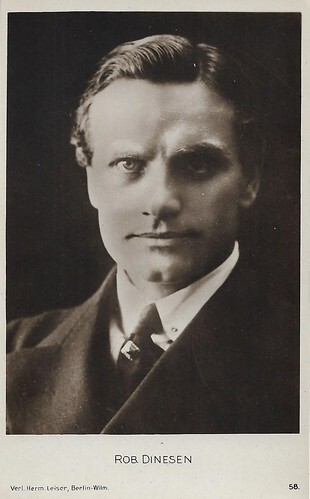
German postcard by Verlag Hermann Leiser, no. 58.
Danish actor and director Robert Dinesen (1874-1972) made his film debut in Afgrunden/The Abyss (1910) as Asta Nielsen's fiancee. One year later, he directed the successful circus drama De fire djaevle/The Four Devils, in which he also played the lead. It launched a trend of sensational circus dramas, and Dinesen became one of the greatest stars of both the Scandinavian and the German silent cinema.
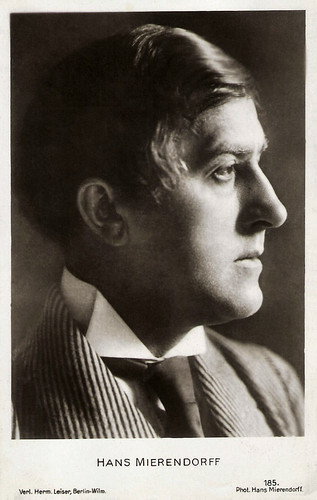
German postcard by Verlag Hermann Leiser, Berlin-Wilm., no. 185. Photo: Hans Mierendorff.
Hans Mierendorff (1882-1955) was a German stage and film actor and film director. From 1916 he appeared as the gentlemen-detective Harry Higgs, cashing in on the popular trend of German detective films at the time. Mierendorff played in over 100 films.

German postcard by Verlag Hermann Leiser, Berlin-Wilm., no. 220. Photo: Atelier Elite, Berlin.
Ernst Rückert (1886-1950) was a German stage and screen actor. In the 1910s he was a popular film actor, while in the mid-1920s he starred in so-called Prussian films.
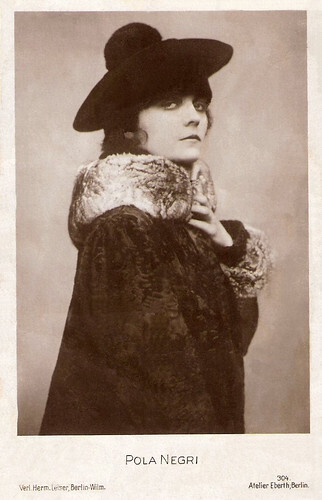
German postcard by Verlag Hermann Leiser, Berlin-Wilm., no. 304. Photo: Atelier Eberth, Berlin.
Polish film actress Pola Negri (1894-1987) achieved notoriety as a femme fatale in silent films between the 1910s and 1930s.
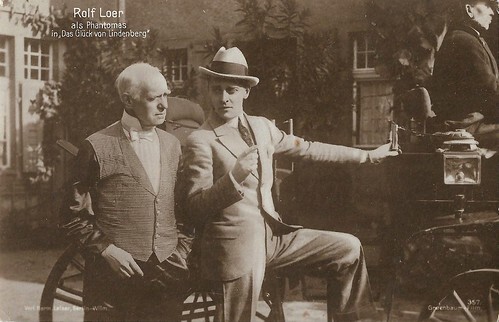
German postcard by Verlag Hermann Leiser, Berlin, no. 357. Photo: Greenbaum-Film. Rolf Loer as Phantomas in Das Glück von Lindenberg (Adolf Gärtner, 1918). The film was one of the episodes of the German Phantomas series (1916-1920).
Rolf Loer, real name Lawrence F. Koehler, also Rolf Lör or Rolf Loehr (1892-1964) was a German-American actor, violinist and music teacher. In the late 1910s, he peaked in German silent films as the character Phantomas.
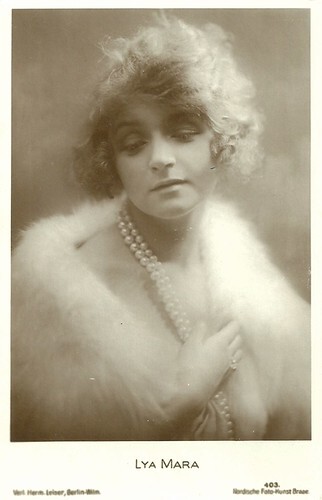
German postcard by Verlag Hermann Leiser, Berlin-Wilm., no. 403. Photo: Nordische Foto-Kunst Braae.
Lya Mara (1897-1960?) was one of the biggest stars of the German silent cinema. Her stardom was even the subject of a novel, which was published in 100 episodes between 1927 and 1928. Her career virtually ended after the arrival of sound film.
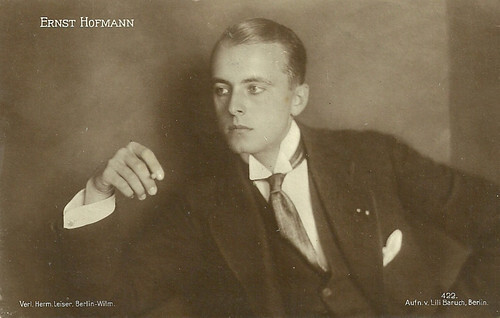
German postcard by Verlag Hermann Leiser, Berlin-Wilm., no. 422. Photo: Lili Baruch, Berlin.
German actor Ernst Hofmann (1890-1944) was one of the most attractive actors of the German silent cinema. in the 1910s He was the producer and star of Der Knabe in Blau (1918), the first film by legendary director Friedrich Wilhelm Murnau.
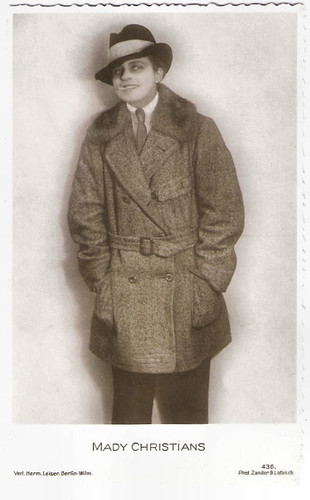
German postcard by Verlag Hermann Leiser, Berlin-Wilm., no. 436. Photo: Zander & Labisch.
Austrian-born stage actress Mady Christians (1892-1951) was a star of the German silent cinema and appeared in Austrian, French, British and Hollywood films too.
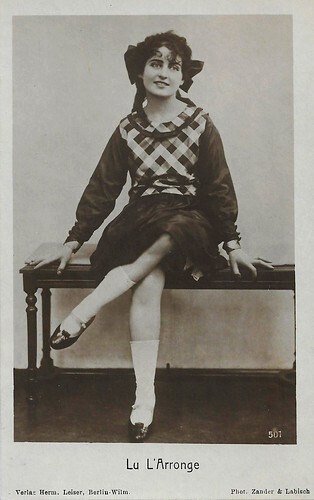
German postcard by Verlag Hermann Leiser, Berlin, no. 501. Photo: Zander & Labisch.
Lu L'Arronge (1902-1991) was a German film actress and producer, who between 1917 and 1920 mostly starred in her own productions, impersonating the type of the Backfisch.

German postcard by Verlag Herm. Leiser, Berlin-Wilm., no. 769. Photo: Atelier Eberth, Berlin.
Ernst Deutsch (1890-1969) was an Austrian actor who acted in 42 silent films. He starred in such German Expressionist films as Der Golem, wie er in der Welt kam (1920), and Von morgens bis mitternachts (1920). In 1938 the Jewish actor moved to the USA and worked in Hollywood.
The History of Hermann Leiser
Who was Hermann Leiser? Information relating to Verlag Hermann Leiser is sparse. Jean Ritsema found in her research a close relationship with another publishing firm, Verlag Louis Blumenthal. First, Louis Blumenthal operated solo. Then followed a multi-year partnership between Blumenthal and Hermann Leiser. Finally, it was a solo operation by Hermann Leiser.
Jean discovered that Louis Blumenthal started in Berlin as a merchant at Mohrenstraße 17/18. By 1880, he had expanded to book printing, the paper trade, leather goods, writing materials and office supplies, still at the same address. Blumenthal's residence was nearby, at Mohrenstraße 15. In 1884, the business was relocated to Leipzigerstraße 38, the address that is printed with the text 'Verlag Louis Blumenthal' on early postcards. The firm remained at this address for the duration of Blumenthal's association with it.
Around 1898, Blumenthal was joined by Hermann Leiser in the ownership of the business at Leipzigerstraße, a partnership which lasted for a decade. Around 1909 Hermann Leiser moved to Olivaer Platz 4. In a 1909 advertisement in the Allgemeine Musik Zeitung, he announced the availability of "3000 Portratkärten, Olivaerplatz 4, vorm. Louis Blumenthal". Correspondingly, a number of cards are marked "Verlag Hermann Leiser vormals Louis Blumenthal".
The 1911-1913 address books list Leiser's business on Olivaerplatz 4, with the description of Porträtkarten. At some point, the publisher's mark on the postcards was changed to Verlag Herm. Leiser (in varying forms), dropping the reference to Blumenthal. A final move for Leiser is listed in the 1914 address book which provides a location at Rüdesheimer Platz 3 where Leiser remained through 1931. In many of the later years' entries, his business is described as a "Kaufmann" (merchant), rather than a publisher of Porträtkarten.
Jean Ritsema found it difficult to find a date for when Blumenthal's involvement with postcards began. She discovered a 1903 advertisement in the Monatsschrift für das deutsche Geistesleben, in which Blumenthal's card inventory already numbered over 1000. It also is difficult to know when Leiser's involvement with postcards ended. His listing in the 1929/30 and 1931/32 'Jüdisches Adressbuch for Gross-Berlin' came shortly before the forced transfer of Jewish-owned property to non-Jews in Nazi Germany from 1933 to 1945. The circumstances of Leiser's business and life at that time are unknown. However, in a 1998 monograph by Corinna Müller and Harro Segeberg, 'Die Modellierung des Kinofilms' references the takeover of Leiser by Ross Verlag, stating: 'In Berlin, the Hermann Leiser company began to monopolise the star postcard business. Leiser later became the property of Ross-Verlag, which then also published numerous film star series and was eventually replaced itself in the 1930s by the Ufa-postcard service'.
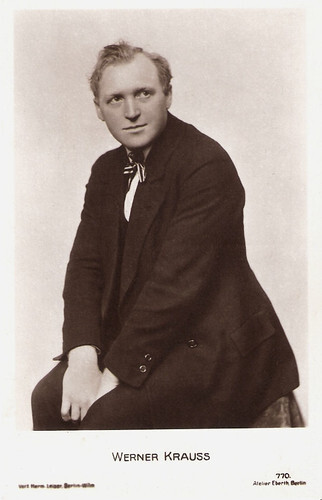
German postcard by Verlag Hermann Leiser, Berlin- Wilm., no. 770. Photo: Eberth, Berlin.
German stage and film actor Werner Krauss (1884-1959) became a worldwide sensation as the demonic Dr. Caligari in the classic of the German expressionist cinema, Das Kabinett des Doktor Caligari/The Cabinet of Dr. Caligari (1919). He appeared in several silent masterpieces, but his magnificent film career was later overshadowed by his appearance in one of the most notorious propaganda films of the Third Reich.
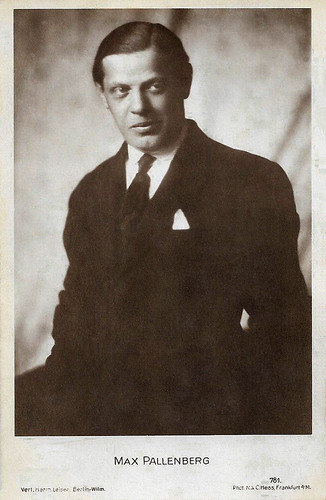
German postcard by Verlag Hermann Leiser, Berlin-Wilm., no. 781. Photo: N. & C. Hess, Frankfurt a.M.
Max Pallenberg (1877-1934) was an Austrian singer, actor and comedian. He was one of the most important comedians of his time and often played under the direction of Max Reinhardt. Although Pallenberg was successful as a stage comedian, he only incidentally accepted roles in films.
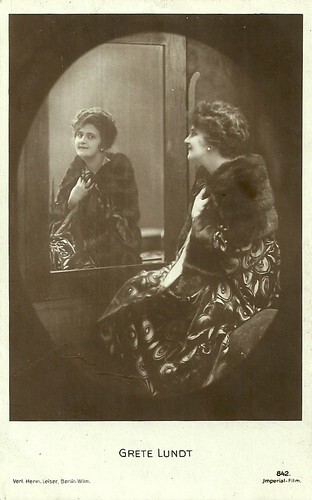
German postcard by Verlag Hermann Leiser, Berlin-Wilm, no. 842. Photo: Imperial-Film.
Grete Lundt aka Grete Lund (1892-1926) was an Austrian stage and screen actress, who played in Austrian and German silent films.
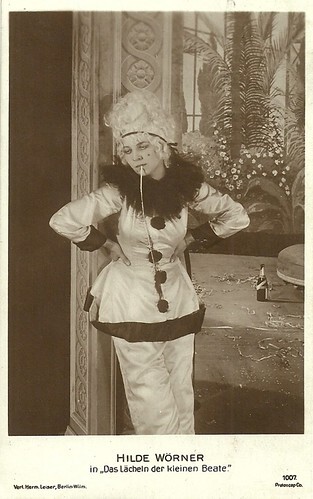
German postcard by Verlag Hermann Leiser, Berlin-Wilm., no. 1007. Photo: Protoscop Co. Hilde Wörner in Das Lächeln der kleinen Beate (Georg Schubert, 1919).
Hilde Wörner (1895-1963) was a German stage and film actress, who also worked as a filmmaker. She appeared mainly in silent films, had her own series and her most notable film was Ernst Lubitsch’s Die Flamme (1922).
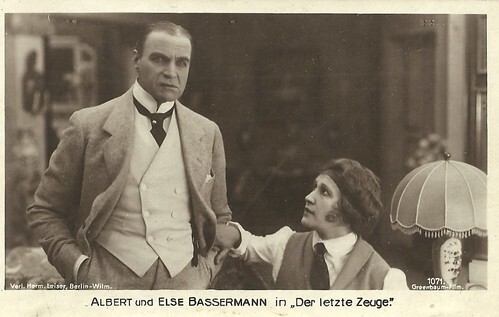
German postcard by Verlag Hermann Leiser, no. 1071. Photo: Greenbaum-Film. Albert and Else Bassermann in Der letzte Zeuge/The Last Witness (Adolf Gärtner, 1919).
Albert Bassermann (1867–1952) was one of the first great German stage actors who worked for the cinema. In 1933 he fled the Nazi regime and became an Oscar-nominated stage and film actor in the US.
Else Bassermann , née Elisabeth Sara Schiff (1878-1961) was a German stage and screen actress, who in 1908 married renowned stage actor Albert Bassermann and often performed together with him on stage. When he started to play in the film, she accompanied him.
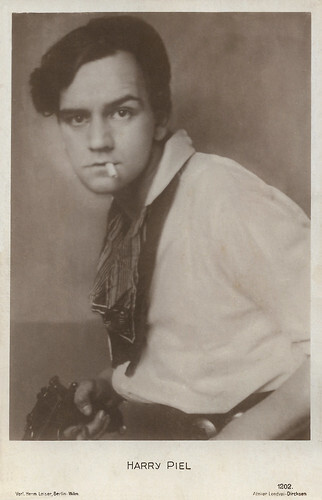
German postcard by Verlag Hermann Leiser, Berlin-Wilm., no. 1202. Photo: Atelier Lendvai-Dircksen.
German ‘dynamite’ director, actor, producer and screenwriter Harry Piel (1892-1963) made over 150 sensational films full of explosions and stunts.
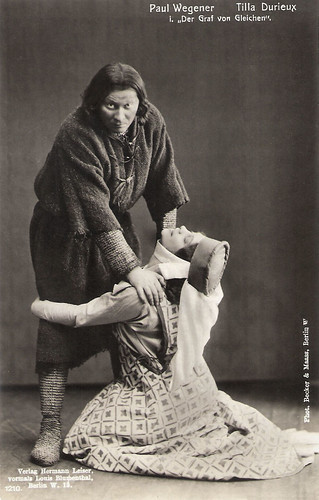
German postcard by Verl. Hermann Leiser, Berlin-Wilm., no. 1210. Photo: Becker & Maass, Berlin. Paul Wegener and Tilla Durieux in the stage production of 'Der Graf von Gleichen' by the Berliner Kammerspiele in 1909.
German actor, writer and film director Paul Wegener (1874-1948) is one of the true fathers of the horror and fantasy genre, particularly remembered for his three silent films centred around the Jewish legend of the Golem. Wegener was one of the pioneers of German cinema who realized the potential of the new medium and used the possibilities of cinematic trick photography as a method for presenting fantastic tales in a serious matter.
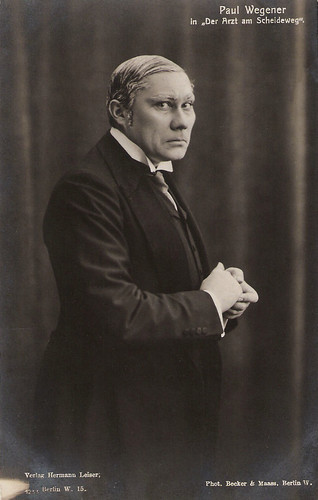
German postcard by Verlag Hermann Leiser, Berlin, no. 1233. Photo: Becker & Maass, Berlin. Paul Wegener in the play 'Der Arzt am Scheideweg' (The Doctor's Dilemma) by George Bernhard Shaw.
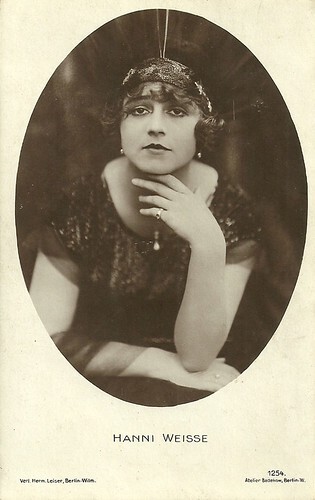
German postcard by Verlag Hermann Leiser, no. 1254. Photo: Atelier Badekow, Berlin.
German actress Hanni Weisse (1892-1967) belonged to the great film divas of the early German silent film. She was able to maintain her stardom till the 1920s.
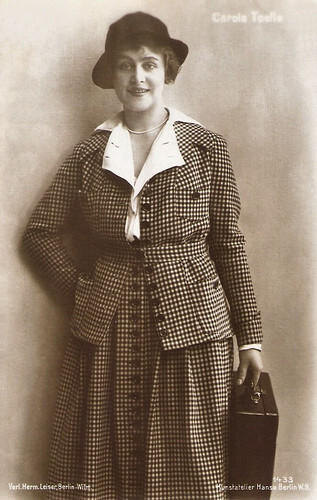
German postcard by Verlag Hermann Leiser, Berlin-Wilm., no. 1433. Photo: Filmatelier Hansa.
Carola Toelle (1893-1958) was a German actress, in particular in German silent cinema of the late 1910s and early 1920s.
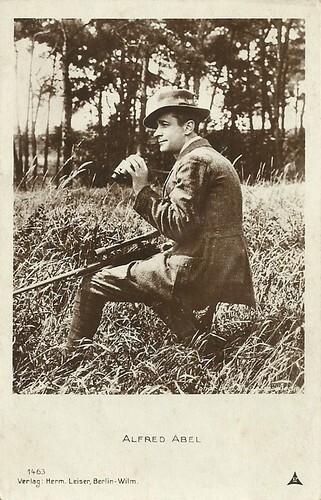
German postcard by Verlag Hermann Leiser, no. 1463. Photo: Berliner Illustrierte, Berlin. 1910s.
Alfred Abel (1879-1937) played in over 140 silent and sound films between 1913 and 1938. He is best known as the industrial Fredersen in Fritz Lang's Metropolis (1927).
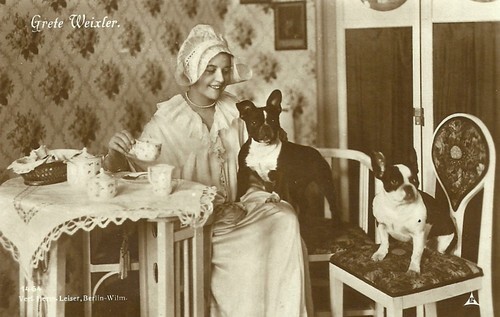
German postcard by Verlag Hermann Leiser, Berlin, no. 1464. Photo: Pm.
Grete Weixler (ca. 1900- after 1922) was a German actress of the silent cinema. From 1914 on, she appeared in secondary roles in melodramas by directors like Carl Boese, Friedrich Zelnik and Lupu Pick.
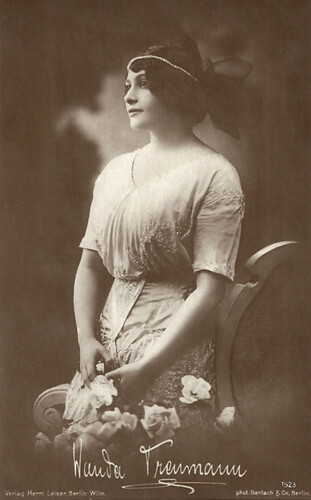
German postcard by Verlag Hermann Leiser, Berlin-Wilm., no. 1523. Photo: Gerlach & Co., Berlin.
Wanda Treumann (1883-1963) was a German actress and film producer. Together with Viggo Larsen, she produced many films in the 1910s, in which she also often had the female lead.
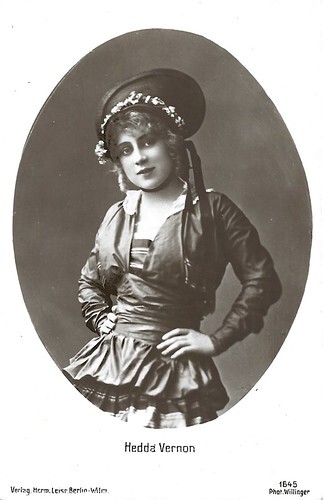
German postcard by Verlag Hermann Leiser, Berlin-Wilm., no. 1645. Photo: Willinger.
German actress, writer and producer Hedda Vernon (1886-1925) appeared in more than 60 films of the early silent period. During the 1910s she was such a popular film star that she got her own Hedda-Vernon serial.
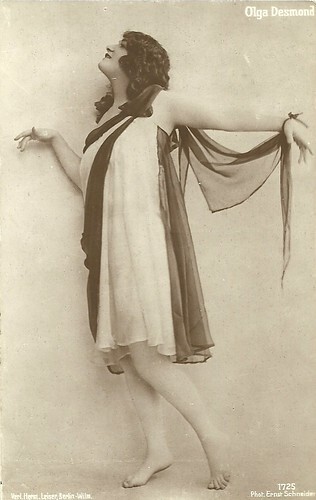
German postcard by Hermann Leiser, Berlin-Wilm., no 1725. Photo: Ernst Schneider. Collection: Didier Hanson.
Olga Desmond (1890-1964) was a German dancer and actress. Desmond was the 'heroine of living pictures' and became one of the first to promote nudity on the stage. From 1916 through 1919 she appeared in various films.
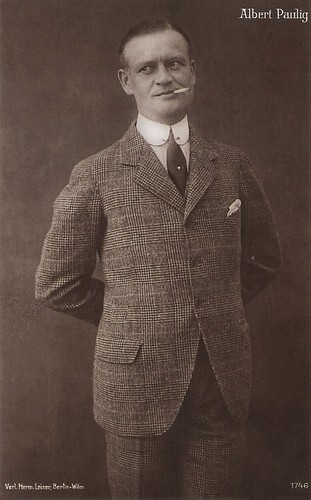
German postcard by Verl. Herm. Leiser, Berlin-Wilm., no. 1746.
Albert Paulig (1873-1933) was a popular actor in the German silent cinema of the 1910s and 1920s.

German postcard by Verlag Hermann Leiser, Berlin-Wilm., no. 1859. Photo: Hugo Erfurth, Dresden.
Maria Fein (1892-1965) was an Austrian actress and theatre director, who peaked as a film star between 1916 and 1919.
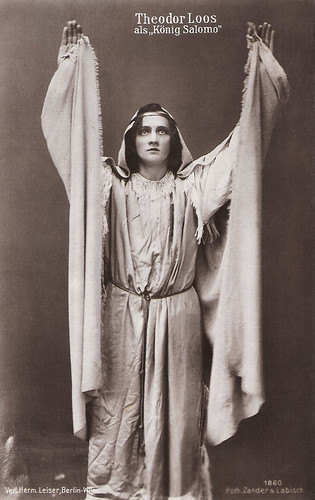
German postcard by Verlag Herm. Leiser, Berlin-Wilm., no. 1860. Photo: Zander & Labisch. Theodor Loos in the play 'König Salomon' (King Solomon).
Theodor Loos (1883-1954) was a German stage and screen actor between the 1910s and the 1950s. He became famous for his parts in Fritz Lang’s German films.
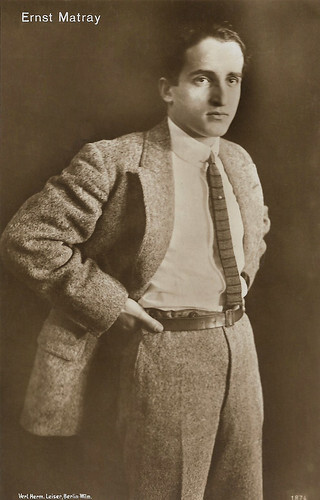
German postcard by Verlag Hermann Leiser, Berlin-Wilm., no. 1874.
Ernst Matráy (1891-1978) was a Hungarian dancer, choreographer, actor and film director. In Berlin, he worked with Max Reinhardt and Ernst Lubitsch. Together with his wife Maria Solveg, he later did the choreography for some classic Hollywood films.
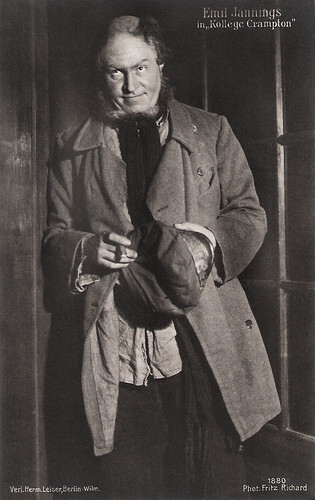
German postcard by Verlag Hermann Leiser, Berlin-Wilm., no. 1880. Photo: Fritz Richard. Emil Jannings in 'Kollege Crampton' by Gerhart Hauptmann.
If Weimar cinema had one film star, then it was Emil Jannings (1884-1950) for sure. He was a great actor in the silent era and won the first Oscar for Best Actor. Priceless are his performances as Louis XV in Lubitsch's Madame Dubarry (1919), as the doorman in Murnau's Der Letzte Mann/The Last Laugh (1924) and as Mephisto in Faust (1926), as the jealous acrobat in Dupont's Variété/Variety (1925) and as the professor in Von Sternberg's Der blaue Engel/The Blue Angel (1930).
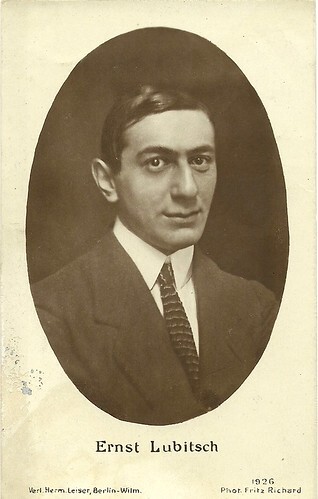
German postcard by Verlag Hermann Leiser, Berlin-Wilm., no. 1926. Photo: Fritz Richard. Collection: Didier Hanson.
Ernst Lubitsch (1892-1947) was a German-American actor, screenwriter, producer and film director. His urbane comedies of manners gave him the reputation of being Hollywood's most elegant and sophisticated director; as his prestige grew, his films were promoted as having ‘the Lubitsch touch.’ He was nominated three times for the Oscar for Best Director and in 1947, he received an Honorary Academy Award.
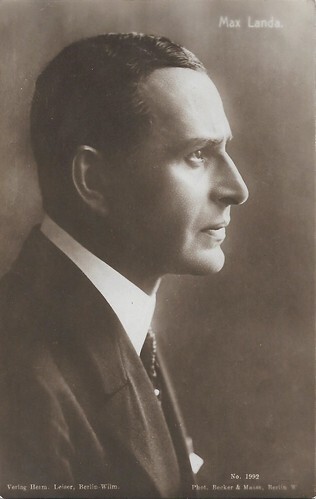
German postcard by Verlag Hermann Leiser, Berlin-Wilm., no. 1992. Photo: Becker & Maass.
Austrian actor Max Landa (1880-1933) started his career in silent films opposite Asta Nielsen. Later he starred as the cosmopolitan gentleman-detective Joe Deebs in the very popular silent serial.
To be continued tomorrow!
Source: Jean Ritsema (Ross Postcards).
Jean's Leiser section is now ready and listed under the 'Other Publishers - German' header. EFSP salutes this milestone with five posts presenting our favourite postcards by Verlag Hermann Leiser. Today the numbers 0-2000.

German postcard by Verlag Hermann Leiser, no. 58.
Danish actor and director Robert Dinesen (1874-1972) made his film debut in Afgrunden/The Abyss (1910) as Asta Nielsen's fiancee. One year later, he directed the successful circus drama De fire djaevle/The Four Devils, in which he also played the lead. It launched a trend of sensational circus dramas, and Dinesen became one of the greatest stars of both the Scandinavian and the German silent cinema.

German postcard by Verlag Hermann Leiser, Berlin-Wilm., no. 185. Photo: Hans Mierendorff.
Hans Mierendorff (1882-1955) was a German stage and film actor and film director. From 1916 he appeared as the gentlemen-detective Harry Higgs, cashing in on the popular trend of German detective films at the time. Mierendorff played in over 100 films.

German postcard by Verlag Hermann Leiser, Berlin-Wilm., no. 220. Photo: Atelier Elite, Berlin.
Ernst Rückert (1886-1950) was a German stage and screen actor. In the 1910s he was a popular film actor, while in the mid-1920s he starred in so-called Prussian films.

German postcard by Verlag Hermann Leiser, Berlin-Wilm., no. 304. Photo: Atelier Eberth, Berlin.
Polish film actress Pola Negri (1894-1987) achieved notoriety as a femme fatale in silent films between the 1910s and 1930s.

German postcard by Verlag Hermann Leiser, Berlin, no. 357. Photo: Greenbaum-Film. Rolf Loer as Phantomas in Das Glück von Lindenberg (Adolf Gärtner, 1918). The film was one of the episodes of the German Phantomas series (1916-1920).
Rolf Loer, real name Lawrence F. Koehler, also Rolf Lör or Rolf Loehr (1892-1964) was a German-American actor, violinist and music teacher. In the late 1910s, he peaked in German silent films as the character Phantomas.

German postcard by Verlag Hermann Leiser, Berlin-Wilm., no. 403. Photo: Nordische Foto-Kunst Braae.
Lya Mara (1897-1960?) was one of the biggest stars of the German silent cinema. Her stardom was even the subject of a novel, which was published in 100 episodes between 1927 and 1928. Her career virtually ended after the arrival of sound film.

German postcard by Verlag Hermann Leiser, Berlin-Wilm., no. 422. Photo: Lili Baruch, Berlin.
German actor Ernst Hofmann (1890-1944) was one of the most attractive actors of the German silent cinema. in the 1910s He was the producer and star of Der Knabe in Blau (1918), the first film by legendary director Friedrich Wilhelm Murnau.

German postcard by Verlag Hermann Leiser, Berlin-Wilm., no. 436. Photo: Zander & Labisch.
Austrian-born stage actress Mady Christians (1892-1951) was a star of the German silent cinema and appeared in Austrian, French, British and Hollywood films too.

German postcard by Verlag Hermann Leiser, Berlin, no. 501. Photo: Zander & Labisch.
Lu L'Arronge (1902-1991) was a German film actress and producer, who between 1917 and 1920 mostly starred in her own productions, impersonating the type of the Backfisch.

German postcard by Verlag Herm. Leiser, Berlin-Wilm., no. 769. Photo: Atelier Eberth, Berlin.
Ernst Deutsch (1890-1969) was an Austrian actor who acted in 42 silent films. He starred in such German Expressionist films as Der Golem, wie er in der Welt kam (1920), and Von morgens bis mitternachts (1920). In 1938 the Jewish actor moved to the USA and worked in Hollywood.
The History of Hermann Leiser
Who was Hermann Leiser? Information relating to Verlag Hermann Leiser is sparse. Jean Ritsema found in her research a close relationship with another publishing firm, Verlag Louis Blumenthal. First, Louis Blumenthal operated solo. Then followed a multi-year partnership between Blumenthal and Hermann Leiser. Finally, it was a solo operation by Hermann Leiser.
Jean discovered that Louis Blumenthal started in Berlin as a merchant at Mohrenstraße 17/18. By 1880, he had expanded to book printing, the paper trade, leather goods, writing materials and office supplies, still at the same address. Blumenthal's residence was nearby, at Mohrenstraße 15. In 1884, the business was relocated to Leipzigerstraße 38, the address that is printed with the text 'Verlag Louis Blumenthal' on early postcards. The firm remained at this address for the duration of Blumenthal's association with it.
Around 1898, Blumenthal was joined by Hermann Leiser in the ownership of the business at Leipzigerstraße, a partnership which lasted for a decade. Around 1909 Hermann Leiser moved to Olivaer Platz 4. In a 1909 advertisement in the Allgemeine Musik Zeitung, he announced the availability of "3000 Portratkärten, Olivaerplatz 4, vorm. Louis Blumenthal". Correspondingly, a number of cards are marked "Verlag Hermann Leiser vormals Louis Blumenthal".
The 1911-1913 address books list Leiser's business on Olivaerplatz 4, with the description of Porträtkarten. At some point, the publisher's mark on the postcards was changed to Verlag Herm. Leiser (in varying forms), dropping the reference to Blumenthal. A final move for Leiser is listed in the 1914 address book which provides a location at Rüdesheimer Platz 3 where Leiser remained through 1931. In many of the later years' entries, his business is described as a "Kaufmann" (merchant), rather than a publisher of Porträtkarten.
Jean Ritsema found it difficult to find a date for when Blumenthal's involvement with postcards began. She discovered a 1903 advertisement in the Monatsschrift für das deutsche Geistesleben, in which Blumenthal's card inventory already numbered over 1000. It also is difficult to know when Leiser's involvement with postcards ended. His listing in the 1929/30 and 1931/32 'Jüdisches Adressbuch for Gross-Berlin' came shortly before the forced transfer of Jewish-owned property to non-Jews in Nazi Germany from 1933 to 1945. The circumstances of Leiser's business and life at that time are unknown. However, in a 1998 monograph by Corinna Müller and Harro Segeberg, 'Die Modellierung des Kinofilms' references the takeover of Leiser by Ross Verlag, stating: 'In Berlin, the Hermann Leiser company began to monopolise the star postcard business. Leiser later became the property of Ross-Verlag, which then also published numerous film star series and was eventually replaced itself in the 1930s by the Ufa-postcard service'.

German postcard by Verlag Hermann Leiser, Berlin- Wilm., no. 770. Photo: Eberth, Berlin.
German stage and film actor Werner Krauss (1884-1959) became a worldwide sensation as the demonic Dr. Caligari in the classic of the German expressionist cinema, Das Kabinett des Doktor Caligari/The Cabinet of Dr. Caligari (1919). He appeared in several silent masterpieces, but his magnificent film career was later overshadowed by his appearance in one of the most notorious propaganda films of the Third Reich.

German postcard by Verlag Hermann Leiser, Berlin-Wilm., no. 781. Photo: N. & C. Hess, Frankfurt a.M.
Max Pallenberg (1877-1934) was an Austrian singer, actor and comedian. He was one of the most important comedians of his time and often played under the direction of Max Reinhardt. Although Pallenberg was successful as a stage comedian, he only incidentally accepted roles in films.

German postcard by Verlag Hermann Leiser, Berlin-Wilm, no. 842. Photo: Imperial-Film.
Grete Lundt aka Grete Lund (1892-1926) was an Austrian stage and screen actress, who played in Austrian and German silent films.

German postcard by Verlag Hermann Leiser, Berlin-Wilm., no. 1007. Photo: Protoscop Co. Hilde Wörner in Das Lächeln der kleinen Beate (Georg Schubert, 1919).
Hilde Wörner (1895-1963) was a German stage and film actress, who also worked as a filmmaker. She appeared mainly in silent films, had her own series and her most notable film was Ernst Lubitsch’s Die Flamme (1922).

German postcard by Verlag Hermann Leiser, no. 1071. Photo: Greenbaum-Film. Albert and Else Bassermann in Der letzte Zeuge/The Last Witness (Adolf Gärtner, 1919).
Albert Bassermann (1867–1952) was one of the first great German stage actors who worked for the cinema. In 1933 he fled the Nazi regime and became an Oscar-nominated stage and film actor in the US.
Else Bassermann , née Elisabeth Sara Schiff (1878-1961) was a German stage and screen actress, who in 1908 married renowned stage actor Albert Bassermann and often performed together with him on stage. When he started to play in the film, she accompanied him.

German postcard by Verlag Hermann Leiser, Berlin-Wilm., no. 1202. Photo: Atelier Lendvai-Dircksen.
German ‘dynamite’ director, actor, producer and screenwriter Harry Piel (1892-1963) made over 150 sensational films full of explosions and stunts.

German postcard by Verl. Hermann Leiser, Berlin-Wilm., no. 1210. Photo: Becker & Maass, Berlin. Paul Wegener and Tilla Durieux in the stage production of 'Der Graf von Gleichen' by the Berliner Kammerspiele in 1909.
German actor, writer and film director Paul Wegener (1874-1948) is one of the true fathers of the horror and fantasy genre, particularly remembered for his three silent films centred around the Jewish legend of the Golem. Wegener was one of the pioneers of German cinema who realized the potential of the new medium and used the possibilities of cinematic trick photography as a method for presenting fantastic tales in a serious matter.

German postcard by Verlag Hermann Leiser, Berlin, no. 1233. Photo: Becker & Maass, Berlin. Paul Wegener in the play 'Der Arzt am Scheideweg' (The Doctor's Dilemma) by George Bernhard Shaw.

German postcard by Verlag Hermann Leiser, no. 1254. Photo: Atelier Badekow, Berlin.
German actress Hanni Weisse (1892-1967) belonged to the great film divas of the early German silent film. She was able to maintain her stardom till the 1920s.

German postcard by Verlag Hermann Leiser, Berlin-Wilm., no. 1433. Photo: Filmatelier Hansa.
Carola Toelle (1893-1958) was a German actress, in particular in German silent cinema of the late 1910s and early 1920s.

German postcard by Verlag Hermann Leiser, no. 1463. Photo: Berliner Illustrierte, Berlin. 1910s.
Alfred Abel (1879-1937) played in over 140 silent and sound films between 1913 and 1938. He is best known as the industrial Fredersen in Fritz Lang's Metropolis (1927).

German postcard by Verlag Hermann Leiser, Berlin, no. 1464. Photo: Pm.
Grete Weixler (ca. 1900- after 1922) was a German actress of the silent cinema. From 1914 on, she appeared in secondary roles in melodramas by directors like Carl Boese, Friedrich Zelnik and Lupu Pick.

German postcard by Verlag Hermann Leiser, Berlin-Wilm., no. 1523. Photo: Gerlach & Co., Berlin.
Wanda Treumann (1883-1963) was a German actress and film producer. Together with Viggo Larsen, she produced many films in the 1910s, in which she also often had the female lead.

German postcard by Verlag Hermann Leiser, Berlin-Wilm., no. 1645. Photo: Willinger.
German actress, writer and producer Hedda Vernon (1886-1925) appeared in more than 60 films of the early silent period. During the 1910s she was such a popular film star that she got her own Hedda-Vernon serial.

German postcard by Hermann Leiser, Berlin-Wilm., no 1725. Photo: Ernst Schneider. Collection: Didier Hanson.
Olga Desmond (1890-1964) was a German dancer and actress. Desmond was the 'heroine of living pictures' and became one of the first to promote nudity on the stage. From 1916 through 1919 she appeared in various films.

German postcard by Verl. Herm. Leiser, Berlin-Wilm., no. 1746.
Albert Paulig (1873-1933) was a popular actor in the German silent cinema of the 1910s and 1920s.

German postcard by Verlag Hermann Leiser, Berlin-Wilm., no. 1859. Photo: Hugo Erfurth, Dresden.
Maria Fein (1892-1965) was an Austrian actress and theatre director, who peaked as a film star between 1916 and 1919.

German postcard by Verlag Herm. Leiser, Berlin-Wilm., no. 1860. Photo: Zander & Labisch. Theodor Loos in the play 'König Salomon' (King Solomon).
Theodor Loos (1883-1954) was a German stage and screen actor between the 1910s and the 1950s. He became famous for his parts in Fritz Lang’s German films.

German postcard by Verlag Hermann Leiser, Berlin-Wilm., no. 1874.
Ernst Matráy (1891-1978) was a Hungarian dancer, choreographer, actor and film director. In Berlin, he worked with Max Reinhardt and Ernst Lubitsch. Together with his wife Maria Solveg, he later did the choreography for some classic Hollywood films.

German postcard by Verlag Hermann Leiser, Berlin-Wilm., no. 1880. Photo: Fritz Richard. Emil Jannings in 'Kollege Crampton' by Gerhart Hauptmann.
If Weimar cinema had one film star, then it was Emil Jannings (1884-1950) for sure. He was a great actor in the silent era and won the first Oscar for Best Actor. Priceless are his performances as Louis XV in Lubitsch's Madame Dubarry (1919), as the doorman in Murnau's Der Letzte Mann/The Last Laugh (1924) and as Mephisto in Faust (1926), as the jealous acrobat in Dupont's Variété/Variety (1925) and as the professor in Von Sternberg's Der blaue Engel/The Blue Angel (1930).

German postcard by Verlag Hermann Leiser, Berlin-Wilm., no. 1926. Photo: Fritz Richard. Collection: Didier Hanson.
Ernst Lubitsch (1892-1947) was a German-American actor, screenwriter, producer and film director. His urbane comedies of manners gave him the reputation of being Hollywood's most elegant and sophisticated director; as his prestige grew, his films were promoted as having ‘the Lubitsch touch.’ He was nominated three times for the Oscar for Best Director and in 1947, he received an Honorary Academy Award.

German postcard by Verlag Hermann Leiser, Berlin-Wilm., no. 1992. Photo: Becker & Maass.
Austrian actor Max Landa (1880-1933) started his career in silent films opposite Asta Nielsen. Later he starred as the cosmopolitan gentleman-detective Joe Deebs in the very popular silent serial.
To be continued tomorrow!
Source: Jean Ritsema (Ross Postcards).
Published on December 24, 2023 22:00
December 23, 2023
The King of Kings (1927)
American silent epic The King of Kings (1927) was produced and directed by Cecil B. DeMille. It was the second in DeMille's biblical trilogy, preceded by The Ten Commandments (1923) and followed by The Sign of the Cross (1932). The King of Kings depicts the last weeks of Jesus before his crucifixion and stars H. B. Warner in the lead role. This classic DeMille shows his storytelling talent and his showmanship by delivering a spectacle like no other. The film has two Technicolor sequences, the beginning and the resurrection scene, which use the two-strip process invented by Herbert Kalmus. The King of Kings was the first film premiered at Grauman's Chinese Theater in Los Angeles on 18 May 1927. The postcards in this post were made in Germany, France and Austria, and the stills were made by William Mortensen with a hand-held camera.

German postcard by Ross Verlag, no. 86/1. Photo: National Film. Dorothy Cumming as the Virgin Mary in Cecil B. deMille's The King of Kings (1927). Caption: Mary and the blind girl.
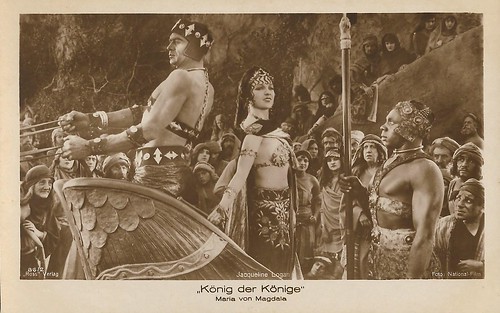
German postcard by Ross Verlag, no. 86/2. Photo: National Film. Postcard for the American silent epic The King of Kings (Cecil B. DeMille, 1927). Caption: Mary Magdalene. The charioteer was played by Noble Johnson, while Jacqueline Logan played Mary Magdalene.
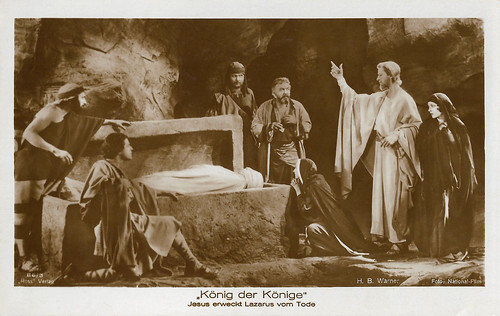
German postcard by Ross Verlag, no. 86/3. Photo: National Film. Postcard for the American silent epic The King of Kings (Cecil B. DeMille, 1927). Caption: Jesus (H.B. Warner) resurrects Lazarus from the Dead.
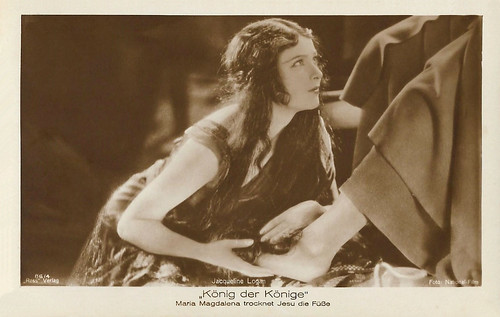
German postcard by Ross Verlag, no. 86/4. Photo: National Film. Postcard for the American silent epic The King of Kings (Cecil B. DeMille, 1927). Caption: Mary Magdalene ( Jacqueline Logan ) dries Jesus' feet.
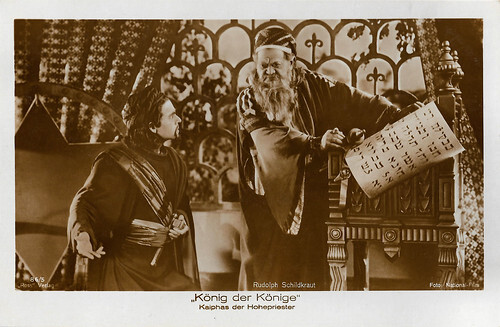
German postcard by Ross Verlag, no. 86/5. Photo: National-Film. Postcard for the American silent epic The King of Kings (Cecil B. DeMille, 1927). Caption: Caiaphas the High Priest of Israel (Rudolph Schildkraut).
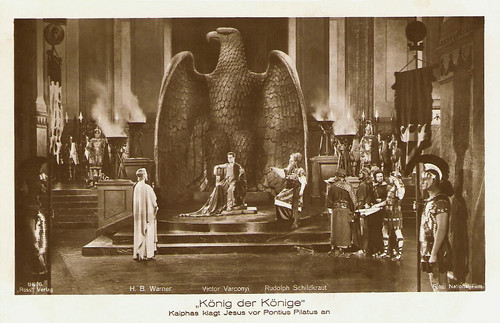
German postcard by Ross Verlag, no. 86/6. Photo: National-Film. Publicity still for King of Kings (Cecil B. De Mille, 1927). Caption: Caiphas accuses Jesus before Pontius Pilate. Victor Varconi as Pontius Pilate the Governor of Judea, H.B. Warner as Jesus and Rudolph Schildkraut as Caiaphas.
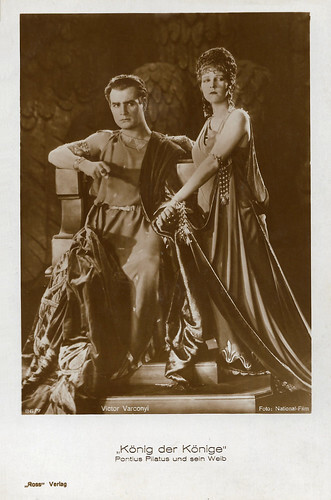
German postcard by Ross Verlag, no. 86/7. Photo: National-Film. Victor Varconi and Majel Coleman in The King of Kings (Cecil B. DeMille, 1927). Caption: Pontius Pilate and his wife.
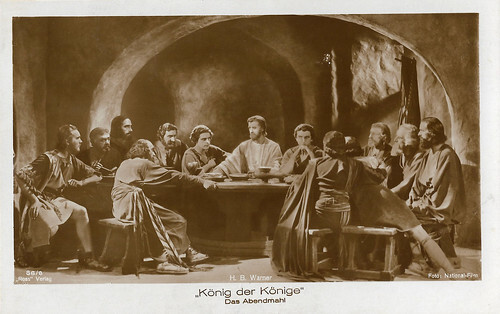
German postcard by Ross Verlag, no. 86/8. Photo: National-Film. Postcard for the American silent epic The King of Kings (Cecil B. DeMille, 1927). Caption: The Last Supper.
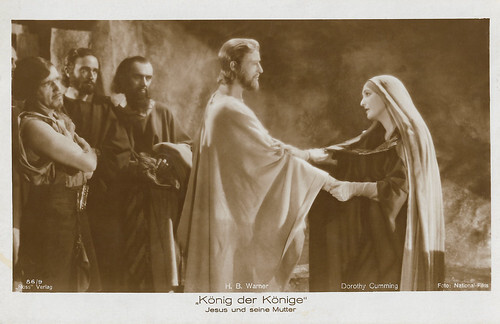
German postcard by Ross Verlag, no. 86/9. Photo: National-Film. Postcard for the American silent epic The King of Kings (Cecil B. DeMille, 1927). Caption: Jesus (H.B. Warner) and his Mother (Dorothy Cumming).
Equal amounts of showmanship and reverence
Hal Erickson at AllMovie : "Having scored big-time box office with his first Biblical epic, The Ten Commandments (1923), Cecil B. DeMille hoped to top this success with his 1927 The King of Kings. Since he was now dealing with the life of Christ, DeMille had to be careful to serve up equal amounts of showmanship and reverence.
The first creative challenge: how to "introduce" Christ tastefully? The answer: as a blind child is cured through Jesus' intervention, DeMille cuts to the child's point-of-view, slowly fading in on the kindly countenance of H.B. Warner as the Son of Man.
Still, DeMille remained DeMille, especially in his handling of the character of Mary Magdalene (Jacqueline Logan). No longer a tattered streetwalker, Mary Magdalene is now a glamorous courtesan, replete with legions of gorgeous slave girls."
"Once he's gotten his box-office considerations out of the way, DeMille adheres faithfully to the particulars of Jesus' life, betrayal, trial, Crucifixion, and Resurrection. (Again, however, the director improves a bit upon his source material: the storm that follows the Crucifixion is of the same spectacular dimensions as the parting of the Red Sea in Ten Commandments, while the Resurrection is filmed in vibrant Technicolor).
To back up the authenticity of his images, DeMille - with an assist from scenarist Jeannie Macpherson - utilizes Scriptural quotes in his subtitles." The King of Kings is the first film in which stills were made by a hand-held camera. Photographer William Mortenson made four hundred negatives that capture scenes as they were being shot, not posed afterwards.
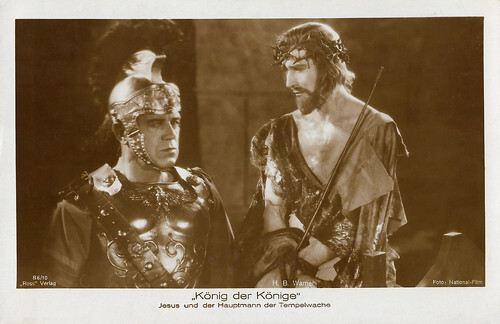
German postcard by Ross Verlag, no. 86/10. Photo: National-Film. Postcard for the American silent epic The King of Kings (Cecil B. DeMille, 1927). Caption: Jesus (H.B. Warner) and the Captain of the Temple Guards (Theodore Kosloff).
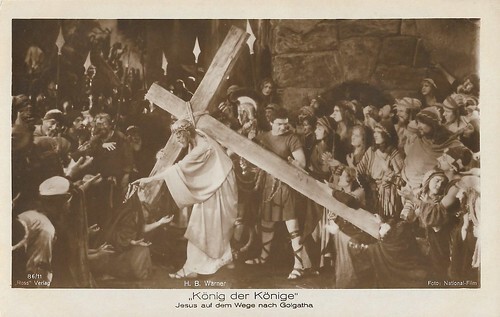
German postcard by Ross Verlag, no. 86/11. Photo: National Film. Postcard for the American silent epic The King of Kings (Cecil B. DeMille, 1927). Caption: Jesus (H.B. Warner) on the way to Golgotha. The man helping to carry the cross could be William Boyd, who played Simon of Cyrene.
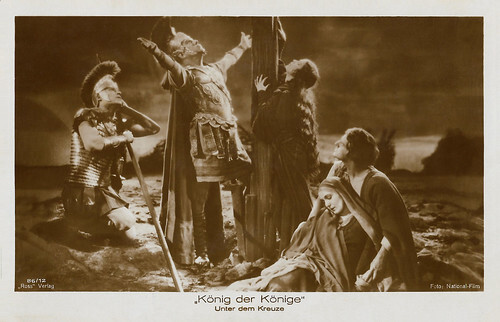
German postcard by Ross Verlag, no. 86/12. Photo: National Film. Postcard for the American silent epic The King of Kings (Cecil B. DeMille, 1927). Caption: Under the Cross.
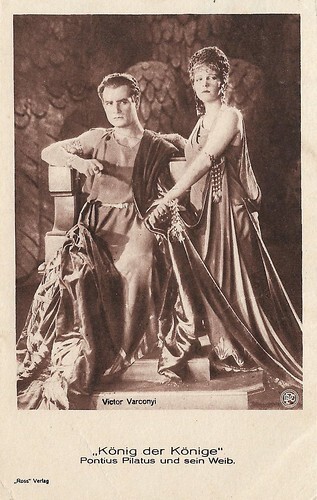
German postcard by Ross Verlag, unnumbered. Photo: DPG (Deutsche Photographische Gesellschaft). Postcard for the American silent epic The King of Kings (Cecil B. DeMille, 1927). Caption: Pontius Pilate and his wife. Pilate was played by Victor Varconi , and his wife Proculla by Majel Coleman.
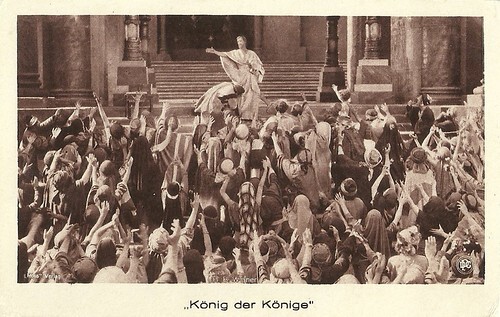
German postcard by Ross Verlag, unnumbered. Photo: DPG (Deutsche Photographische Gesellschaft). Postcard for the American silent epic The King of Kings (Cecil B. DeMille, 1927) with H.B. Warner as Jesus.
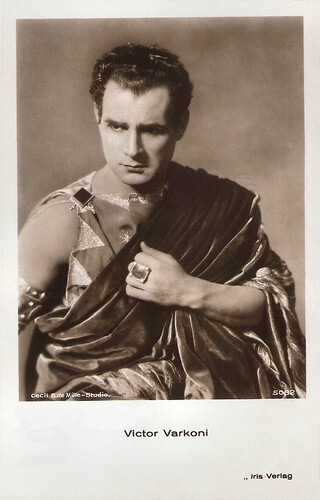
Austrian postcard by Iris Verlag, no. 5062. Photo: Cecil B. de Mille-Studio. Publicity still for The King of Kings (Cecil B. DeMille, 1927). Victor Varconi as Pontus Pilate.
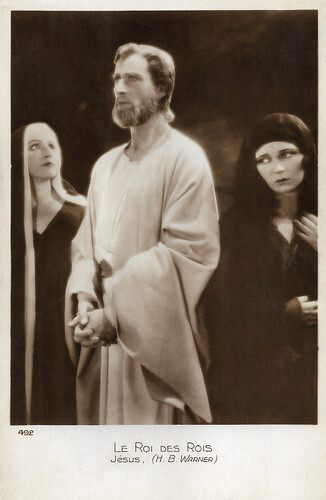
French postcard, no. 492. Photo: Erka Prodisco. H.B. Warner as Jesus between Dorothy Cumming as the Virgin Mary and Jacqueline Logan as Mary Magdalene in The King of Kings (Cecil B. DeMille, 1927).
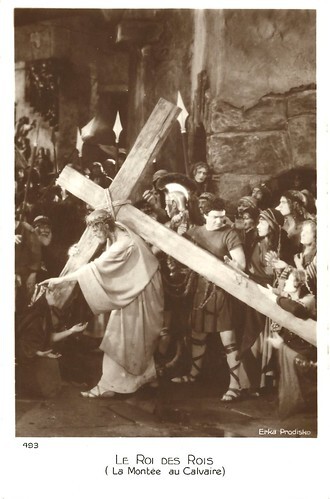
French postcard, no. 493. Photo: Erka Prodisco. H.B. Warner as Jesus Christ in The King of Kings (Cecil B. DeMille, 1927). Caption: On the way to Golgotha. The man helping to carry the cross could be William Boyd , who played Simon of Cyrene.
Sources: David Fahey and Linda Rich (Masters of Starlight), Hal Erickson (AllMovie), Wikipedia and IMDb.

German postcard by Ross Verlag, no. 86/1. Photo: National Film. Dorothy Cumming as the Virgin Mary in Cecil B. deMille's The King of Kings (1927). Caption: Mary and the blind girl.

German postcard by Ross Verlag, no. 86/2. Photo: National Film. Postcard for the American silent epic The King of Kings (Cecil B. DeMille, 1927). Caption: Mary Magdalene. The charioteer was played by Noble Johnson, while Jacqueline Logan played Mary Magdalene.

German postcard by Ross Verlag, no. 86/3. Photo: National Film. Postcard for the American silent epic The King of Kings (Cecil B. DeMille, 1927). Caption: Jesus (H.B. Warner) resurrects Lazarus from the Dead.

German postcard by Ross Verlag, no. 86/4. Photo: National Film. Postcard for the American silent epic The King of Kings (Cecil B. DeMille, 1927). Caption: Mary Magdalene ( Jacqueline Logan ) dries Jesus' feet.

German postcard by Ross Verlag, no. 86/5. Photo: National-Film. Postcard for the American silent epic The King of Kings (Cecil B. DeMille, 1927). Caption: Caiaphas the High Priest of Israel (Rudolph Schildkraut).

German postcard by Ross Verlag, no. 86/6. Photo: National-Film. Publicity still for King of Kings (Cecil B. De Mille, 1927). Caption: Caiphas accuses Jesus before Pontius Pilate. Victor Varconi as Pontius Pilate the Governor of Judea, H.B. Warner as Jesus and Rudolph Schildkraut as Caiaphas.

German postcard by Ross Verlag, no. 86/7. Photo: National-Film. Victor Varconi and Majel Coleman in The King of Kings (Cecil B. DeMille, 1927). Caption: Pontius Pilate and his wife.

German postcard by Ross Verlag, no. 86/8. Photo: National-Film. Postcard for the American silent epic The King of Kings (Cecil B. DeMille, 1927). Caption: The Last Supper.

German postcard by Ross Verlag, no. 86/9. Photo: National-Film. Postcard for the American silent epic The King of Kings (Cecil B. DeMille, 1927). Caption: Jesus (H.B. Warner) and his Mother (Dorothy Cumming).
Equal amounts of showmanship and reverence
Hal Erickson at AllMovie : "Having scored big-time box office with his first Biblical epic, The Ten Commandments (1923), Cecil B. DeMille hoped to top this success with his 1927 The King of Kings. Since he was now dealing with the life of Christ, DeMille had to be careful to serve up equal amounts of showmanship and reverence.
The first creative challenge: how to "introduce" Christ tastefully? The answer: as a blind child is cured through Jesus' intervention, DeMille cuts to the child's point-of-view, slowly fading in on the kindly countenance of H.B. Warner as the Son of Man.
Still, DeMille remained DeMille, especially in his handling of the character of Mary Magdalene (Jacqueline Logan). No longer a tattered streetwalker, Mary Magdalene is now a glamorous courtesan, replete with legions of gorgeous slave girls."
"Once he's gotten his box-office considerations out of the way, DeMille adheres faithfully to the particulars of Jesus' life, betrayal, trial, Crucifixion, and Resurrection. (Again, however, the director improves a bit upon his source material: the storm that follows the Crucifixion is of the same spectacular dimensions as the parting of the Red Sea in Ten Commandments, while the Resurrection is filmed in vibrant Technicolor).
To back up the authenticity of his images, DeMille - with an assist from scenarist Jeannie Macpherson - utilizes Scriptural quotes in his subtitles." The King of Kings is the first film in which stills were made by a hand-held camera. Photographer William Mortenson made four hundred negatives that capture scenes as they were being shot, not posed afterwards.

German postcard by Ross Verlag, no. 86/10. Photo: National-Film. Postcard for the American silent epic The King of Kings (Cecil B. DeMille, 1927). Caption: Jesus (H.B. Warner) and the Captain of the Temple Guards (Theodore Kosloff).

German postcard by Ross Verlag, no. 86/11. Photo: National Film. Postcard for the American silent epic The King of Kings (Cecil B. DeMille, 1927). Caption: Jesus (H.B. Warner) on the way to Golgotha. The man helping to carry the cross could be William Boyd, who played Simon of Cyrene.

German postcard by Ross Verlag, no. 86/12. Photo: National Film. Postcard for the American silent epic The King of Kings (Cecil B. DeMille, 1927). Caption: Under the Cross.

German postcard by Ross Verlag, unnumbered. Photo: DPG (Deutsche Photographische Gesellschaft). Postcard for the American silent epic The King of Kings (Cecil B. DeMille, 1927). Caption: Pontius Pilate and his wife. Pilate was played by Victor Varconi , and his wife Proculla by Majel Coleman.

German postcard by Ross Verlag, unnumbered. Photo: DPG (Deutsche Photographische Gesellschaft). Postcard for the American silent epic The King of Kings (Cecil B. DeMille, 1927) with H.B. Warner as Jesus.

Austrian postcard by Iris Verlag, no. 5062. Photo: Cecil B. de Mille-Studio. Publicity still for The King of Kings (Cecil B. DeMille, 1927). Victor Varconi as Pontus Pilate.

French postcard, no. 492. Photo: Erka Prodisco. H.B. Warner as Jesus between Dorothy Cumming as the Virgin Mary and Jacqueline Logan as Mary Magdalene in The King of Kings (Cecil B. DeMille, 1927).

French postcard, no. 493. Photo: Erka Prodisco. H.B. Warner as Jesus Christ in The King of Kings (Cecil B. DeMille, 1927). Caption: On the way to Golgotha. The man helping to carry the cross could be William Boyd , who played Simon of Cyrene.
Sources: David Fahey and Linda Rich (Masters of Starlight), Hal Erickson (AllMovie), Wikipedia and IMDb.
Published on December 23, 2023 22:00
December 21, 2023
Omar Sharif
Egyptian actor Omar Sharif (1932-2015) is best known for playing Sherif Ali in Lawrence of Arabia (1962) and the title role in Doctor Zhivago (1965). Sharif appeared in numerous Egyptian films until the early 1960s. His career encompassed over 100 films spanning 50 years and brought him many accolades including three Golden Globe Awards and a César Award for Best Actor.
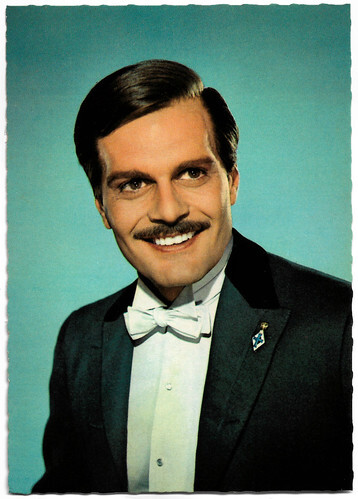
German postcard by ISV, no. H 140.
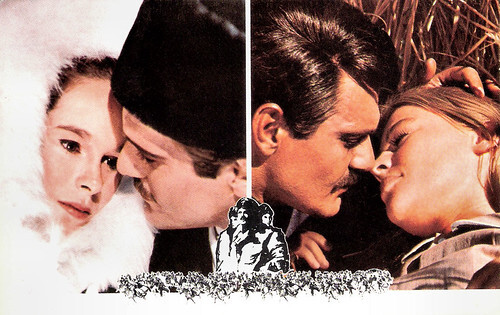
American postcard. Photo: MGM. Photo: Geraldine Chaplin , Omar Sharif and Julie Christie in Dr. Zhivago (David Lean, 1965).
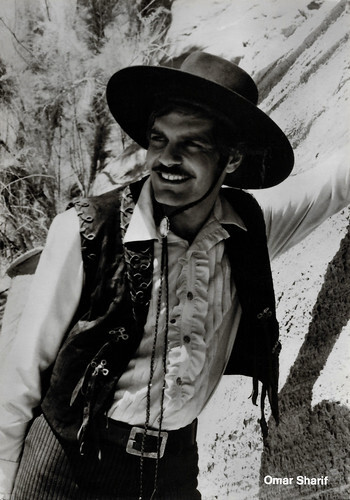
East-German postcard by VEB Progress Film-Vertrieb, Berlin, no. 15/70 D. Omar Sharif in Mackenna's Gold (J. Lee Thompson, 1969).
A box office hit in the Soviet Union
Omar Sharif (Arabian: عمر الشريـف) was born Michel Demitri Shalhoub in 1932 in Alexandria, Egypt to Joseph Shalhoub, a lumber merchant, and his wife, Claire (Saada). Of Lebanese and Syrian extraction, the young Michel was raised a Roman Catholic. He was educated at Victoria College in Alexandria and took a degree in mathematics and physics from Cairo University with a major. Afterwards graduating from university, he entered the family lumber business.
The handsome Sharif became a star in Egyptian cinema. His first film was the Egyptian film Siraa Fil-Wadi/The Blazing Sky (Youssef Chahine, 1954), opposite the renowned Egyptian actress Faten Hamama. The film was presented at the 1954 Cannes Film Festival and was a box office hit in the Soviet Union, where it sold 25.8 million tickets in 1956.
He married Faten Hamama in 1955. He converted to Islam to marry her and took the name Omar al-Sharif. He quickly rose to stardom in Shaytan al-Sahra/The Devil of the Desert (Youssef Chahine, 1954) and Ayyamna al-Holwa/Our Beautiful Days (Helmy Halim, 1954). He also appeared in the French film La Châtelaine du Liban/The Lebanese Mission (Richard Pottier, 1956) starring Jean-Claude Pascal and Gianna Maria Canale .
He and his wife Faten Hamama co-starred as romantic leads in such films in such Egyptian films as Sira` Fi al-Mina/Struggle in the Pier (Youssef Chahine, 1956), La Anam/Sleepless (Salah Abouseif, Tolba Radwan, 1957) and Ard al-Salam/Land of Peace (Kamal El Sheikh, 1957). He also appeared in the French-Tunisian film Goha (Jacques Baratier, 1958), which marked the debut of Claudia Cardinale .
Successful were also the Egyptian films Sayyidat al-Qasr/Lady of the Palace (Kamal El Sheikh, 1958), Sira‘ Fi Al Nil/Struggle on the Nile (Atef Salem, 1959), Bidaya wa nihaya/The Beginning and the End (Salah Abouseif, 1960), Eshaet Hob/A Rumor of Love (Fatin Abdel Wahab, 1960), and the 'Anna Karenina' adaptation Nahr al-Ḥub/The River of Love (Ezz El-Dine Zulficar, 1960). These films made him a huge competitor to Salah Zulfikar, Shoukry Sarhan and Rushdy Abaza, the Egyptian cinema giants at the time.
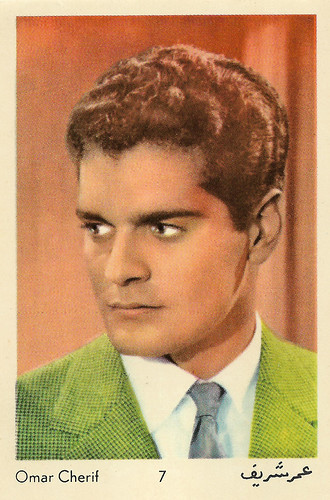
Egyptian collectors card, no. 7.
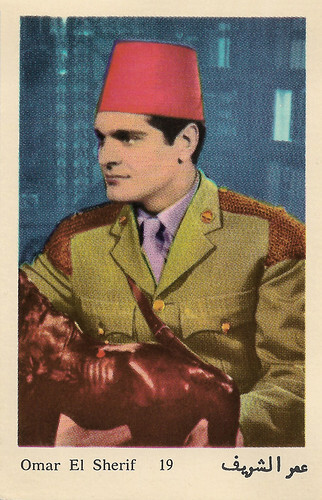
Egyptian collectors card, no. 29.
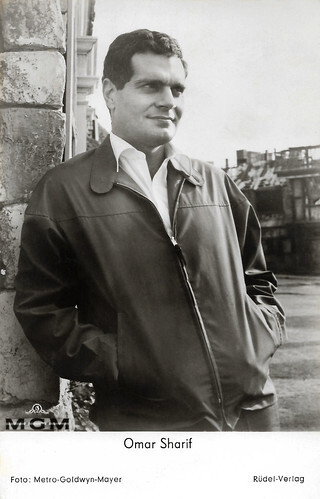
West German postcard by Rüdel-Verlag (Franz Josef Rüdel, Filmpostkartenverlag), Hamburg, no. 4751. Photo: Metro-Goldwyn-Mayer (MGM). Omar Sharif in C'era una volta/More Than a Miracle (Francesco Rosi, 1967).
Persona non grata in Egypt
Omar Sharif made his English-language film debut in the monumental film Lawrence of Arabia (David Lean, 1962), starring Peter O'Toole , Alec Guinness and Anthony Quinn . He played Sherif Ali who was introduced in a famous scene: Sherif rides towards the camera for minutes, coming from the desert horizon.
Lawrence of Arabia was a box office and critical sensation. Sharif was honoured with the Golden Globe Award for Best Newcomer and an Oscar nomination for Best Supporting Actor. The film made Sharif a sought-after star and he played roles in international productions such as The Fall of the Roman Empire (Anthony Mann, 1964) and Genghis Khan (Henry Levin, 1965).
In 1965, Omar Sharif got the coveted title role in one of the most lavish film projects of the 1960s, the monumental film Doctor Zhivago (David Lean, 1965), an adaptation of Boris Pasternak's 1957 novel. Sharif plays a young doctor who falls in love with a nurse ( Julie Christie ) against the backdrop of the Russian Revolution. The huge success of this classic film, which was one of the biggest box office hits of the decade, established Sharif as a top international star and heartthrob.
He was considered such a box office draw that he was cast as a German army officer in the film The Night of the Generals (Anatole Litvak, 1967) alongside Peter O'Toole . His casting as Crown Prince Rudolf of Austria-Hungary a year later in the historical film Mayerling (Terence Young, 1968) was similarly daring. The musical Funny Girl (William Wyler, 1968), in which Sharif played the second leading role alongside Barbra Streisand , was a great success. Shortly after the Six-Day War in 1967, the on-screen romance between the Jewish Streisand and the Egyptian Muslim Sharif not only hit the headlines. It made him persona non grata in Egypt.
For almost ten years, he was no longer allowed to enter his home country. Sharif played Che Guevara in Che! (Richard Fleischer, 1969) and Colorado in Mackenna's Gold (J. Lee Thompson, 1969), but he was no longer able to build on his earlier successes and ultimately lost his status as a box office star.
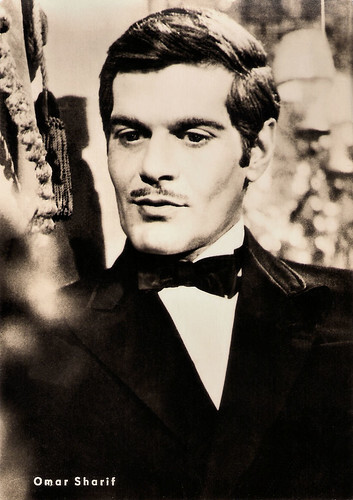
East-German postcard by VEB Progress Film-Vertrieb, Berlin, no. 185/70. Omar Sharif in Funny Girl (William Wyler, 1968).
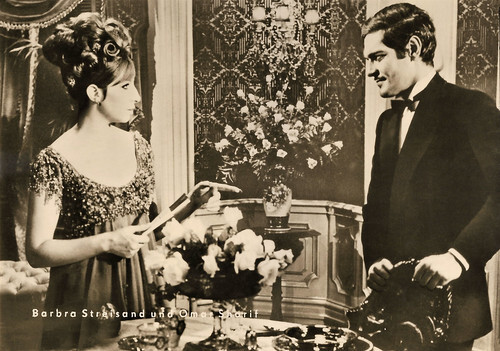
East-German postcard by VEB Progress Film-Vertrieb, Berlin, no. 209/70. Photo: Columbia. Barbra Streisand and Omar Sharif in Funny Girl (William Wyler, 1968).
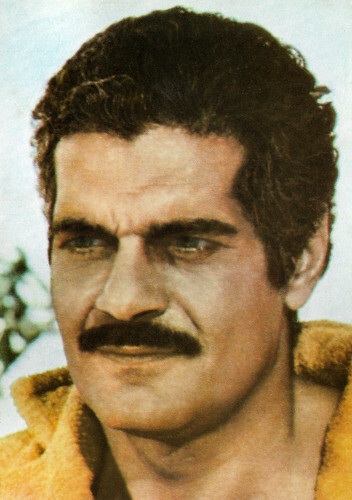
Romanian postcard by Casa Filmului Acin.
One of the world's best-known contract bridge players
In the 1970s, Omar Sharif's roles and films became increasingly insignificant. Sharif had to accept many second-rate films because he had money problems. In 1974 he and Faten Hamama divorced. The couple had one child, Tarek Sharif (1957) who portrayed the young Zhivago in the eponymous picture. Sharif never remarried.
Beginning in the 1960s, Omar Sharif earned a reputation as one of the world's best-known contract bridge players. In the 1970s and 1980s, he co-wrote a syndicated newspaper bridge column for the Chicago Tribune. Sharif also wrote several books on bridge and has licensed his name to a bridge computer game, "Omar Sharif Bridge", which has been marketed since 1992.
From the 1980s onwards, Sharif mainly appeared in television series, supporting roles, low-budget productions and Egyptian films. Sharif told the press in 2006 that he no longer played bridge, explaining, "I decided I didn't want to be a slave to any passion except for my work. I had too many passions, bridge, horses, gambling. I want to live a different kind of life and be with my family more because I didn't give them enough time."
As an actor, Sharif made a comeback in 2003 playing the title role of an elderly Muslim Turkish shopkeeper who becomes a father figure for a Jewish boy in the French film Monsieur Ibrahim et les fleurs du Coran/Monsieur Ibrahim (François Dupeyron, 2003). For his performance, he won the Best Actor Award at the Venice Film Festival and the Best Actor César, France's equivalent of the Oscar, from the Académie des Arts et Techniques du Cinéma. Sharif's later film roles included performances in Hidalgo (Joe Johnston, 2004) with Viggo Mortensen, the Italian TV film San Pietro/Imperium: Saint Peter (Giulio Base, 2005), and One Night with the King (Michael O. Sajbel, 2005) in which he reunited with Peter O'Toole .
Omar Sharif died of a heart attack in 2015, in Cairo, Egypt. In later life, Sharif lived mostly in Cairo with his family and his last partner Andréa Ferréol. In addition to his son Tarek Sharif, he had two grandsons, Omar Sharif Jr and Karim Sharif. Omar Sharif Jr is also an actor.
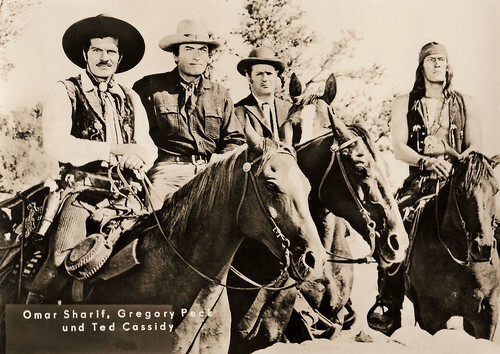
East-German postcard by VEB Progress Film-Vertrieb, Berlin, no. 215/70, 1970. Photo: Omar Sharif, Gregory Peck, Eli Wallach, and Ted Cassidy in Mackenna's Gold (J. Lee Thompson, 1969).
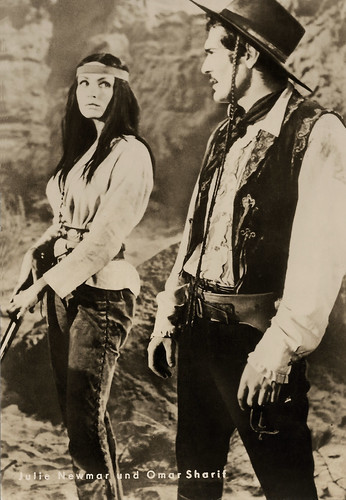
East-German postcard by VEB Progress Film-Vertrieb, Berlin, no. 206/70. Julie Newmar and Omar Sharif in Mackenna's Gold (J. Lee Thompson, 1969).
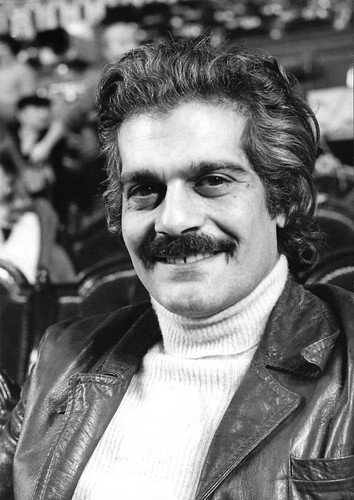
Dutch press photo by KIPPA, Amsterdam. Photo for the TV registration of the Unicef Ballet Gala on 31 December 1972. The ballets were presented by Omar Sharif, Romy Schneider and Ann Miller .
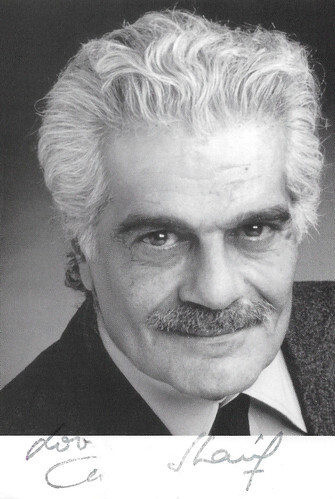
Vintage autograph card.
Sources: (IMDb), Wikipedia (German, Dutch and English) and .

German postcard by ISV, no. H 140.

American postcard. Photo: MGM. Photo: Geraldine Chaplin , Omar Sharif and Julie Christie in Dr. Zhivago (David Lean, 1965).

East-German postcard by VEB Progress Film-Vertrieb, Berlin, no. 15/70 D. Omar Sharif in Mackenna's Gold (J. Lee Thompson, 1969).
A box office hit in the Soviet Union
Omar Sharif (Arabian: عمر الشريـف) was born Michel Demitri Shalhoub in 1932 in Alexandria, Egypt to Joseph Shalhoub, a lumber merchant, and his wife, Claire (Saada). Of Lebanese and Syrian extraction, the young Michel was raised a Roman Catholic. He was educated at Victoria College in Alexandria and took a degree in mathematics and physics from Cairo University with a major. Afterwards graduating from university, he entered the family lumber business.
The handsome Sharif became a star in Egyptian cinema. His first film was the Egyptian film Siraa Fil-Wadi/The Blazing Sky (Youssef Chahine, 1954), opposite the renowned Egyptian actress Faten Hamama. The film was presented at the 1954 Cannes Film Festival and was a box office hit in the Soviet Union, where it sold 25.8 million tickets in 1956.
He married Faten Hamama in 1955. He converted to Islam to marry her and took the name Omar al-Sharif. He quickly rose to stardom in Shaytan al-Sahra/The Devil of the Desert (Youssef Chahine, 1954) and Ayyamna al-Holwa/Our Beautiful Days (Helmy Halim, 1954). He also appeared in the French film La Châtelaine du Liban/The Lebanese Mission (Richard Pottier, 1956) starring Jean-Claude Pascal and Gianna Maria Canale .
He and his wife Faten Hamama co-starred as romantic leads in such films in such Egyptian films as Sira` Fi al-Mina/Struggle in the Pier (Youssef Chahine, 1956), La Anam/Sleepless (Salah Abouseif, Tolba Radwan, 1957) and Ard al-Salam/Land of Peace (Kamal El Sheikh, 1957). He also appeared in the French-Tunisian film Goha (Jacques Baratier, 1958), which marked the debut of Claudia Cardinale .
Successful were also the Egyptian films Sayyidat al-Qasr/Lady of the Palace (Kamal El Sheikh, 1958), Sira‘ Fi Al Nil/Struggle on the Nile (Atef Salem, 1959), Bidaya wa nihaya/The Beginning and the End (Salah Abouseif, 1960), Eshaet Hob/A Rumor of Love (Fatin Abdel Wahab, 1960), and the 'Anna Karenina' adaptation Nahr al-Ḥub/The River of Love (Ezz El-Dine Zulficar, 1960). These films made him a huge competitor to Salah Zulfikar, Shoukry Sarhan and Rushdy Abaza, the Egyptian cinema giants at the time.

Egyptian collectors card, no. 7.

Egyptian collectors card, no. 29.

West German postcard by Rüdel-Verlag (Franz Josef Rüdel, Filmpostkartenverlag), Hamburg, no. 4751. Photo: Metro-Goldwyn-Mayer (MGM). Omar Sharif in C'era una volta/More Than a Miracle (Francesco Rosi, 1967).
Persona non grata in Egypt
Omar Sharif made his English-language film debut in the monumental film Lawrence of Arabia (David Lean, 1962), starring Peter O'Toole , Alec Guinness and Anthony Quinn . He played Sherif Ali who was introduced in a famous scene: Sherif rides towards the camera for minutes, coming from the desert horizon.
Lawrence of Arabia was a box office and critical sensation. Sharif was honoured with the Golden Globe Award for Best Newcomer and an Oscar nomination for Best Supporting Actor. The film made Sharif a sought-after star and he played roles in international productions such as The Fall of the Roman Empire (Anthony Mann, 1964) and Genghis Khan (Henry Levin, 1965).
In 1965, Omar Sharif got the coveted title role in one of the most lavish film projects of the 1960s, the monumental film Doctor Zhivago (David Lean, 1965), an adaptation of Boris Pasternak's 1957 novel. Sharif plays a young doctor who falls in love with a nurse ( Julie Christie ) against the backdrop of the Russian Revolution. The huge success of this classic film, which was one of the biggest box office hits of the decade, established Sharif as a top international star and heartthrob.
He was considered such a box office draw that he was cast as a German army officer in the film The Night of the Generals (Anatole Litvak, 1967) alongside Peter O'Toole . His casting as Crown Prince Rudolf of Austria-Hungary a year later in the historical film Mayerling (Terence Young, 1968) was similarly daring. The musical Funny Girl (William Wyler, 1968), in which Sharif played the second leading role alongside Barbra Streisand , was a great success. Shortly after the Six-Day War in 1967, the on-screen romance between the Jewish Streisand and the Egyptian Muslim Sharif not only hit the headlines. It made him persona non grata in Egypt.
For almost ten years, he was no longer allowed to enter his home country. Sharif played Che Guevara in Che! (Richard Fleischer, 1969) and Colorado in Mackenna's Gold (J. Lee Thompson, 1969), but he was no longer able to build on his earlier successes and ultimately lost his status as a box office star.

East-German postcard by VEB Progress Film-Vertrieb, Berlin, no. 185/70. Omar Sharif in Funny Girl (William Wyler, 1968).

East-German postcard by VEB Progress Film-Vertrieb, Berlin, no. 209/70. Photo: Columbia. Barbra Streisand and Omar Sharif in Funny Girl (William Wyler, 1968).

Romanian postcard by Casa Filmului Acin.
One of the world's best-known contract bridge players
In the 1970s, Omar Sharif's roles and films became increasingly insignificant. Sharif had to accept many second-rate films because he had money problems. In 1974 he and Faten Hamama divorced. The couple had one child, Tarek Sharif (1957) who portrayed the young Zhivago in the eponymous picture. Sharif never remarried.
Beginning in the 1960s, Omar Sharif earned a reputation as one of the world's best-known contract bridge players. In the 1970s and 1980s, he co-wrote a syndicated newspaper bridge column for the Chicago Tribune. Sharif also wrote several books on bridge and has licensed his name to a bridge computer game, "Omar Sharif Bridge", which has been marketed since 1992.
From the 1980s onwards, Sharif mainly appeared in television series, supporting roles, low-budget productions and Egyptian films. Sharif told the press in 2006 that he no longer played bridge, explaining, "I decided I didn't want to be a slave to any passion except for my work. I had too many passions, bridge, horses, gambling. I want to live a different kind of life and be with my family more because I didn't give them enough time."
As an actor, Sharif made a comeback in 2003 playing the title role of an elderly Muslim Turkish shopkeeper who becomes a father figure for a Jewish boy in the French film Monsieur Ibrahim et les fleurs du Coran/Monsieur Ibrahim (François Dupeyron, 2003). For his performance, he won the Best Actor Award at the Venice Film Festival and the Best Actor César, France's equivalent of the Oscar, from the Académie des Arts et Techniques du Cinéma. Sharif's later film roles included performances in Hidalgo (Joe Johnston, 2004) with Viggo Mortensen, the Italian TV film San Pietro/Imperium: Saint Peter (Giulio Base, 2005), and One Night with the King (Michael O. Sajbel, 2005) in which he reunited with Peter O'Toole .
Omar Sharif died of a heart attack in 2015, in Cairo, Egypt. In later life, Sharif lived mostly in Cairo with his family and his last partner Andréa Ferréol. In addition to his son Tarek Sharif, he had two grandsons, Omar Sharif Jr and Karim Sharif. Omar Sharif Jr is also an actor.

East-German postcard by VEB Progress Film-Vertrieb, Berlin, no. 215/70, 1970. Photo: Omar Sharif, Gregory Peck, Eli Wallach, and Ted Cassidy in Mackenna's Gold (J. Lee Thompson, 1969).

East-German postcard by VEB Progress Film-Vertrieb, Berlin, no. 206/70. Julie Newmar and Omar Sharif in Mackenna's Gold (J. Lee Thompson, 1969).

Dutch press photo by KIPPA, Amsterdam. Photo for the TV registration of the Unicef Ballet Gala on 31 December 1972. The ballets were presented by Omar Sharif, Romy Schneider and Ann Miller .

Vintage autograph card.
Sources: (IMDb), Wikipedia (German, Dutch and English) and .
Published on December 21, 2023 22:00
December 20, 2023
The Little Mermaid (1989)
The Little Mermaid (Ron Clements, John Musker, 1989) was Disney's 28th feature-length animated film. The film is loosely based on the 1837 fairy tale of the same name by Danish author Hans Christian Andersen. After the success of the partially animated Who Framed Roger Rabbit (1988), this was the first complete animated film in years to be successful again for Disney Studios. The Little Mermaid is therefore often seen as the first in the series that revived Disney's animated films, after several flopped films from the 1980s. This film began an era now known among fans and critics as the "Disney Renaissance".
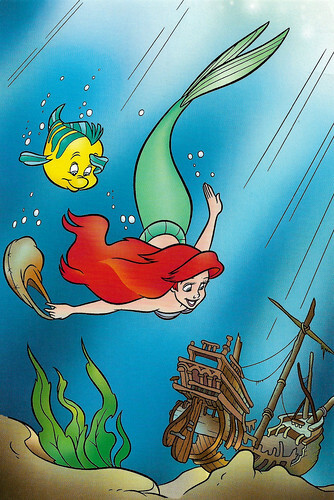
Dutch postcard by Disney Boekenclub, 1998. Image: Disney. Publicity for The Little Mermaid (Ron Clements, John Musker, 1989).
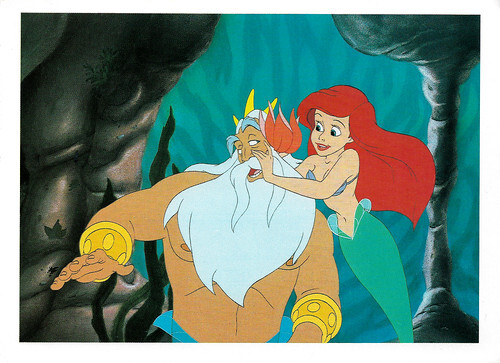
British postcard by Running Press Book Publishers. Image: The Walt Disney Company, 1991. Publicity for The Little Mermaid (Ron Clements, John Musker, 1989). Caption: Triton, the Sea King, gets a flower from his daughter Ariel.
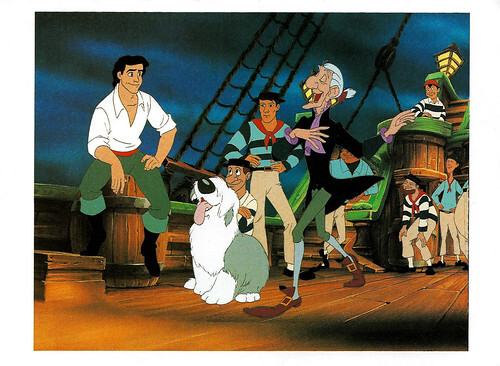
British postcard by Running Press Book Publishers. Image: The Walt Disney Company, 1991. Publicity for The Little Mermaid (Ron Clements, John Musker, 1989). Caption: Prince Eric, Max the dog, and Sir Grimsby, Eric's guardian, celebrate Eric's birthday with the sailors.
An obsession with the human world
The Little Mermaid of the title is the beautiful, rebellious 16-year-old Ariel, one of the daughters of King Triton, whose hidden kingdom lies deep below sea level.
Ariel has an obsession with the human world and all the stuff of humans, something her father absolutely cannot appreciate because he hates humans heartily. He therefore assigns his court musician, the crab Sebastian, to look after her.
One evening, Ariel and the fish Botje see the young and still unmarried Prince Erik aboard a ship. Everyone around Erik is unhappy that he is still not thinking of getting married and starting a family. Ariel instantly falls in love with him.
When the ship runs into a storm and sinks, she rescues Erik from the waves and brings him safely to land. She sings to him the moment he recovers. Although Erik opens his eyes just too late to see her properly, he does hear her.
Afterwards, Erik naturally wants to know who saved him, but he now only knows her heavenly voice. Determined to be with her new love, Ariel makes a dangerous deal with the sea witch Ursula to become human for three days.
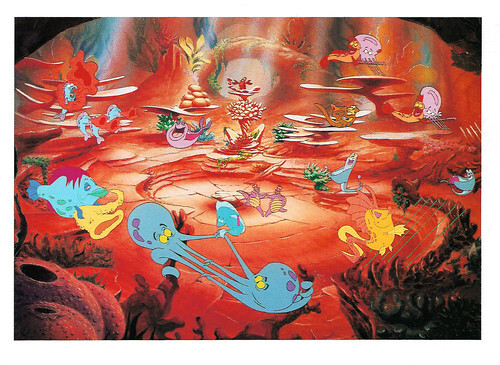
British postcard by Running Press Book Publishers. Image: The Walt Disney Company, 1991. Publicity for The Little Mermaid (Ron Clements, John Musker, 1989). Caption: The song, 'Under the Sea', from The Little Mermaid.
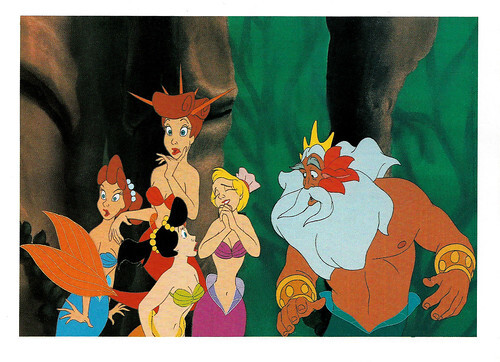
British postcard by Running Press Book Publishers. Image: The Walt Disney Company, 1991. Publicity for The Little Mermaid (Ron Clements, John Musker, 1989). Caption: Ariel's sisters tell their father, the sea king, that Ariel's in love.
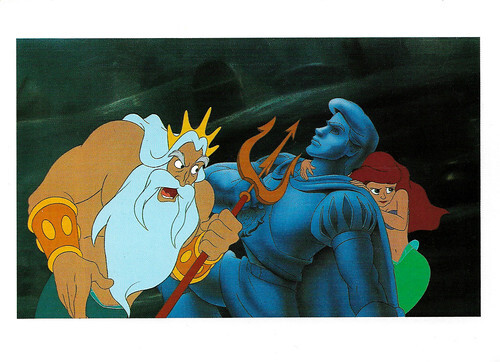
British postcard by Running Press Book Publishers. Image: The Walt Disney Company, 1991. Publicity for The Little Mermaid (Ron Clements, John Musker, 1989). Caption: Triton, the sea king, reprimands Ariel for falling in love with a human.
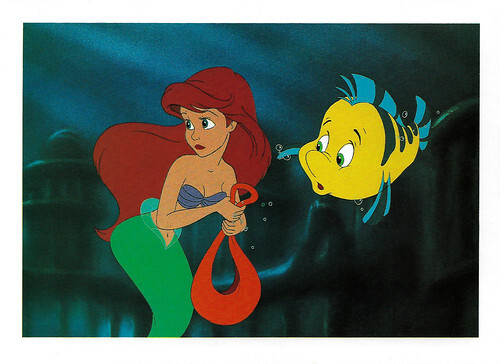
British postcard by Running Press Book Publishers. Image: The Walt Disney Company, 1991. Publicity for The Little Mermaid (Ron Clements, John Musker, 1989). Caption: Ariel and Flounder the fish head for her secret grotto.
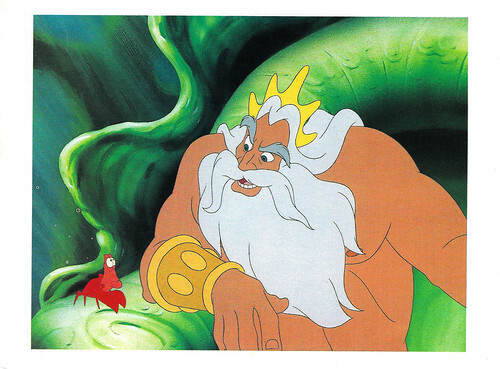
British postcard by Running Press Book Publishers. Image: The Walt Disney Company, 1991. Publicity for The Little Mermaid (Ron Clements, John Musker, 1989). Caption: Triton, the sea king, and Sebastian the crab discuss Ariel's love life.
Disney's last animated film to be hand-coloured in 1,000 colours
The Little Mermaid (Ron Clements, John Musker, 1989) was the first Disney animated film in 30 years to be based on a pre-existing fairy tale. The last of this kind was Sleeping Beauty (Clyde Geronimi, Les Clark, Eric Larson, 1959).
Disney had already had plans to develop The Little Mermaid in the late 1930s. These plans had existed since the release of Snow White and the Seven Dwarfs (David Hand, William Cottrell, Wilfred Jackson, 1937) but were always postponed due to various circumstances.
The Little Mermaid was Disney's last animated film to be hand-coloured in 1,000 colours. Sherri Stoner was used as a model for Ariel. Animators also based their work on a picture of Alyssa Milano. More than 400 technicians and illustrators worked on the film for 3 years. The film involved more than 1,100 backgrounds and consisted of more than 80 per cent special effects. It took almost a year to make the two-minute storm scene.
The film's script differs significantly from Hans Christian Andersen's original story in several ways, especially the ending. In the fairy tale, for instance, the mermaid turns into foam from grief after her prince marries another. Alan Menken wrote the music for the film, collaborating with Howard Ashman on many of the sung numbers.
The film was a critical and commercial success, garnering $235 million in total lifetime gross worldwide, becoming the sixth-highest-grossing film of 1989. The success of The Little Mermaid caused the film to have several sequels. For instance, the story was expanded with a TV series and the film received two sequels in the form of direct-to-video films: The Little Mermaid II: Return to the Sea (Jim Kammerud, Brian Smith, 2002) and The Little Mermaid: Ariel's Beginning (Peggy Holmes, 2008). Multiple versions of a musical were made, both on Broadway and elsewhere. As part of the Disney Princess Franchise, the character Ariel is one of the most successful Disney characters ever.
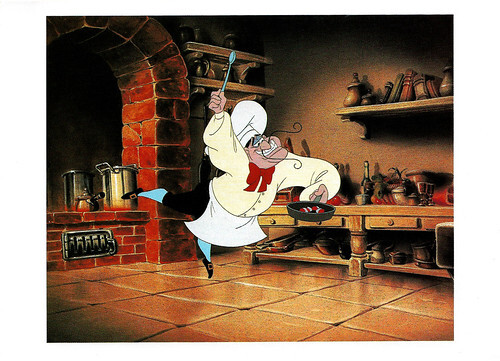
British postcard by Running Press Book Publishers. Image: The Walt Disney Company, 1991. Publicity for The Little Mermaid (Ron Clements, John Musker, 1989). Caption: Sebastian the crab is about to become part of Chef Louie's dinner.
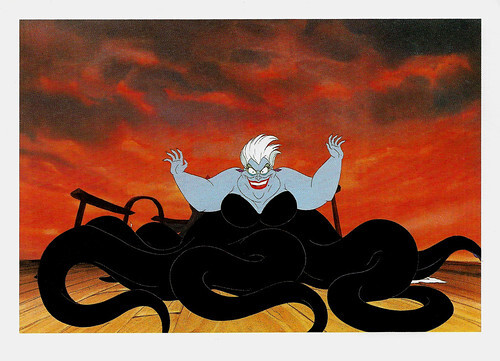
British postcard by Running Press Book Publishers. Image: The Walt Disney Company, 1991. Publicity for The Little Mermaid (Ron Clements, John Musker, 1989). Caption: Vanessa the maiden transforms back into Ursula, the sea witch.
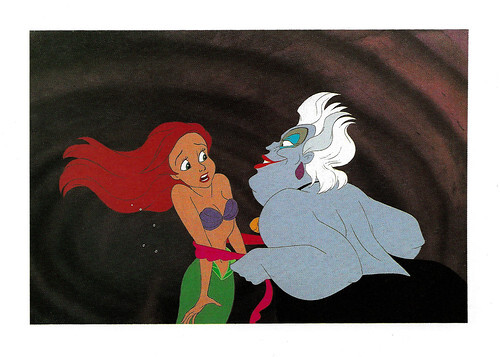
British postcard by Running Press Book Publishers. Image: The Walt Disney Company, 1991. Publicity for The Little Mermaid (Ron Clements, John Musker, 1989). Caption: Ariel is teased menacingly by Ursula, the sea witch, in "Poor Unfortunate Souls".
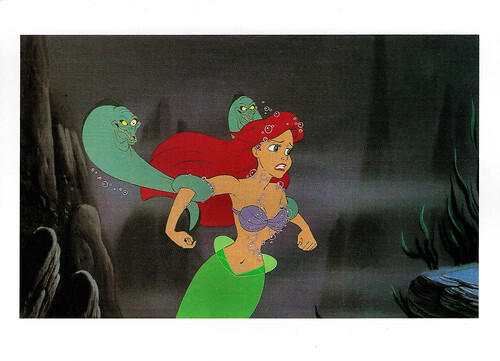
British postcard by Running Press Book Publishers. Image: The Walt Disney Company, 1991. Publicity for The Little Mermaid (Ron Clements, John Musker, 1989). Caption: Ariel struggles as Flotsam and Jetsam, the sea witch's evil pet eels, hold her captive.
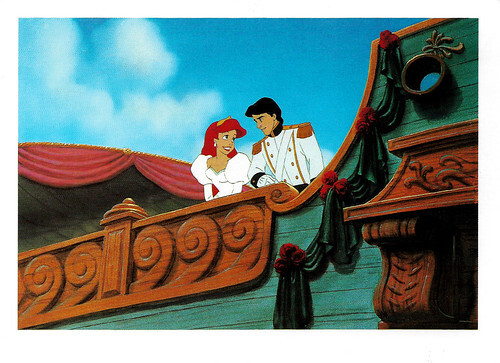
British postcard by Running Press Book Publishers. Image: The Walt Disney Company, 1991. Publicity for The Little Mermaid (Ron Clements, John Musker, 1989). Caption: A beaming Ariel smiles at her husband, Prince Eric.
Sources: Wikipedia (Dutch and English) and IMDb.

Dutch postcard by Disney Boekenclub, 1998. Image: Disney. Publicity for The Little Mermaid (Ron Clements, John Musker, 1989).

British postcard by Running Press Book Publishers. Image: The Walt Disney Company, 1991. Publicity for The Little Mermaid (Ron Clements, John Musker, 1989). Caption: Triton, the Sea King, gets a flower from his daughter Ariel.

British postcard by Running Press Book Publishers. Image: The Walt Disney Company, 1991. Publicity for The Little Mermaid (Ron Clements, John Musker, 1989). Caption: Prince Eric, Max the dog, and Sir Grimsby, Eric's guardian, celebrate Eric's birthday with the sailors.
An obsession with the human world
The Little Mermaid of the title is the beautiful, rebellious 16-year-old Ariel, one of the daughters of King Triton, whose hidden kingdom lies deep below sea level.
Ariel has an obsession with the human world and all the stuff of humans, something her father absolutely cannot appreciate because he hates humans heartily. He therefore assigns his court musician, the crab Sebastian, to look after her.
One evening, Ariel and the fish Botje see the young and still unmarried Prince Erik aboard a ship. Everyone around Erik is unhappy that he is still not thinking of getting married and starting a family. Ariel instantly falls in love with him.
When the ship runs into a storm and sinks, she rescues Erik from the waves and brings him safely to land. She sings to him the moment he recovers. Although Erik opens his eyes just too late to see her properly, he does hear her.
Afterwards, Erik naturally wants to know who saved him, but he now only knows her heavenly voice. Determined to be with her new love, Ariel makes a dangerous deal with the sea witch Ursula to become human for three days.

British postcard by Running Press Book Publishers. Image: The Walt Disney Company, 1991. Publicity for The Little Mermaid (Ron Clements, John Musker, 1989). Caption: The song, 'Under the Sea', from The Little Mermaid.

British postcard by Running Press Book Publishers. Image: The Walt Disney Company, 1991. Publicity for The Little Mermaid (Ron Clements, John Musker, 1989). Caption: Ariel's sisters tell their father, the sea king, that Ariel's in love.

British postcard by Running Press Book Publishers. Image: The Walt Disney Company, 1991. Publicity for The Little Mermaid (Ron Clements, John Musker, 1989). Caption: Triton, the sea king, reprimands Ariel for falling in love with a human.

British postcard by Running Press Book Publishers. Image: The Walt Disney Company, 1991. Publicity for The Little Mermaid (Ron Clements, John Musker, 1989). Caption: Ariel and Flounder the fish head for her secret grotto.

British postcard by Running Press Book Publishers. Image: The Walt Disney Company, 1991. Publicity for The Little Mermaid (Ron Clements, John Musker, 1989). Caption: Triton, the sea king, and Sebastian the crab discuss Ariel's love life.
Disney's last animated film to be hand-coloured in 1,000 colours
The Little Mermaid (Ron Clements, John Musker, 1989) was the first Disney animated film in 30 years to be based on a pre-existing fairy tale. The last of this kind was Sleeping Beauty (Clyde Geronimi, Les Clark, Eric Larson, 1959).
Disney had already had plans to develop The Little Mermaid in the late 1930s. These plans had existed since the release of Snow White and the Seven Dwarfs (David Hand, William Cottrell, Wilfred Jackson, 1937) but were always postponed due to various circumstances.
The Little Mermaid was Disney's last animated film to be hand-coloured in 1,000 colours. Sherri Stoner was used as a model for Ariel. Animators also based their work on a picture of Alyssa Milano. More than 400 technicians and illustrators worked on the film for 3 years. The film involved more than 1,100 backgrounds and consisted of more than 80 per cent special effects. It took almost a year to make the two-minute storm scene.
The film's script differs significantly from Hans Christian Andersen's original story in several ways, especially the ending. In the fairy tale, for instance, the mermaid turns into foam from grief after her prince marries another. Alan Menken wrote the music for the film, collaborating with Howard Ashman on many of the sung numbers.
The film was a critical and commercial success, garnering $235 million in total lifetime gross worldwide, becoming the sixth-highest-grossing film of 1989. The success of The Little Mermaid caused the film to have several sequels. For instance, the story was expanded with a TV series and the film received two sequels in the form of direct-to-video films: The Little Mermaid II: Return to the Sea (Jim Kammerud, Brian Smith, 2002) and The Little Mermaid: Ariel's Beginning (Peggy Holmes, 2008). Multiple versions of a musical were made, both on Broadway and elsewhere. As part of the Disney Princess Franchise, the character Ariel is one of the most successful Disney characters ever.

British postcard by Running Press Book Publishers. Image: The Walt Disney Company, 1991. Publicity for The Little Mermaid (Ron Clements, John Musker, 1989). Caption: Sebastian the crab is about to become part of Chef Louie's dinner.

British postcard by Running Press Book Publishers. Image: The Walt Disney Company, 1991. Publicity for The Little Mermaid (Ron Clements, John Musker, 1989). Caption: Vanessa the maiden transforms back into Ursula, the sea witch.

British postcard by Running Press Book Publishers. Image: The Walt Disney Company, 1991. Publicity for The Little Mermaid (Ron Clements, John Musker, 1989). Caption: Ariel is teased menacingly by Ursula, the sea witch, in "Poor Unfortunate Souls".

British postcard by Running Press Book Publishers. Image: The Walt Disney Company, 1991. Publicity for The Little Mermaid (Ron Clements, John Musker, 1989). Caption: Ariel struggles as Flotsam and Jetsam, the sea witch's evil pet eels, hold her captive.

British postcard by Running Press Book Publishers. Image: The Walt Disney Company, 1991. Publicity for The Little Mermaid (Ron Clements, John Musker, 1989). Caption: A beaming Ariel smiles at her husband, Prince Eric.
Sources: Wikipedia (Dutch and English) and IMDb.
Published on December 20, 2023 22:00
December 19, 2023
Linda van Dyck (1948-2023)
Dutch stage and film actress Linda van Dyck (1948-2023) passed away on 17 December 2023. She appeared in a dozen Dutch and Belgian films, which were sometimes very successful in the low countries. Van Dyck started as a pop singer and songwriter in the 1960s. The actress also worked for television, in the Netherlands and Sweden, where she lived for some years in the late 1960s and early 1970s. Linda van Dyck was 75.
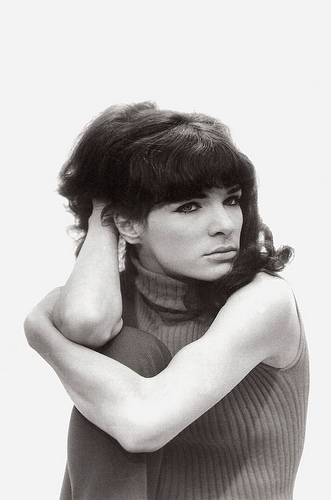
Dutch postcard. Photo: Funckler Grammofoonplaten.
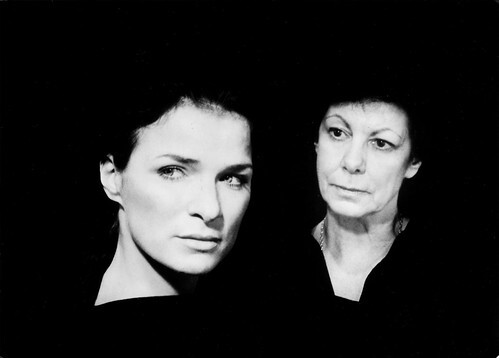
Dutch press photo. Linda van Dyck and Ann Hasekamp in the stage play 'Nacht, moeder' (1984, Night, Mother).
Boo and the Booboo's
Linda van Dyck (sometimes written as Dijck) was born Linda Marianne de Hartogh in Amsterdam, The Netherlands, in 1948. She was the daughter of the actors Leo de Hartogh and Teddy Schaank.
Her stepfather was the legendary Dutch stage actor Ko van Dijk, with whom she made her stage debut in 1959 in 'De Vader' (The Father) by August Strindberg.
In 1966 she appeared in two Dutch feature films: the murder mystery 10:32/10:32 in the Morning (Arthur Dreifuss, 1966) starring Linda Christian , and Het Gangstermeisje/A Gangstergirl (Frans Weisz, 1966) with Paolo Graziosi, Kitty Courbois and Gian Maria Volonté.
In the 1960s, she was best known as the singer of the band Boo and the Booboo's, for which she also wrote song texts. Her last single as a (solo) singer and also her biggest hit was 'Seduction Song' (1969).
She decided to become an actress and moved to Sweden where she worked for television for five years. She lived between 1969 and 1974 in Sweden as the partner of then-unknown director Lasse Hallström. Together, they worked on Ardy Strüwer's TV shows, which were internationally known.
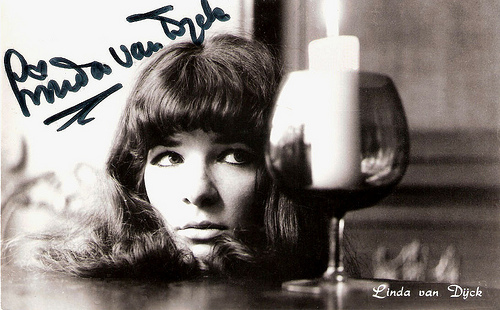
Dutch postcard. Promocard by International Artists, Hilversum.
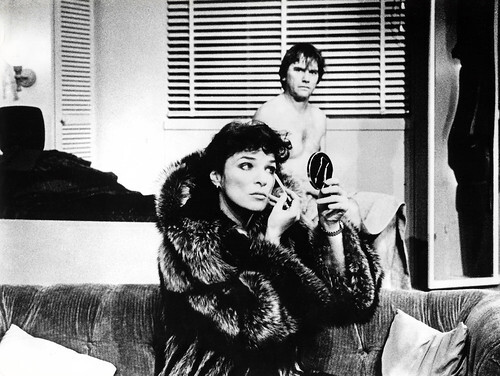
Dutch press photo by Jacques Senf b.v., Maasland. Photo: Jorge Fatauros. Willem Nijholt and Linda van Dijck in the play 'Sukses' (Success) (Jo Dua, 1982) written by Norman Beim.
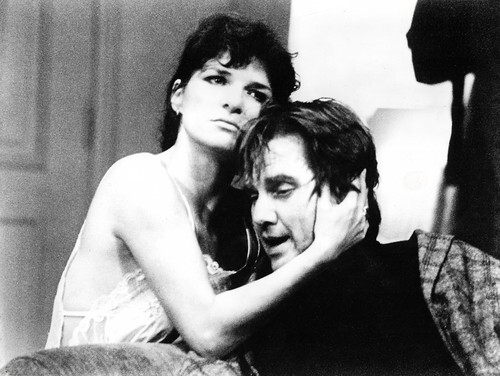
Dutch press photo by Jacques Senf b.v., Maasland. Photo: Jorge Fatauros. Willem Nijholt and Linda van Dijck in the play 'Sukses' (Success) (Jo Dua, 1982) written by Norman Beim.
A sensual aunt
Linda van Dyck returned to the Netherlands in 1973 and appeared in several popular TV series and stage productions.
In 1979 she played a small part in the film Tiro (Jacob Bijl, 1979) with Kitty Courbois. A huge success was her role as the sensual aunt Coleta in the coming-of-age drama Twee vorstinnen en een vorst/Two Queens and a King (Otto Jongerius, 1981) with Eric Clerckx as the young protagonist and Kitty Courbois as his mother.
Another success was her part in the drama Ademloos/Breathless (Mady Saks, 1982) with Monique van de Ven. For these two roles, Linda van Dyck was proclaimed Best Dutch Film Actress in 1982. Another popular local hit was Ciske de Rat/Ciske the Rat (Guido Pieters, 1984) featuring child star Danny de Munk and Willeke van Ammelrooy as his nasty mother. Van Dyck played again the aunt of the protagonist.
In between these films, she appeared on stage and in such prestigious TV dramas as Willem van Oranje/William of Orange (Walter van der Kamp, 1984) starring Jeroen Krabbé .
Other films in which she appeared were the thriller De Grens/The Border (Leon de Winter, 1984) with Johan Leysen and Angela Winkler, and the war film In de schaduw van de overwinning/In the Shadow of the Victory (Ate de Jong, 1986) starring Jeroen Krabbé .
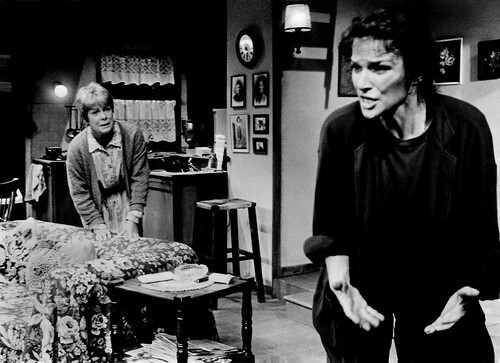
Dutch press photo. Linda van Dyck and Ann Hasekamp in 'Nacht, moeder' (1984, Night, Mother).
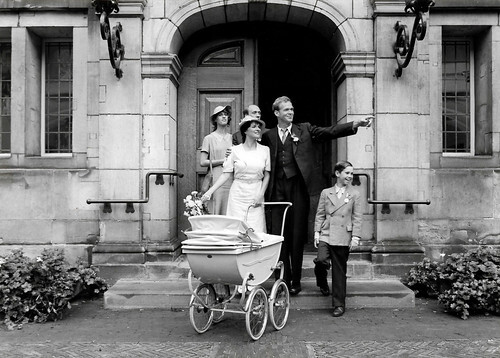
Dutch press photo. Linda van Dyck, Peter Faber and Danny de Munck in Ciske de Rat/Ciske the Rat (Guido Pieters, 1984).
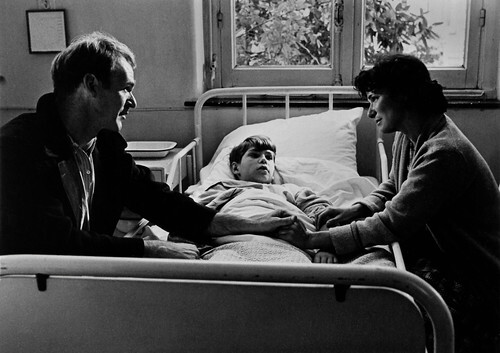
Dutch press photo. Peter Faber, Danny de Munck and Linda van Dyck in Ciske de Rat/Ciske the Rat (Guido Pieters, 1984).
Knight
During the 1990s, Linda van Dyck only incidentally appeared in films. She played a supporting part in the Belgian-French-Dutch production Daens/Priest Daens (Stijn Conincx, 1994), based on the novel by Louis Paul Boon and featuring Jan Decleir.
A surprise was the award-winning TV film Suzy Q (Martin Koolhoven, 1999), about a weekend in the life of a bizarre family in the sixties. Van Dyck played the mother and her children were played by the upcoming stars Carice van Houten , Roeland Fernhout and Michiel Huisman.
Her later films included Magonia (Ineke Smits, 2001) with Ramsey Nasr, the swashbuckler Floris (Jean van de Velde, 2004) featuring Michiel Huisman, and the multicultural comedy Het schnitzelparadijs/Schnitzel Paradise (Martin Koolhoven, 2005).
Her greatest successes were in the Dutch theatre where she starred in such popular and acclaimed productions as 'De dood en het meisje' (2003, Death and the Maiden), 'Herfstsonate' (2005-2006, Autumn Sonata), 'Nacht, Moeder' (2006-2007, Night, Mother) and 'Una Giornata Particolare' (2007-2008).
In 2010 Linda van Dyck received a Royal Order: Ridder in de orde van de Nederlandse Leeuw (Knight in the Order of the Dutch Lion). Her last screen role was in the TV series Zwarte tulp/Black Tulip (2015-2016). She became partially paralysed following a brain infarct in 2021. Linda van Dyck was married to Jaap Nolst Trenité, with whom she had a son, TV presenter Jamie (Maxim Nolst) Trenité (1990).
The Dutch beat band Boo and the Booboo's featuring Linda van Dyck play 'Stengun' (1966). Source: Funnyfreakparade (YouTube).
Trailer of Het schnitzelparadijs/Schnitzel Paradise (2005). Source: KnipFilm (YouTube).
Sources: Hans Beerekamp (Het Schimmenrijk - Dutch), Wikipedia (Dutch), and .

Dutch postcard. Photo: Funckler Grammofoonplaten.

Dutch press photo. Linda van Dyck and Ann Hasekamp in the stage play 'Nacht, moeder' (1984, Night, Mother).
Boo and the Booboo's
Linda van Dyck (sometimes written as Dijck) was born Linda Marianne de Hartogh in Amsterdam, The Netherlands, in 1948. She was the daughter of the actors Leo de Hartogh and Teddy Schaank.
Her stepfather was the legendary Dutch stage actor Ko van Dijk, with whom she made her stage debut in 1959 in 'De Vader' (The Father) by August Strindberg.
In 1966 she appeared in two Dutch feature films: the murder mystery 10:32/10:32 in the Morning (Arthur Dreifuss, 1966) starring Linda Christian , and Het Gangstermeisje/A Gangstergirl (Frans Weisz, 1966) with Paolo Graziosi, Kitty Courbois and Gian Maria Volonté.
In the 1960s, she was best known as the singer of the band Boo and the Booboo's, for which she also wrote song texts. Her last single as a (solo) singer and also her biggest hit was 'Seduction Song' (1969).
She decided to become an actress and moved to Sweden where she worked for television for five years. She lived between 1969 and 1974 in Sweden as the partner of then-unknown director Lasse Hallström. Together, they worked on Ardy Strüwer's TV shows, which were internationally known.

Dutch postcard. Promocard by International Artists, Hilversum.

Dutch press photo by Jacques Senf b.v., Maasland. Photo: Jorge Fatauros. Willem Nijholt and Linda van Dijck in the play 'Sukses' (Success) (Jo Dua, 1982) written by Norman Beim.

Dutch press photo by Jacques Senf b.v., Maasland. Photo: Jorge Fatauros. Willem Nijholt and Linda van Dijck in the play 'Sukses' (Success) (Jo Dua, 1982) written by Norman Beim.
A sensual aunt
Linda van Dyck returned to the Netherlands in 1973 and appeared in several popular TV series and stage productions.
In 1979 she played a small part in the film Tiro (Jacob Bijl, 1979) with Kitty Courbois. A huge success was her role as the sensual aunt Coleta in the coming-of-age drama Twee vorstinnen en een vorst/Two Queens and a King (Otto Jongerius, 1981) with Eric Clerckx as the young protagonist and Kitty Courbois as his mother.
Another success was her part in the drama Ademloos/Breathless (Mady Saks, 1982) with Monique van de Ven. For these two roles, Linda van Dyck was proclaimed Best Dutch Film Actress in 1982. Another popular local hit was Ciske de Rat/Ciske the Rat (Guido Pieters, 1984) featuring child star Danny de Munk and Willeke van Ammelrooy as his nasty mother. Van Dyck played again the aunt of the protagonist.
In between these films, she appeared on stage and in such prestigious TV dramas as Willem van Oranje/William of Orange (Walter van der Kamp, 1984) starring Jeroen Krabbé .
Other films in which she appeared were the thriller De Grens/The Border (Leon de Winter, 1984) with Johan Leysen and Angela Winkler, and the war film In de schaduw van de overwinning/In the Shadow of the Victory (Ate de Jong, 1986) starring Jeroen Krabbé .

Dutch press photo. Linda van Dyck and Ann Hasekamp in 'Nacht, moeder' (1984, Night, Mother).

Dutch press photo. Linda van Dyck, Peter Faber and Danny de Munck in Ciske de Rat/Ciske the Rat (Guido Pieters, 1984).

Dutch press photo. Peter Faber, Danny de Munck and Linda van Dyck in Ciske de Rat/Ciske the Rat (Guido Pieters, 1984).
Knight
During the 1990s, Linda van Dyck only incidentally appeared in films. She played a supporting part in the Belgian-French-Dutch production Daens/Priest Daens (Stijn Conincx, 1994), based on the novel by Louis Paul Boon and featuring Jan Decleir.
A surprise was the award-winning TV film Suzy Q (Martin Koolhoven, 1999), about a weekend in the life of a bizarre family in the sixties. Van Dyck played the mother and her children were played by the upcoming stars Carice van Houten , Roeland Fernhout and Michiel Huisman.
Her later films included Magonia (Ineke Smits, 2001) with Ramsey Nasr, the swashbuckler Floris (Jean van de Velde, 2004) featuring Michiel Huisman, and the multicultural comedy Het schnitzelparadijs/Schnitzel Paradise (Martin Koolhoven, 2005).
Her greatest successes were in the Dutch theatre where she starred in such popular and acclaimed productions as 'De dood en het meisje' (2003, Death and the Maiden), 'Herfstsonate' (2005-2006, Autumn Sonata), 'Nacht, Moeder' (2006-2007, Night, Mother) and 'Una Giornata Particolare' (2007-2008).
In 2010 Linda van Dyck received a Royal Order: Ridder in de orde van de Nederlandse Leeuw (Knight in the Order of the Dutch Lion). Her last screen role was in the TV series Zwarte tulp/Black Tulip (2015-2016). She became partially paralysed following a brain infarct in 2021. Linda van Dyck was married to Jaap Nolst Trenité, with whom she had a son, TV presenter Jamie (Maxim Nolst) Trenité (1990).
The Dutch beat band Boo and the Booboo's featuring Linda van Dyck play 'Stengun' (1966). Source: Funnyfreakparade (YouTube).
Trailer of Het schnitzelparadijs/Schnitzel Paradise (2005). Source: KnipFilm (YouTube).
Sources: Hans Beerekamp (Het Schimmenrijk - Dutch), Wikipedia (Dutch), and .
Published on December 19, 2023 22:00
December 18, 2023
Guy Marchand (1937-2023)
On 15 December 2023, French actor, singer and musician Guy Marchand (1937-2023) died at the age of 86. He appeared in supporting roles in many comedies, but occasionally also acted in dramas and crime films. Marchand won a Cesar Award for his role as a police inspector in Claude Miller's Garde à vue (1981).
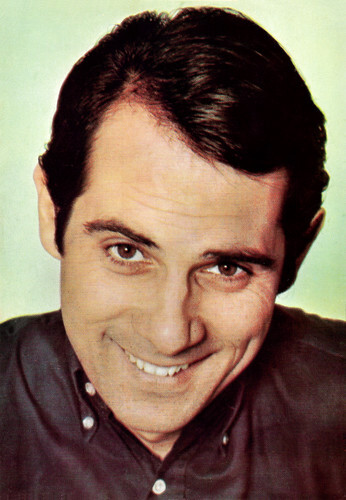
French promotion card by Editions Musicales 707, Paris, no. 7. Photo: Disques Riviera. At the backside is the text of 'Broadway', words and music by Guy Marchand.
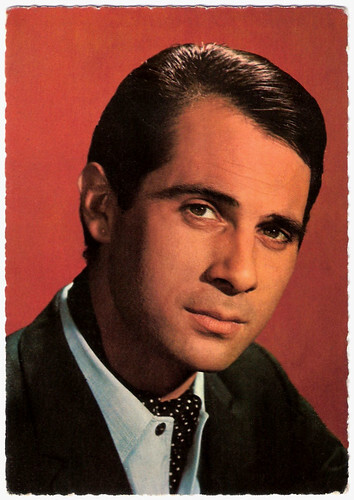
French postcard by PSG, no. 1284. Photo: Riviera. Sent by mail in 1966.
A beautiful crooner voice
Guy Émile Marchand was born in 1937 in Paris into a modest milieu. He was the son of a scrap metal dealer. He attended secondary school at the Lycée Voltaire during the daytime while playing his clarinet at night in the jazz clubs of Saint-Germain-des-Prés. Additionally, he wrote songs, was adept at playing piano and had an affinity with tango.
During his military service, he trained as a reserve officer. He became a sub-lieutenant and a certified paratrooper. During the Algerian conflict, he was stationed with the 3rd Foreign Infantry Regiment. His experience as a paratrooper qualified him as a technical advisor on the all-star World War II epic The Longest Day (Ken Annakin, Andrew Marton, Gerd Oswald, Bernhard Wicki, 1962). He also had a bit part in the film which ended up on the cutting room floor.
Endowed with a beautiful crooner voice, he scored a summer hit in 1965 with his debut record, the song 'La Passionata'. Marchand was already 31 years old when he made his film debut in 1971 alongside Lino Ventura and Brigitte Bardot in the picaresque adventure film Boulevard du rhum (Robert Enrico, 1971). He played Bardot's silent film acting partner and lover.
His next film was the tragicomedy Une belle fille comme moi/Such a Gorgeous Kid Like Me (François Truffaut, 1972), starring Bernadette Lafont . The role of a musician in the film was tailor-made for him. Three years later, Marchand had his breakthrough as a hot-tempered and unfaithful husband in the bittersweet romantic comedy Cousin, cousine (Jean-Charles Tacchella, 1975). This film received three nominations for the Césars and Marie-France Pisier won the César for Best Supporting Actress. The film also struck a chord in the United States and was nominated for three Oscars.
After the acclaim of Cousin, cousine, Marchand could record three more successes in 1978. In the comedies Tendre poulet (Philippe de Broca, 1978) and Vas-y maman (Nicole de Buron, 1978), he was cast alongside Annie Girardot . The featherweight L'Hôtel de la plage/Holiday Hotel (Michel Lang, 1978) achieved the biggest commercial success. It was followed a year later by the comedy Le Maître-nageur (Jean-Louis Trintignant, 1979) in which Marchand starred as a crooner.
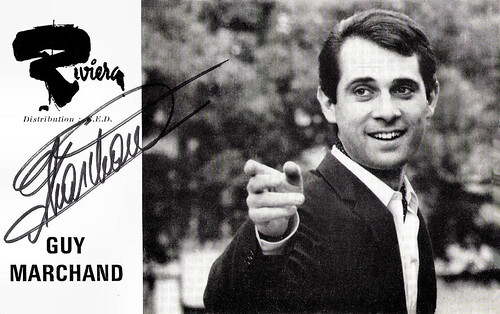
French promotion card by G. et R. Joly, Paris. Photo: A. Nisak / Riviera.
Deputy or ex-husband
In 1981, Guy Marchand appeared in two commercially and critically successful crime films. In the tragicomic Coup de torchon (Bertrand Tavernier, 1981), Marchand played a racist police chief. The other crime film was the multiple César-winning Garde à vue (Claude Miller, 1981). Marchand shared in the awards with a César for best male supporting actor for his performance as Lino Ventura 's deputy inspector.
That same year, Marchand collaborated for the second time with Gérard Pirès in the comedy Rends-moi la clé (Gérard Pirès, 1981) in which he embodied the ex-husband (of Jane Birkin ), a role he often played. A year later, Marchand was again a deputy, this time to private detective Michel Serrault in the crime comedy Nestor Burma, détective de choc (Jean-Luc Miesch, 1982). Burma is a hard-boiled private detective, a kind of French Philip Marlowe. Marchand played this popular character in a TV series a decade later.
1982 was also the year of the blockbuster comedy Les Sous-doués en vacances (Claude Zidi, 1982), in which he embodied famous singer Paul Memphis and sang his hit 'Destinée', which he co-wrote.
Noteworthy crime comedies include the successful Hold-up (Alexandre Arcady, 1985) in which he was the accomplice of mugger Jean-Paul Belmondo , Conseil de famille/Family Business (Costa-Gravas, 1986) in which he was a safecracker and the commercial smash Ripoux contre ripoux/My New Partner II (Claude Zidi, 1990) in which he was a corrupt police inspector.
Noteworthy dramas from those years were Loulou (Maurice Piala, 1980) and Coup de foudre (Diane Kurys, 1983) in which Marchand repeatedly threatens to lose his wife, played by Isabelle Huppert . In Loulou he loses her to Gérard Depardieu , and in Coup de foudre to Miou-Miou . Coup de foudre scored well at the box office and picked up four nominations for the Césars as well as a nomination for the Oscar for Best International Film.
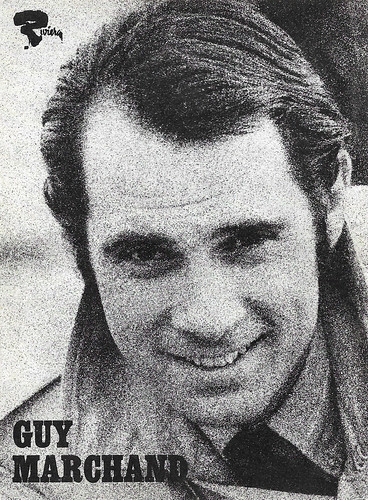
French promotion card. Photo: Marshall / Riviera.
His comeback on the big screen
During the 1990s, Guy Marchand was rarely seen in the cinema as he again became more involved in music and television work. Between 1991 and 2006, he appeared in only six films, mostly in modest supporting roles.
His most watched film from that time was Le Plus Beau Métier du monde/The Best Job in the World (Gérard Lauzier, 1995), the third and last comedy he made under the direction of Gérard Lauzier.
With Dans Paris/Inside Paris (Christophe Honoré, 2006), Marchand made his comeback on the big screen. In this tragicomedy, he tries as a father together with his second son (Louis Garrel) and his ex ( Marie-France Pisier , his co-star in Cousin, cousine) to talk their eldest son (Romain Duris) out of his suicidal thoughts.
This was followed by the drama Après lui (Gaël Morel, 2007) in which he, like his ex Catherine Deneuve , has to cope with the loss of their son. After these two films, his film career disappeared back into the background due to the books he was publishing at the time.
In 2007, he published his autobiography, 'Le Guignol des Buttes-Chaumont'. In 2011 Le Soleil des enfants perdus' (The Sun of Lost Children) followed, which touched on his experiences in Algeria, and for which he received the Jean-Nohain prize in 2012.
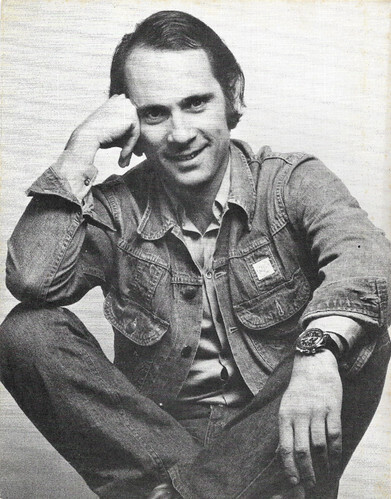
French promotion card. Photo: Alain Marouani / Riviera.
A familiar figure to television audiences
In 2010, Guy Marchand's film career became more prolific again. He starred in the gripping historical drama L'Arbre et la Forêt/Family Tree (Olivier Ducastel, Jacques Martineau, 2010). He played an old married tree farmer who carries a secret with him. The latter was imprisoned in a Nazi camp 50 years ago, not because of his political beliefs, but because of his homosexual orientation. The film won the Prix Jean Vigo.
From 1973, Marchand was a familiar figure to television audiences, mainly through his portrayal of the title role of the television series Nestor Burma (1991-2003), a private detective whose adventures aired for eight seasons. The series was based on the crime comedy Nestor Burma, détective de choc (1982) in which Marchand already acted as Nestor Burma's deputy.
Over the years (1965-2000), Marchand released many more singles and EPs. Some 20 albums were released between 1969 and 2020, including about five compilation albums.
Marchand was first married to actress Béatrice Chatelier, who played his ex-wife in Les Sous-doués en vacances (1982). They had two children. In 2006, Marchand met Adelina Khamaganova, a woman of Russian descent who was 40 years younger. They married in 2007. She left him a few years later and started a new life in Germany with a new partner.
In 2019 it was revealed that he was ruined, overwhelmed by his all-consuming passion for cars. In 2020, he met the musician/composer Ludovic Beier, with whom he collaborated on the production of his album 'Born in Belleville', which was released in November 2020. His final film was La plus belle pour aller danser (Victoria Bedos, 2023). Guy Marchand died on 15 December 2023 in Cavaillon, in the Provence-Alpes-Côte d'Azur region of Southeastern France. He was 86.
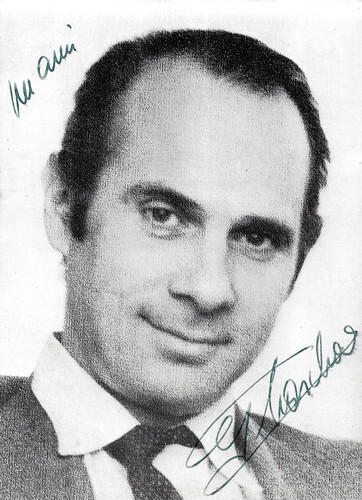
French promotion card by Printfield. Photo: Alain Resplandin / Barclay.
Sources: (IMDb), Wikipedia (Dutch, English and French) and .

French promotion card by Editions Musicales 707, Paris, no. 7. Photo: Disques Riviera. At the backside is the text of 'Broadway', words and music by Guy Marchand.

French postcard by PSG, no. 1284. Photo: Riviera. Sent by mail in 1966.
A beautiful crooner voice
Guy Émile Marchand was born in 1937 in Paris into a modest milieu. He was the son of a scrap metal dealer. He attended secondary school at the Lycée Voltaire during the daytime while playing his clarinet at night in the jazz clubs of Saint-Germain-des-Prés. Additionally, he wrote songs, was adept at playing piano and had an affinity with tango.
During his military service, he trained as a reserve officer. He became a sub-lieutenant and a certified paratrooper. During the Algerian conflict, he was stationed with the 3rd Foreign Infantry Regiment. His experience as a paratrooper qualified him as a technical advisor on the all-star World War II epic The Longest Day (Ken Annakin, Andrew Marton, Gerd Oswald, Bernhard Wicki, 1962). He also had a bit part in the film which ended up on the cutting room floor.
Endowed with a beautiful crooner voice, he scored a summer hit in 1965 with his debut record, the song 'La Passionata'. Marchand was already 31 years old when he made his film debut in 1971 alongside Lino Ventura and Brigitte Bardot in the picaresque adventure film Boulevard du rhum (Robert Enrico, 1971). He played Bardot's silent film acting partner and lover.
His next film was the tragicomedy Une belle fille comme moi/Such a Gorgeous Kid Like Me (François Truffaut, 1972), starring Bernadette Lafont . The role of a musician in the film was tailor-made for him. Three years later, Marchand had his breakthrough as a hot-tempered and unfaithful husband in the bittersweet romantic comedy Cousin, cousine (Jean-Charles Tacchella, 1975). This film received three nominations for the Césars and Marie-France Pisier won the César for Best Supporting Actress. The film also struck a chord in the United States and was nominated for three Oscars.
After the acclaim of Cousin, cousine, Marchand could record three more successes in 1978. In the comedies Tendre poulet (Philippe de Broca, 1978) and Vas-y maman (Nicole de Buron, 1978), he was cast alongside Annie Girardot . The featherweight L'Hôtel de la plage/Holiday Hotel (Michel Lang, 1978) achieved the biggest commercial success. It was followed a year later by the comedy Le Maître-nageur (Jean-Louis Trintignant, 1979) in which Marchand starred as a crooner.

French promotion card by G. et R. Joly, Paris. Photo: A. Nisak / Riviera.
Deputy or ex-husband
In 1981, Guy Marchand appeared in two commercially and critically successful crime films. In the tragicomic Coup de torchon (Bertrand Tavernier, 1981), Marchand played a racist police chief. The other crime film was the multiple César-winning Garde à vue (Claude Miller, 1981). Marchand shared in the awards with a César for best male supporting actor for his performance as Lino Ventura 's deputy inspector.
That same year, Marchand collaborated for the second time with Gérard Pirès in the comedy Rends-moi la clé (Gérard Pirès, 1981) in which he embodied the ex-husband (of Jane Birkin ), a role he often played. A year later, Marchand was again a deputy, this time to private detective Michel Serrault in the crime comedy Nestor Burma, détective de choc (Jean-Luc Miesch, 1982). Burma is a hard-boiled private detective, a kind of French Philip Marlowe. Marchand played this popular character in a TV series a decade later.
1982 was also the year of the blockbuster comedy Les Sous-doués en vacances (Claude Zidi, 1982), in which he embodied famous singer Paul Memphis and sang his hit 'Destinée', which he co-wrote.
Noteworthy crime comedies include the successful Hold-up (Alexandre Arcady, 1985) in which he was the accomplice of mugger Jean-Paul Belmondo , Conseil de famille/Family Business (Costa-Gravas, 1986) in which he was a safecracker and the commercial smash Ripoux contre ripoux/My New Partner II (Claude Zidi, 1990) in which he was a corrupt police inspector.
Noteworthy dramas from those years were Loulou (Maurice Piala, 1980) and Coup de foudre (Diane Kurys, 1983) in which Marchand repeatedly threatens to lose his wife, played by Isabelle Huppert . In Loulou he loses her to Gérard Depardieu , and in Coup de foudre to Miou-Miou . Coup de foudre scored well at the box office and picked up four nominations for the Césars as well as a nomination for the Oscar for Best International Film.

French promotion card. Photo: Marshall / Riviera.
His comeback on the big screen
During the 1990s, Guy Marchand was rarely seen in the cinema as he again became more involved in music and television work. Between 1991 and 2006, he appeared in only six films, mostly in modest supporting roles.
His most watched film from that time was Le Plus Beau Métier du monde/The Best Job in the World (Gérard Lauzier, 1995), the third and last comedy he made under the direction of Gérard Lauzier.
With Dans Paris/Inside Paris (Christophe Honoré, 2006), Marchand made his comeback on the big screen. In this tragicomedy, he tries as a father together with his second son (Louis Garrel) and his ex ( Marie-France Pisier , his co-star in Cousin, cousine) to talk their eldest son (Romain Duris) out of his suicidal thoughts.
This was followed by the drama Après lui (Gaël Morel, 2007) in which he, like his ex Catherine Deneuve , has to cope with the loss of their son. After these two films, his film career disappeared back into the background due to the books he was publishing at the time.
In 2007, he published his autobiography, 'Le Guignol des Buttes-Chaumont'. In 2011 Le Soleil des enfants perdus' (The Sun of Lost Children) followed, which touched on his experiences in Algeria, and for which he received the Jean-Nohain prize in 2012.

French promotion card. Photo: Alain Marouani / Riviera.
A familiar figure to television audiences
In 2010, Guy Marchand's film career became more prolific again. He starred in the gripping historical drama L'Arbre et la Forêt/Family Tree (Olivier Ducastel, Jacques Martineau, 2010). He played an old married tree farmer who carries a secret with him. The latter was imprisoned in a Nazi camp 50 years ago, not because of his political beliefs, but because of his homosexual orientation. The film won the Prix Jean Vigo.
From 1973, Marchand was a familiar figure to television audiences, mainly through his portrayal of the title role of the television series Nestor Burma (1991-2003), a private detective whose adventures aired for eight seasons. The series was based on the crime comedy Nestor Burma, détective de choc (1982) in which Marchand already acted as Nestor Burma's deputy.
Over the years (1965-2000), Marchand released many more singles and EPs. Some 20 albums were released between 1969 and 2020, including about five compilation albums.
Marchand was first married to actress Béatrice Chatelier, who played his ex-wife in Les Sous-doués en vacances (1982). They had two children. In 2006, Marchand met Adelina Khamaganova, a woman of Russian descent who was 40 years younger. They married in 2007. She left him a few years later and started a new life in Germany with a new partner.
In 2019 it was revealed that he was ruined, overwhelmed by his all-consuming passion for cars. In 2020, he met the musician/composer Ludovic Beier, with whom he collaborated on the production of his album 'Born in Belleville', which was released in November 2020. His final film was La plus belle pour aller danser (Victoria Bedos, 2023). Guy Marchand died on 15 December 2023 in Cavaillon, in the Provence-Alpes-Côte d'Azur region of Southeastern France. He was 86.

French promotion card by Printfield. Photo: Alain Resplandin / Barclay.
Sources: (IMDb), Wikipedia (Dutch, English and French) and .
Published on December 18, 2023 22:00
December 17, 2023
Steve Cochran
Husky, darkly handsome Steve Cochran (1917-1965) was an American film, television and stage actor, who often played boxers and gangsters during the 1940s and 1950s. One of his best-known roles is the troubled drifter in Michelangelo Antonioni's Il Grido (1957), produced in Italy.
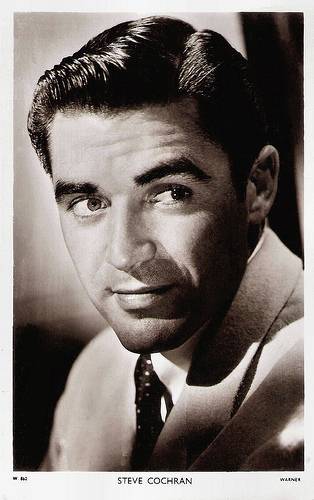
British postcard in the Picturegoer Series, London, no. W 882. Photo: Warner.
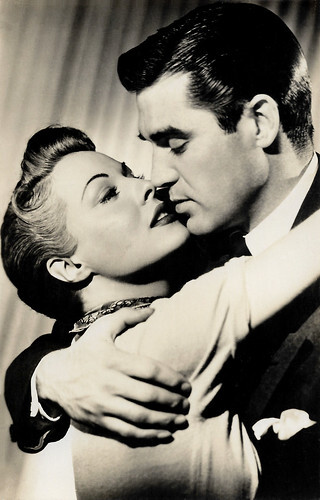
Spanish postcard, no. 2332. Gaby Andreu and Steve Cochran in Highway 301 (Andrew L. Stone, 1950).
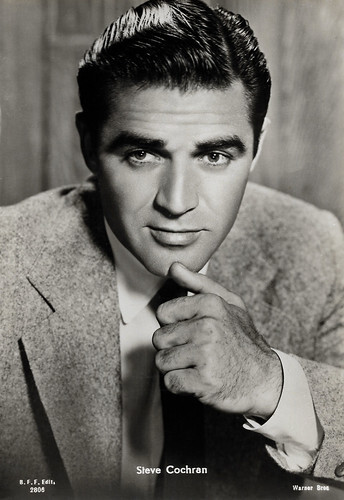
Italian postcard by B.F.F. Edit., no. 2806. Photo: Warner Bros.
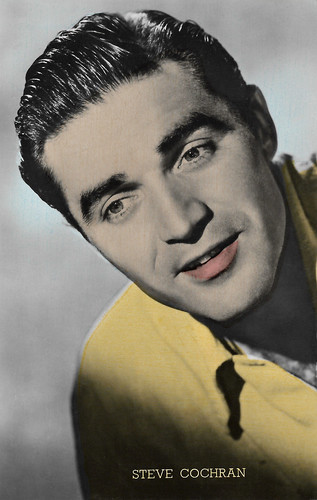
Swedish postcard by Äkta handkolorerade fotokort, no. 20014.
They didn't come much rougher and tougher
Steve Cochran was born Robert Alexander Cochran in Eureka, California, in 1917. He grew up in Laramie, Wyoming, the son of a logger. While he appeared in high school plays, he spent more time delving into athletics, particularly shooting hoops. After stints as a cowpuncher and railroad station hand, he studied at the University of Wyoming, where he also played basketball.
Impulsively, he quit college in 1937 and decided to go straight to Hollywood to become a star. Working as a carpenter and department store detective during his early days, he gained experience appearing in summer stock. In the early 1940s, he was given the chance to work with the Shakespeare Festival in Carmel. There he played Orsino in Twelfth Night, Malcolm in Macbeth, Horatio in Hamlet and the title role of Richard III. He made his Broadway debut in Broken Hearts on Broadway (1944) and then went on to appear almost immediately in Hickory Stick.
In 1945, he landed a contract with Samuel Goldwyn. His debut was Wonder Man (H. Bruce Humberstone, 1945) with Virginia Mayo and Danny Kaye . In the following years, he appeared in several films, including the Film Noir The Chase (Arthur Ripley, 1946), the war classic The Best Years of Our Lives (William Wyler, 1946) as Virginia Mayo 's extra-marital fling, and A Song Is Born (Howard Hawks, 1948).
Following a notable stint as Mae West 's leading stud in her 1949 revival of Diamond Lil on Broadway, Cochran was picked up by Warner Bros. From 1949 to 1952 Cochran often played boxers and gangsters for Warner. One of his most memorable roles was as psychotic mobster James Cagney’s power-hungry henchman, Big Ed Somers, in the gangster classic White Heat (Raoul Walsh, 1949). He also appeared in Highway 301 (Andrew L. Stone, 1950), as Joan Crawford 's gangster paramour in The Damned Don't Cry! (Vincent Sherman, 1950), and Inside the Walls of Folsom Prison (Crane Wilbur, 1951), which inspired Johnny Cash to write his song Folsom Prison Blues.
Gary Brumburgh at IMDb : “Cochran was all man -- and a slick ladies' guy to boot. They didn't come much rougher and tougher than he both off- and on-camera. Throughout post-WWII Hollywood and the 1950s, he played the swarthiest and sexiest of coldhearted villains, with a moustache or without, in a few films now considered classics. What Cochran perhaps lacked in the Gable charisma department, he certainly made up for with his own raw magnetism and sexy virility.“
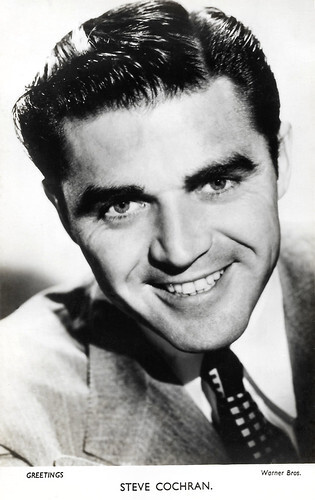
British postcard in the Greetings Series. Photo: Warner Bros.
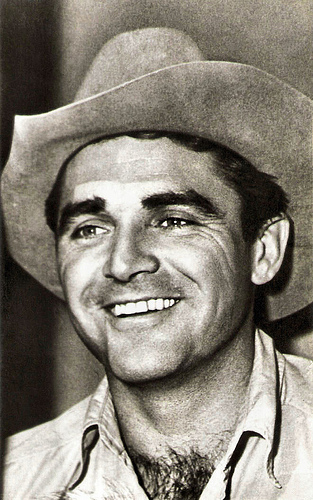
Spanish postcard, no. 725. Photo: publicity still for Highway 301 (Andrew L. Stone, 1950).
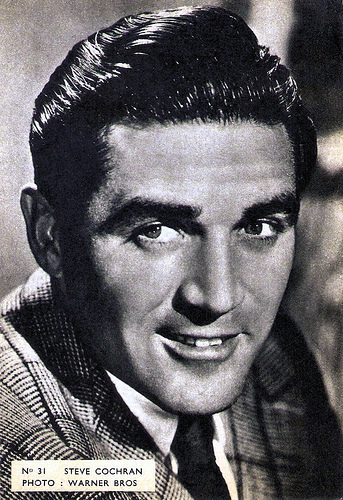
Belgian collectors card by Merbotex / Ciné British Palace, Temse, Serie B, no. 31. Photo: Warner Bros.
A prime candidate for numerous arrests
In 1953 Steve Cochran formed his own production company, Robert Alexander Productions. He won critical acclaim for two of his performances in his company's films. Cochran played a disgraced, alcoholic itinerant farmer struggling to regain the love of his family in Come Next Spring (R.G. Springsteen, 1956), and a troubled drifter in Michelangelo Antonioni's Il Grido/The Outcry (1957), produced in Italy and co-starring Alida Valli .
Cochran starred in a string of B movies throughout the 1950s, including Carnival Story (Kurt Neumann, 1954), Private Hell 36 (Don Siegel, 1954) and the British thriller The Weapon (Val Guest, 1956). He also appeared in episodes of popular television series of the era, such as The Twilight Zone (1959) and The Untouchables (1960-1961).
In the early 1960s, Cochran appeared in the Western The Deadly Companions (Sam Peckinpah, 1961) with Maureen O’Hara , and the drama Of Love and Desire (Richard Rush, 1963) starring Merle Oberon , but his career had begun a final downslide. His production company attempted to make some television series and films, but they were never produced except for a television pilot where he played John C. Fremont in Fremont the Trailblazer.
A prime candidate for numerous arrests for his impulsive carousing and brawling, his living hard in the fast lane began to take its toll. His last years were marred by an obligatory Errol Flynn -type ending of drinking and debauchery. He began looking bloated and weighty. Cochran's final films were the British crime drama Mozambique (Robert Lynn, 1964) with Hildegard Knef , and the romantic drama Tell Me in the Sunlight (1965), which he had directed himself and was not released in the U.S. until 1967.
Steve Cochran was a notorious womanizer and attracted tabloid attention for his tumultuous private life, which included well-documented affairs with numerous starlets and actresses. Mamie Van Doren later wrote about their sex life in her autobiography Playing the Field: My Story (1987). He was married and divorced three times to artist Florence Lockwood, actress Fay McKenzie, and 19-year-old Danish emigre Hedda Jenna Jensen. He had one daughter, Xandra, by Lockwood. Cochran was the grandfather of film and television producer Alex Johns.
In 1965, Cochran died on his yacht off the coast of Guatemala, reportedly due to an acute lung infection. His body, along with three female assistants, remained aboard for ten days since the three women did not know how to operate the boat. It drifted to shore in Port Champerico, Guatemala, and was found by authorities. According to Wikipedia , there were various rumours of foul play and poisoning, but reportedly no new evidence was found. Steve Cochran was 48.
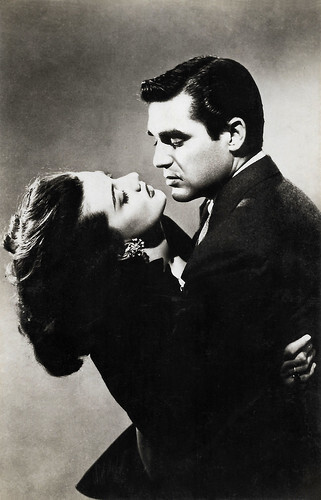
Spanish postcard. Steve Cochran and Virginia Grey in Highway 301 (Andrew L. Stone, 1950).
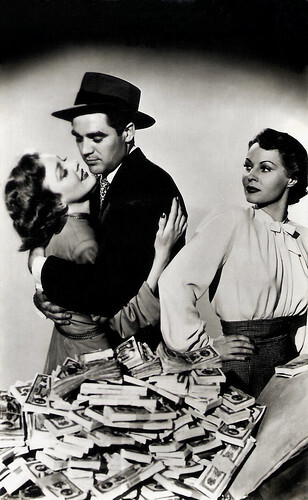
Spanish postcard, no. 858. Gaby Andreu, Steve Cochran and Virginia Grey in Highway 301 (Andrew L. Stone, 1950).
Trailer Il Grido/The Outcry (1957). Source: Danios12345 (YouTube).
Sources: (IMDb), Wikipedia, and .

British postcard in the Picturegoer Series, London, no. W 882. Photo: Warner.

Spanish postcard, no. 2332. Gaby Andreu and Steve Cochran in Highway 301 (Andrew L. Stone, 1950).

Italian postcard by B.F.F. Edit., no. 2806. Photo: Warner Bros.

Swedish postcard by Äkta handkolorerade fotokort, no. 20014.
They didn't come much rougher and tougher
Steve Cochran was born Robert Alexander Cochran in Eureka, California, in 1917. He grew up in Laramie, Wyoming, the son of a logger. While he appeared in high school plays, he spent more time delving into athletics, particularly shooting hoops. After stints as a cowpuncher and railroad station hand, he studied at the University of Wyoming, where he also played basketball.
Impulsively, he quit college in 1937 and decided to go straight to Hollywood to become a star. Working as a carpenter and department store detective during his early days, he gained experience appearing in summer stock. In the early 1940s, he was given the chance to work with the Shakespeare Festival in Carmel. There he played Orsino in Twelfth Night, Malcolm in Macbeth, Horatio in Hamlet and the title role of Richard III. He made his Broadway debut in Broken Hearts on Broadway (1944) and then went on to appear almost immediately in Hickory Stick.
In 1945, he landed a contract with Samuel Goldwyn. His debut was Wonder Man (H. Bruce Humberstone, 1945) with Virginia Mayo and Danny Kaye . In the following years, he appeared in several films, including the Film Noir The Chase (Arthur Ripley, 1946), the war classic The Best Years of Our Lives (William Wyler, 1946) as Virginia Mayo 's extra-marital fling, and A Song Is Born (Howard Hawks, 1948).
Following a notable stint as Mae West 's leading stud in her 1949 revival of Diamond Lil on Broadway, Cochran was picked up by Warner Bros. From 1949 to 1952 Cochran often played boxers and gangsters for Warner. One of his most memorable roles was as psychotic mobster James Cagney’s power-hungry henchman, Big Ed Somers, in the gangster classic White Heat (Raoul Walsh, 1949). He also appeared in Highway 301 (Andrew L. Stone, 1950), as Joan Crawford 's gangster paramour in The Damned Don't Cry! (Vincent Sherman, 1950), and Inside the Walls of Folsom Prison (Crane Wilbur, 1951), which inspired Johnny Cash to write his song Folsom Prison Blues.
Gary Brumburgh at IMDb : “Cochran was all man -- and a slick ladies' guy to boot. They didn't come much rougher and tougher than he both off- and on-camera. Throughout post-WWII Hollywood and the 1950s, he played the swarthiest and sexiest of coldhearted villains, with a moustache or without, in a few films now considered classics. What Cochran perhaps lacked in the Gable charisma department, he certainly made up for with his own raw magnetism and sexy virility.“

British postcard in the Greetings Series. Photo: Warner Bros.

Spanish postcard, no. 725. Photo: publicity still for Highway 301 (Andrew L. Stone, 1950).

Belgian collectors card by Merbotex / Ciné British Palace, Temse, Serie B, no. 31. Photo: Warner Bros.
A prime candidate for numerous arrests
In 1953 Steve Cochran formed his own production company, Robert Alexander Productions. He won critical acclaim for two of his performances in his company's films. Cochran played a disgraced, alcoholic itinerant farmer struggling to regain the love of his family in Come Next Spring (R.G. Springsteen, 1956), and a troubled drifter in Michelangelo Antonioni's Il Grido/The Outcry (1957), produced in Italy and co-starring Alida Valli .
Cochran starred in a string of B movies throughout the 1950s, including Carnival Story (Kurt Neumann, 1954), Private Hell 36 (Don Siegel, 1954) and the British thriller The Weapon (Val Guest, 1956). He also appeared in episodes of popular television series of the era, such as The Twilight Zone (1959) and The Untouchables (1960-1961).
In the early 1960s, Cochran appeared in the Western The Deadly Companions (Sam Peckinpah, 1961) with Maureen O’Hara , and the drama Of Love and Desire (Richard Rush, 1963) starring Merle Oberon , but his career had begun a final downslide. His production company attempted to make some television series and films, but they were never produced except for a television pilot where he played John C. Fremont in Fremont the Trailblazer.
A prime candidate for numerous arrests for his impulsive carousing and brawling, his living hard in the fast lane began to take its toll. His last years were marred by an obligatory Errol Flynn -type ending of drinking and debauchery. He began looking bloated and weighty. Cochran's final films were the British crime drama Mozambique (Robert Lynn, 1964) with Hildegard Knef , and the romantic drama Tell Me in the Sunlight (1965), which he had directed himself and was not released in the U.S. until 1967.
Steve Cochran was a notorious womanizer and attracted tabloid attention for his tumultuous private life, which included well-documented affairs with numerous starlets and actresses. Mamie Van Doren later wrote about their sex life in her autobiography Playing the Field: My Story (1987). He was married and divorced three times to artist Florence Lockwood, actress Fay McKenzie, and 19-year-old Danish emigre Hedda Jenna Jensen. He had one daughter, Xandra, by Lockwood. Cochran was the grandfather of film and television producer Alex Johns.
In 1965, Cochran died on his yacht off the coast of Guatemala, reportedly due to an acute lung infection. His body, along with three female assistants, remained aboard for ten days since the three women did not know how to operate the boat. It drifted to shore in Port Champerico, Guatemala, and was found by authorities. According to Wikipedia , there were various rumours of foul play and poisoning, but reportedly no new evidence was found. Steve Cochran was 48.

Spanish postcard. Steve Cochran and Virginia Grey in Highway 301 (Andrew L. Stone, 1950).

Spanish postcard, no. 858. Gaby Andreu, Steve Cochran and Virginia Grey in Highway 301 (Andrew L. Stone, 1950).
Trailer Il Grido/The Outcry (1957). Source: Danios12345 (YouTube).
Sources: (IMDb), Wikipedia, and .
Published on December 17, 2023 22:00
December 16, 2023
Alexis Smith
Statuesque, smart Canadian-born Alexis Smith (1921-1993), with her blue/green eyes and a seductively husky voice, lent a touch of class to her leading ladies of the 1940s and 1950s. She was paired with the top male stars in Hollywood, including Clark Gable, Humphrey Bogart, William Holden and Bing Crosby. She was stylishly attired by costume designers like Milo Anderson and Helen Rose in the most glamorous gowns but also proved to be a capable and spirited actress. She reserved her best acting for the stage and in 1972, she won a Tony award for her starring role in Stephen Sondheim's musical 'Follies'.
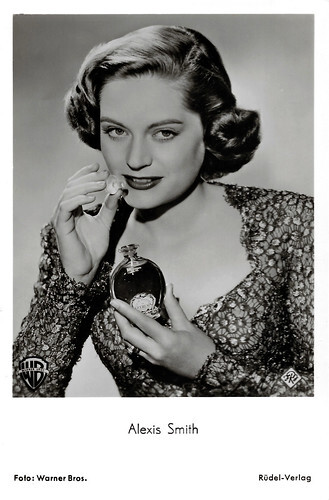
West German postcard by Rüdel-Verlag, Hamburg-Bergedorf, no. 810. Photo: Warner Bros.
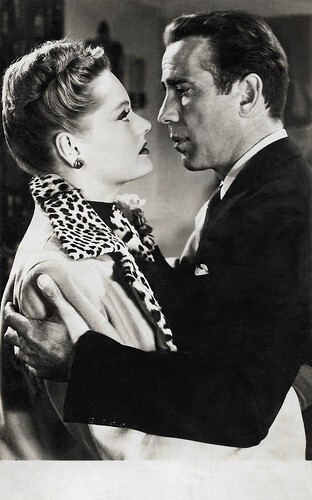
Spanish postcard, no. 1260. Photo: Warner Bros. Alexis Smith and Humphrey Bogart in The Two Mrs. Carrolls (Peter Godfrey, 1947).
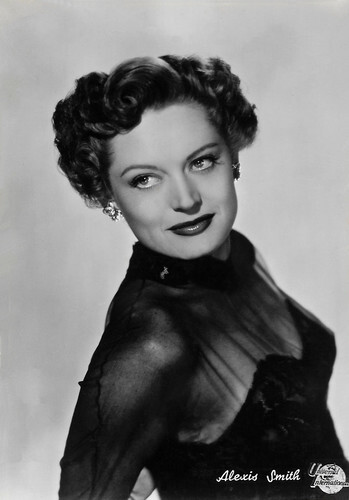
Italian postcard by Bromofoto, Milano, no. 296. Photo: Universal International. Alexis Smith in Undercover Girl (Joseph Pevney, 1950).
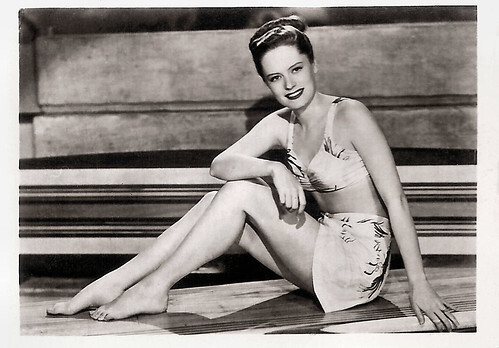
Small German collectors card in the series E - Filmstars der Welt 2. Band by Greilings-sammelbilder, no. 164. Photo: Hamann-Meyerpress.
The mould of the other woman
Alexis Smith was born Gladys Smith in 1921 in Penticton, British Columbia, Canada. After her family moved to California, she grew into a precocious talent, performing ballet in public by the age of thirteen, dancing to 'Carmen' at the Hollywood Bowl. She later graduated with a degree in drama from Los Angeles City College, having previously won an acting contest whilst still in high school.
During a performance of a play on campus, she was spotted by a Warner Brothers talent scout and signed a contract in 1941. Her earliest film roles were uncredited bit parts, and it took several years for her career to gain momentum. Much to her chagrin, the studio's publicity department touted Alexis as the 'Dynamite Girl'. Her first credited role was in the feature film Dive Bomber (Michael Curtiz, 1941), playing the female lead opposite Errol Flynn .
She would make a total of four films with Flynn including the boxing drama Gentleman Jim (Raoul Walsh, 1942) and the Western San Antonio (David Butler, 1945). Though decidedly second fiddle to the action and the charismatic Flynn, Alexis made a good first impression as the fetching romantic interest. She appeared with her future husband, Craig Stevens, in the comedy Steel Against the Sky (A. Edward Sutherland, 1941).
Her appearance in The Constant Nymph (Edmund Goulding, 1943) opposite Charles Boyer , was described by a reviewer as an "intelligent rendition". It led to bigger parts. Her biggest hit of the mid-1940s was as Cole Porter's wife in the inaccurate but hugely successful biopic Night and Day (Michael Curtiz, 1946), starring Cary Grant . Until the early 1950s, she was paired with the top male stars in Hollywood.
She appeared in two Film Noirs with Humphrey Bogart at his most menacing: the interesting and underrated Conflict (Curtis Bernhardt, 1945) and the excellent The Two Mrs. Carrolls (Peter Godfrey, 1947). As Clark Gable 's wife in the gambling drama Any Number Can Play (Mervyn LeRoy, 1949), she was critically lauded as "genuinely appealing". In between there were also some conspicuous failures, particularly her somewhat stolid performance in the period drama The Woman in White (Peter Godfrey, 1948). Stylishly attired by costume designers like Milo Anderson and Helen Rose in the most glamorous gowns, Smith also proved to be a capable and spirited actress, despite relatively few opportunities to break out of the mould of 'the other woman'.
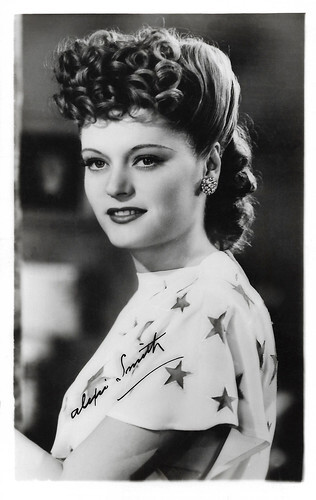
American postcard by EKC. Photo: Warner Bros.
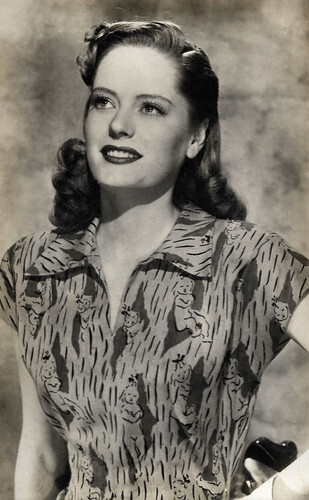
Spanish postcard by C.M.B., no. 106. Photo: Warner Bros.
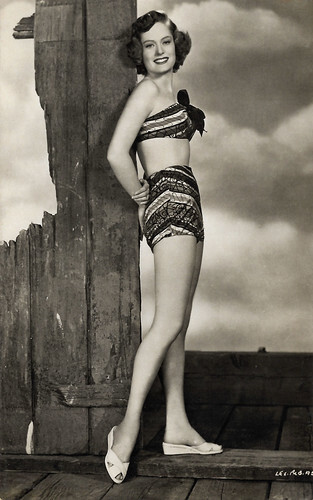
Vintage postcard. Photo: Warner Bros.
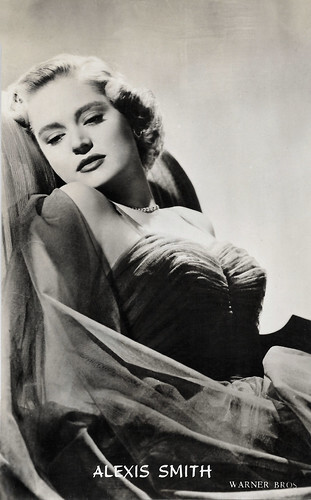
Vintage postcard. Photo: Warner Bros.
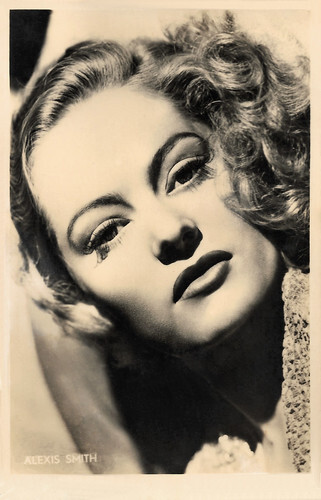
Dutch postcard by J.S.A. Photo: Warner Bros. / M.P.E.
A sabbatical from the screen
While Alexis Smith claimed in later years to have typecast herself during her Hollywood heydays, and that few of her assigned roles ever challenged her on any level, she frequently enjoyed good critical reviews for many of her performances. She was also popular with directors and film crews, who appreciated her relaxed, professional manner on the set.
Smith had little to do in Here Comes the Groom (Frank Capra, 1951) and The Turning Point (William Dieterle, 1952) and her best part in the 1950s, though small, was that of Carol Wharton in The Young Philadelphians (Vincent Sherman, 1959).
During the 1960s Alexis took a sabbatical from the screen to appear on stage with her husband, actor Craig Stevens (her marriage, a rare Hollywood success, lasted 49 years) in 'Critic's Choice', 'Cactus Flower' and 'Mary, Mary'. She reserved her best acting for the stage, becoming the Tony Award-winning star of Stephen Sondheim's musical 'Follies', in which she played Phyllis during the 1971 run on Broadway and at the Shubert Theatre in Los Angeles in 1972.
In 1973 she played Sylvia Fowler in a revival of Clare Boothe Luce's 'The Women' and was nominated for another Tony for her leading role of Lila Halliday in 'Platinum' in 1979. On television Alexis was seen infrequently from the mid-1950s, sometimes appearing on the same show opposite her husband. She had a recurring role as the homicidal Lady Jessica Montfort in Dallas during the 1984 and 1990 seasons and was nominated for an Emmy for a guest-starring role on Cheers (1982).
Outside the US, she appeared in the French-Canadian thriller The Little Girl Who Lives Down the Lane (Nicholas Gessner, 1976) with Jodie Foster , and in the French film La truite (Joseph Losey, 1982), starring Isabelle Huppert . In her last film, The Age of Innocence (Martin Scorsese, 1993), she was cast as a New York socialite, a type of character she had portrayed frequently in her heyday at Warners. Alexis Smith died in 1993 in Los Angeles of brain cancer.
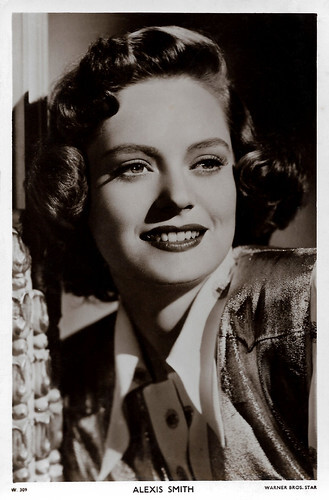
British postcard in the Picturegoer Series, London, no. W 309. Photo: Warner Bros.
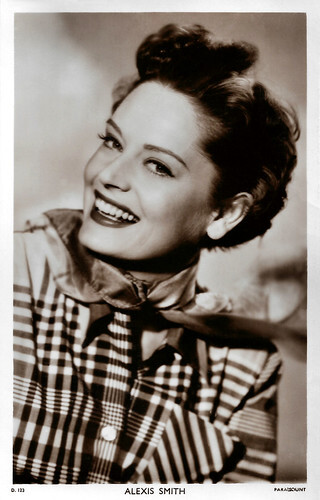
British postcard in the Picturegoer Series, London, no. D 123. Photo: Paramount.
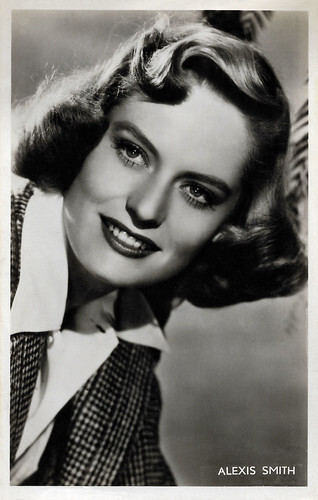
Dutch postcard by J. Sleding N.V., Amsterdam, no. 17 fL. Photo: Warner Bros.
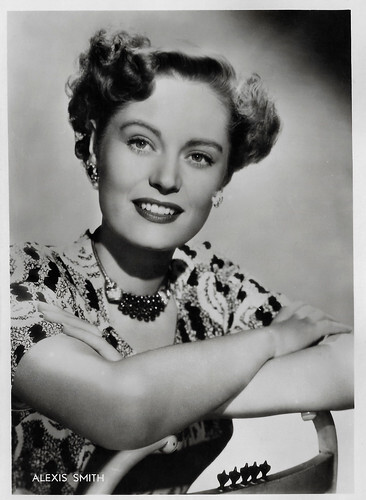
Dutch postcard by P.F. Claddér, Amsterdam, no. 4C-14. Photo: Warner Bros.
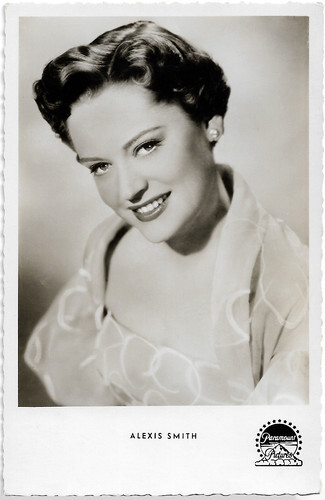
West German postcard by Kunst und Bild, Berlin W., no. A 362. Photo: Paramount. Alexis Smith in Here Comes the Groom (Frank Capra, 1951).
Sources: (IMDb), Wikipedia and .

West German postcard by Rüdel-Verlag, Hamburg-Bergedorf, no. 810. Photo: Warner Bros.

Spanish postcard, no. 1260. Photo: Warner Bros. Alexis Smith and Humphrey Bogart in The Two Mrs. Carrolls (Peter Godfrey, 1947).

Italian postcard by Bromofoto, Milano, no. 296. Photo: Universal International. Alexis Smith in Undercover Girl (Joseph Pevney, 1950).

Small German collectors card in the series E - Filmstars der Welt 2. Band by Greilings-sammelbilder, no. 164. Photo: Hamann-Meyerpress.
The mould of the other woman
Alexis Smith was born Gladys Smith in 1921 in Penticton, British Columbia, Canada. After her family moved to California, she grew into a precocious talent, performing ballet in public by the age of thirteen, dancing to 'Carmen' at the Hollywood Bowl. She later graduated with a degree in drama from Los Angeles City College, having previously won an acting contest whilst still in high school.
During a performance of a play on campus, she was spotted by a Warner Brothers talent scout and signed a contract in 1941. Her earliest film roles were uncredited bit parts, and it took several years for her career to gain momentum. Much to her chagrin, the studio's publicity department touted Alexis as the 'Dynamite Girl'. Her first credited role was in the feature film Dive Bomber (Michael Curtiz, 1941), playing the female lead opposite Errol Flynn .
She would make a total of four films with Flynn including the boxing drama Gentleman Jim (Raoul Walsh, 1942) and the Western San Antonio (David Butler, 1945). Though decidedly second fiddle to the action and the charismatic Flynn, Alexis made a good first impression as the fetching romantic interest. She appeared with her future husband, Craig Stevens, in the comedy Steel Against the Sky (A. Edward Sutherland, 1941).
Her appearance in The Constant Nymph (Edmund Goulding, 1943) opposite Charles Boyer , was described by a reviewer as an "intelligent rendition". It led to bigger parts. Her biggest hit of the mid-1940s was as Cole Porter's wife in the inaccurate but hugely successful biopic Night and Day (Michael Curtiz, 1946), starring Cary Grant . Until the early 1950s, she was paired with the top male stars in Hollywood.
She appeared in two Film Noirs with Humphrey Bogart at his most menacing: the interesting and underrated Conflict (Curtis Bernhardt, 1945) and the excellent The Two Mrs. Carrolls (Peter Godfrey, 1947). As Clark Gable 's wife in the gambling drama Any Number Can Play (Mervyn LeRoy, 1949), she was critically lauded as "genuinely appealing". In between there were also some conspicuous failures, particularly her somewhat stolid performance in the period drama The Woman in White (Peter Godfrey, 1948). Stylishly attired by costume designers like Milo Anderson and Helen Rose in the most glamorous gowns, Smith also proved to be a capable and spirited actress, despite relatively few opportunities to break out of the mould of 'the other woman'.

American postcard by EKC. Photo: Warner Bros.

Spanish postcard by C.M.B., no. 106. Photo: Warner Bros.

Vintage postcard. Photo: Warner Bros.

Vintage postcard. Photo: Warner Bros.

Dutch postcard by J.S.A. Photo: Warner Bros. / M.P.E.
A sabbatical from the screen
While Alexis Smith claimed in later years to have typecast herself during her Hollywood heydays, and that few of her assigned roles ever challenged her on any level, she frequently enjoyed good critical reviews for many of her performances. She was also popular with directors and film crews, who appreciated her relaxed, professional manner on the set.
Smith had little to do in Here Comes the Groom (Frank Capra, 1951) and The Turning Point (William Dieterle, 1952) and her best part in the 1950s, though small, was that of Carol Wharton in The Young Philadelphians (Vincent Sherman, 1959).
During the 1960s Alexis took a sabbatical from the screen to appear on stage with her husband, actor Craig Stevens (her marriage, a rare Hollywood success, lasted 49 years) in 'Critic's Choice', 'Cactus Flower' and 'Mary, Mary'. She reserved her best acting for the stage, becoming the Tony Award-winning star of Stephen Sondheim's musical 'Follies', in which she played Phyllis during the 1971 run on Broadway and at the Shubert Theatre in Los Angeles in 1972.
In 1973 she played Sylvia Fowler in a revival of Clare Boothe Luce's 'The Women' and was nominated for another Tony for her leading role of Lila Halliday in 'Platinum' in 1979. On television Alexis was seen infrequently from the mid-1950s, sometimes appearing on the same show opposite her husband. She had a recurring role as the homicidal Lady Jessica Montfort in Dallas during the 1984 and 1990 seasons and was nominated for an Emmy for a guest-starring role on Cheers (1982).
Outside the US, she appeared in the French-Canadian thriller The Little Girl Who Lives Down the Lane (Nicholas Gessner, 1976) with Jodie Foster , and in the French film La truite (Joseph Losey, 1982), starring Isabelle Huppert . In her last film, The Age of Innocence (Martin Scorsese, 1993), she was cast as a New York socialite, a type of character she had portrayed frequently in her heyday at Warners. Alexis Smith died in 1993 in Los Angeles of brain cancer.

British postcard in the Picturegoer Series, London, no. W 309. Photo: Warner Bros.

British postcard in the Picturegoer Series, London, no. D 123. Photo: Paramount.

Dutch postcard by J. Sleding N.V., Amsterdam, no. 17 fL. Photo: Warner Bros.

Dutch postcard by P.F. Claddér, Amsterdam, no. 4C-14. Photo: Warner Bros.

West German postcard by Kunst und Bild, Berlin W., no. A 362. Photo: Paramount. Alexis Smith in Here Comes the Groom (Frank Capra, 1951).
Sources: (IMDb), Wikipedia and .
Published on December 16, 2023 22:00
Paul van Yperen's Blog
- Paul van Yperen's profile
- 13 followers
Paul van Yperen isn't a Goodreads Author
(yet),
but they
do have a blog,
so here are some recent posts imported from
their feed.



